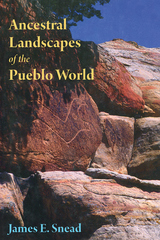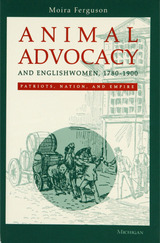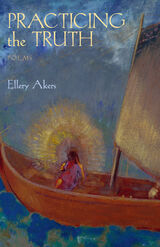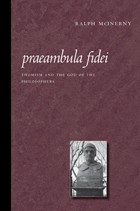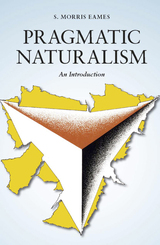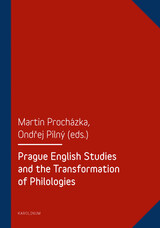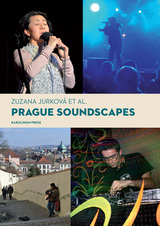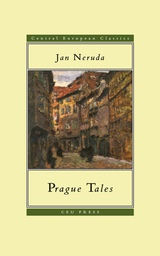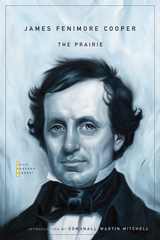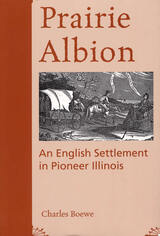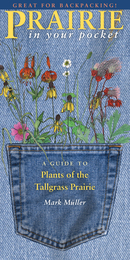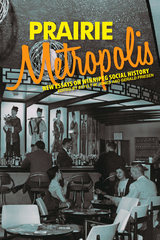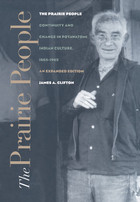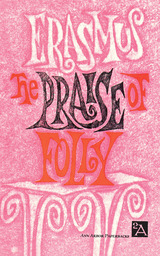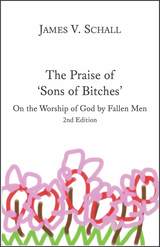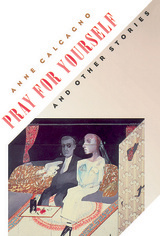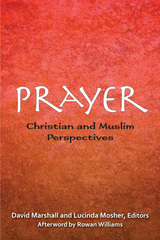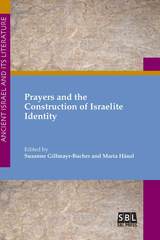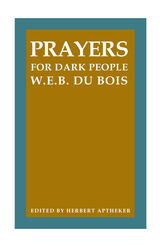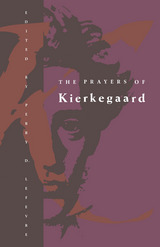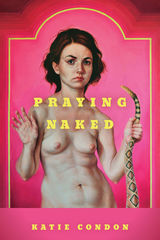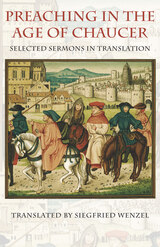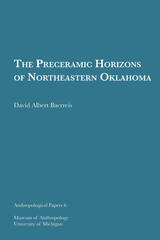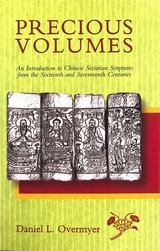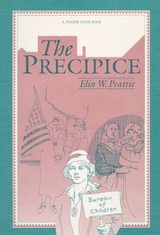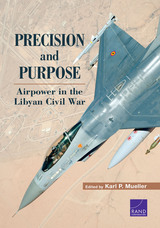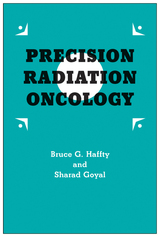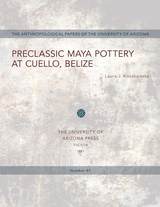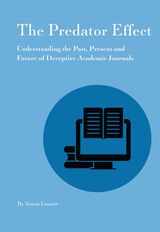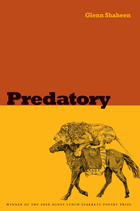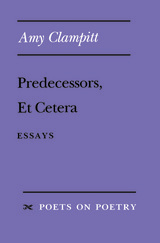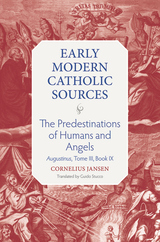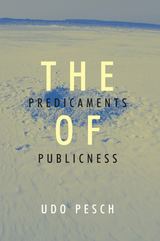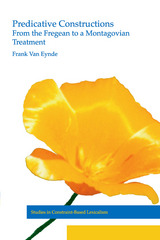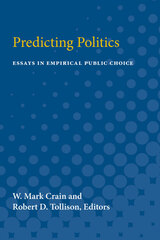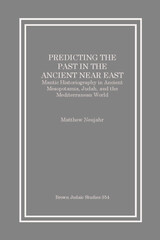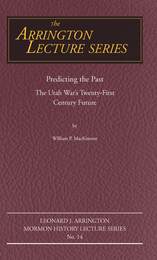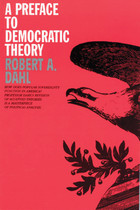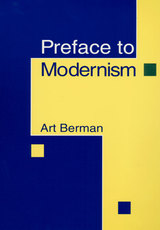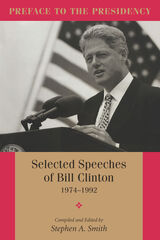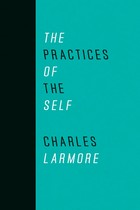 The Practices of the Self
Charles Larmore
University of Chicago Press, 2010 What is the nature of the fundamental relation we have to ourselves that makes each of us a self? To answer this question, Charles Larmore develops a systematic theory of the self, challenging the widespread view that the self’s defining relation to itself is to have an immediate knowledge of its own thoughts. On the contrary, Larmore maintains, our essential relation to ourselves is practical, as is clear when we consider the nature of belief and desire. For to believe or desire something consists in committing ourselves to thinking and acting in accord with the presumed truth of our belief or the presumed value of what we desire.
Larmore develops this conception with frequent reference to such classic authors as Montaigne, Stendhal, and Proust and by comparing it to other views of the self in contemporary philosophy. He also discusses the important ethical consequences of his theory of the self, arguing that it allows us to better grasp what it means to be ourselves and why self-understanding often involves self-creation.
Winner of the Académie Française’s Grand Prix de Philosophie, The Practices of the Self is that rare kind of lucid yet rigorous work that transcends disciplinary boundaries.
 Practices of the Sentimental Imagination: Melodrama, the Novel, and the Social Imaginary in Nineteenth-Century Japan
Jonathan E. Zwicker
Harvard University Press, 2006 The history of the book in nineteenth-century Japan follows an uneven course that resists the simple chronology often used to mark the divide between premodern and modern literary history.
By examining the obscured histories of publication, circulation, and reception of widely consumed literary works from late Edo to the early Meiji period, Jonathan Zwicker traces a genealogy of the literary field across a long nineteenth century: one that stresses continuities between the generic conventions of early modern fiction and the modern novel. In the literature of sentiment Zwicker locates a tear-streaked lens through which to view literary practices and readerly expectations that evolved across the century.
Practices of the Sentimental Imagination emphasizes both qualitative and quantitative aspects of literary production and consumption, balancing close readings of canonical and noncanonical texts, sophisticated applications of critical theory, and careful archival research into the holdings of nineteenth-century lending libraries and private collections. By exploring the relationships between and among Japanese literary works and texts from late imperial China, Europe, and America, Zwicker also situates the Japanese novel within a larger literary history of the novel across the global nineteenth century.
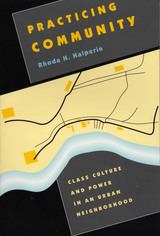 Practicing Community: Class Culture and Power in an Urban Neighborhood
By Rhoda H. Halperin
University of Texas Press, 1998 Cincinnati's East End river community has been home to generations of working-class people. This racially mixed community has roots that reach back as far as seven generations. But the community is vulnerable. Developers bulldoze "raggedy" but affordable housing to build upscale condos, even as East Enders fight to preserve the community by participating in urban development planning controlled by powerful outsiders. This book portrays how East Enders practice the preservation of community. Drawing on more than six years of anthropological research and advocacy in the East End, Rhoda Halperin argues for redefining community not merely as a place, but as a set of culturally embedded and class-marked practices that give priority to caring for children and the elderly, procuring livelihood, and providing support for family, friends, and neighbors. These practices create the structures of community within the larger urban power structure. Halperin uses different genres to weave the voices of East Enders throughout the book. Poems and narratives offer poignant insights into the daily struggles against impersonal market forces that work against the struggle for livelihood. This firsthand account questions commonly held assumptions about working-class people. In a fresh way, it reveals the cultural construction of marginality, from the viewpoints of both "real East Enders" and the urban power structure.
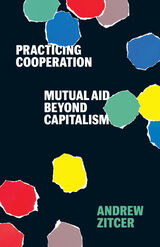 Practicing Cooperation: Mutual Aid beyond Capitalism
Andrew Zitcer
University of Minnesota Press, 2021 A powerful new understanding of cooperation as an antidote to alienation and inequality
From the crises of racial inequity and capitalism that inspired the Black Lives Matter movement and the Green New Deal to the coronavirus pandemic, stories of mutual aid have shown that, though cooperation is variegated and ever changing, it is also a form of economic solidarity that can help weather contemporary social and economic crises. Addressing this theme, Practicing Cooperation delivers a trenchant and timely argument that the way to a more just and equitable society lies in the widespread adoption of cooperative practices. But what renders cooperation ethical, effective, and sustainable? Providing a new conceptual framework for cooperation as a form of social practice, Practicing Cooperation describes and critiques three U.S.-based cooperatives: a pair of co-op grocers in Philadelphia, each adjusting to recent growth and renewal; a federation of two hundred low-cost community acupuncture clinics throughout the United States, banded together as a cooperative of practitioners and patients; and a collectively managed Philadelphia experimental dance company, founded in the early 1990s and still going strong. Through these case studies, Andrew Zitcer illuminates the range of activities that make contemporary cooperatives successful: dedicated practitioners, a commitment to inclusion, and ongoing critical reflection. In so doing he asserts that economic and social cooperation must be examined, critiqued, and implemented on multiple scales if it is to combat the pervasiveness of competitive individualism. Practicing Cooperation is grounded in the voices of practitioners and the result is a clear-eyed look at the lived experience of cooperators from different parts of the economy and a guidebook for people on the potential of this way of life for the pursuit of justice and fairness.
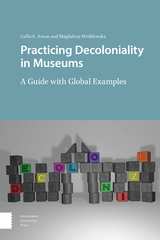 Practicing Decoloniality in Museums: A Guide with Global Examples
Csilla Ariese
Amsterdam University Press, 2022 The cry for decolonization has echoed throughout the museum world. Although perhaps most audibly heard in the case of ethnographic museums, many different types of museums have felt the need to engage in decolonial practices. Amidst those who have argued that an institution as deeply colonial as the museum cannot truly be decolonized, museum staff and museologists have been approaching the issue from different angles to practice decoloniality in any way they can. Practicing Decoloniality in Museums: A Guide with Global Examples collects a wide range of practices from museums whose audiences, often highly diverse, come together in sometimes contentious conversations about pasts and futures. Although there are no easy or uniform answers as to how best to deal with colonial pasts, this collection of practices functions as an accessible toolkit from which museum staff can choose in order to experiment with and implement methods according to their own needs and situations. The practices are divided thematically and include, among others, methods for decentering, improving transparency, and increasing inclusivity.
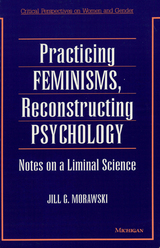 Practicing Feminisms, Reconstructing Psychology: Notes on a Liminal Science
Jill Morawski
University of Michigan Press, 1994 Practicing Feminisms, Reconstructing Psychology is a valuable survey of developments to date in feminist psychology and a provocative assessment of its future possibilities. For many psychologists engaged with the questions raised by modern feminist, the reconciliation of scientific methods and feminist commitments has been a complicated and sometimes perplexing project. In her book, Jill Morawski attempts to move beyond the apparent impasses toward a constructive feminist psychology. The book assesses the substantive advances feminist psychology has made and proposes ways in which those transformations can lead to new research and methodologies. These transformative interventions, Morawski argues, have often consisted of local and partial alterations to established methods rather than a programmatic "metatheory" or a formulaic methodology. She reviews a variety of exemplary studies that demonstrate how such intermittent practices, taken together, constitute a groundword for radically new forms of psychological inquiry. The study describes feminist challenges to long-held conceptions of objectivity, subjectivity, and validity and examines emergent problems and ongoing debates. The feminist innovations discussed reveal the impossibility of a pure and abstract objective stance and demonstrate the feasibility of situated and critical objective practices. Morawski also shows how experimental investigative strategies are generating new perspectives on subjectivity, which incorporate agency as well as dependence, reflection as well as reactivity. Feminist inquiry is modifying the procedures through which knowledge is warranted, with different evaluations of validation processes. Despite the transformations in these areas, the pursuit of a feminist psychology remains in transition, in a "liminal" space. Among the emerging issues Morawski explores are vicissitudes of reflexivity, the investigator's self, and the cultural bases of psychological knowledge.
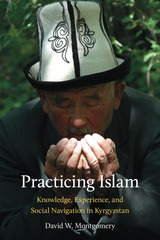 Practicing Islam: Knowledge, Experience, and Social Navigation in Kyrgyzstan
David W. Montgomery
University of Pittsburgh Press, 2016 David W. Montgomery presents a rich ethnographic study on the practice and meaning of Islamic life in Kyrgyzstan. As he shows, becoming and being a Muslim are based on knowledge acquired from the surrounding environment, enabled through the practice of doing. Through these acts, Islam is imbued in both the individual and the community. To Montgomery, religious practice and lived experience combine to create an ideological space that is shaped by events, opportunities, and potentialities that form the context from which knowing emerges. This acquired knowledge further frames social navigation and political negotiation.
Through his years of on-the-ground research, Montgomery assembles both an anthropology of knowledge and an anthropology of Islam, demonstrating how individuals make sense of and draw meanings from their environments. He reveals subtle individual interpretations of the religion and how people seek to define themselves and their lives as “good” within their communities and under Islam.
Based on numerous in-depth interviews, bolstered by extensive survey and data collection, Montgomery offers the most thorough English-language study to date of Islam in post-Soviet Kyrgyzstan. His work provides a broad view into the cognitive processes of Central Asian populations that will serve students, researchers, and policymakers alike.
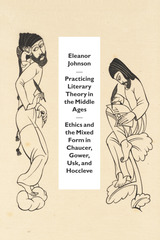 Practicing Literary Theory in the Middle Ages: Ethics and the Mixed Form in Chaucer, Gower, Usk, and Hoccleve
Eleanor Johnson
University of Chicago Press, 2013 Literary scholars often avoid the category of the aesthetic in discussions of ethics, believing that purely aesthetic judgments can vitiate analyses of a literary work’s sociopolitical heft and meaning. In Practicing Literary Theory in the Middle Ages, Eleanor Johnson reveals that aesthetics—the formal aspects of literary language that make it sense-perceptible—are indeed inextricable from ethics in the writing of medieval literature. Johnson brings a keen formalist eye to bear on the prosimetric form: the mixing of prose with lyrical poetry. This form descends from the writings of the sixth-century Christian philosopher Boethius—specifically his famous prison text, Consolation of Philosophy—to the late medieval English tradition. Johnson argues that Boethius’s text had a broad influence not simply on the thematic and philosophical content of subsequent literary writing, but also on the specific aesthetic construction of several vernacular traditions. She demonstrates the underlying prosimetric structures in a variety of Middle English texts—including Chaucer’s Troilus and Criseyde and portions of the Canterbury Tales, Thomas Usk’s Testament of Love, John Gower’s Confessio amantis, and Thomas Hoccleve’s autobiographical poetry—and asks how particular formal choices work, how they resonate with medieval literary-theoretical ideas, and how particular poems and prose works mediate the tricky business of modeling ethical transformation for a readership.
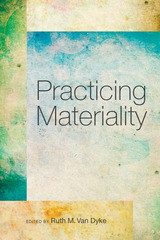 Practicing Materiality
Edited by Ruth M. Van Dyke
University of Arizona Press, 2015 It is little wonder that relationships between things and humans are front-and-center in the contemporary social sciences, given the presence of technologies in every conceivable aspect of our lives. From Bruno Latour to Ian Hodder, anthropologists and archaeologists are embracing “thing theory” and the “ontological turn.” In Practicing Materiality, Ruth M. Van Dyke cautions that as anthropologists turn toward animals and things, they run the risk of turning away from people and intentional actions.
Practicing Materiality focuses on the practical job of applying materiality to anthropological investigations, but with the firm retention of anthropocentrism. The philosophical discussions that run through the nine chapters develop practical applications for material studies, including Heideggerian phenomenology, Gellian secondary agency, object life histories, and bundling. Seven case studies are flanked by an introduction and a discussion chapter. The case studies represent a wide range of archaeological and anthropological contexts, from contemporary New York City and Turkey to fifteenth-century Portugal, the ancient southwest United States, and the ancient Andes. Authors in every chapter argue for the rejection of subject/object dualism, regarding material things as actively involved in the negotiation of power within human social relationships. Practicing Materiality demonstrates that it is possible to focus on the entangled lives of things without losing sight of their political and social implications.
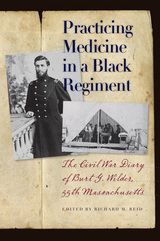 Practicing Medicine in a Black Regiment: The Civil War Diary of Burt G. Wilder, 55th Massachusetts
Richard M. Reid
University of Massachusetts Press, 2010 In early 1863, in the aftermath of Abraham Lincoln's Emancipation Proclamation, Massachusetts began recruiting black soldiers to serve in the Civil War. Although the first regiment formed, the 54th Massachusetts, would become the best-known black regiment in the war, the second regiment raised, the 55th Massachusetts Volunteer Infantry, performed equally valuable service in the Union Army.
Burt Green Wilder, a Boston-born, Harvard-educated doctor-in-training, was among the first white officers commissioned to staff the 55th Massachusetts. Like other officers serving in the state's African American units, Wilder was selected for his military experience, his "firm Anti-Slavery principles," and his faith in the value of black troops. From the time he joined the 55th in May 1863 until the regiment was discharged in September 1865, Wilder recorded his experiences and observations. He described the day-to-day activities of a Civil War surgeon, the indignities suffered by black enlisted men at the hands of a War Department that denied them the same treatment offered to white troops, and the role of the regiment in the campaign around Charleston and in Florida.
Service in the southern states also allowed Wilder to indulge a passion for natural science and comparative anatomy, including the collection of unusual species, one of which—the spider known as Nephila wilderi—still bears his name. After the war he completed his medical studies at Harvard and joined the faculty of Cornell University, where he became a distinguished professor of zoology as well as an outspoken advocate of racial equality.
In his introduction to the volume, Richard M. Reid analyzes Burt Wilder's diary and places it within the context of the war, the experience of African American troops, and Wilder's life and career.
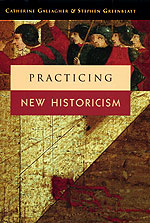 Practicing New Historicism
Catherine Gallagher and Stephen Greenblatt
University of Chicago Press, 2000 For almost twenty years, new historicism has been a highly controversial and influential force in literary and cultural studies. In Practicing the New Historicism, two of its most distinguished practitioners reflect on its surprisingly disparate sources and far-reaching effects.
In lucid and jargon-free prose, Catherine Gallagher and Stephen Greenblatt focus on five central aspects of new historicism: recurrent use of anecdotes, preoccupation with the nature of representations, fascination with the history of the body, sharp focus on neglected details, and skeptical analysis of ideology. Arguing that new historicism has always been more a passionately engaged practice of questioning and analysis than an abstract theory, Gallagher and Greenblatt demonstrate this practice in a series of characteristically dazzling readings of works ranging from paintings by Joos van Gent and Paolo Uccello to Hamlet and Great Expectations.
By juxtaposing analyses of Renaissance and nineteenth-century topics, the authors uncover a number of unexpected contrasts and connections between the two periods. Are aspects of the dispute over the Roman Catholic doctrine of the Eucharist detectable in British political economists' hostility to the potato? How does Pip's isolation in Great Expectations shed light on Hamlet's doubt?
Offering not only an insider's view of new historicism, but also a lively dialogue between a Renaissance scholar and a Victorianist, Practicing the New Historicism is an illuminating and unpredictable performance by two of America's most respected literary scholars.
"Gallagher and Greenblatt offer a brilliant introduction to new historicism. In their hands, difficult ideas become coherent and accessible."—Choice
"A tour de force of new literary criticism. . . . Gallagher and Greenblatt's virtuoso readings of paintings, potatoes (yes, spuds), religious ritual, and novels—all 'texts'—as well as essays on criticism and the significance of anecdotes, are likely to take their place as model examples of the qualities of the new critical school that they lead. . . . A zesty work for those already initiated into the incestuous world of contemporary literary criticism-and for those who might like to see what all the fuss is about."—Kirkus Reviews, starred review
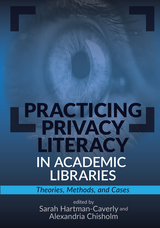 Practicing Privacy Literacy in Academic Libraries: Theories, Methods, and Cases
Sarah Hartman-Caverly
Association of College & Research Libraries, 2023 Privacy is not dead: Students care deeply about their privacy and the rights it safeguards. They need a way to articulate their concerns and guidance on how to act within the complexity of our current information ecosystem and culture of surveillance capitalism. Practicing Privacy Literacy in Academic Libraries: Theories, Methods, and Cases can help you teach privacy literacy, evolve the privacy practices at your institution, and re-center the individuals behind the data and the ethics behind library work. Divided into four sections: - What is Privacy Literacy?
- Protecting Privacy
- Educating about Privacy
- Advocating for Privacy
Chapters cover topics including privacy literacy frameworks; digital wellness; embedding a privacy review into digital library workflows; using privacy literacy to challenge price discrimination; privacy pedagogy; and promoting privacy literacy and positive digital citizenship through credit-bearing courses, co-curricular partnerships, and faculty development and continuing education initiatives. Practicing Privacy Literacy in Academic Libraries provides theory-informed, practical ways to incorporate privacy literacy into library instruction and other areas of academic library practice.
 Practicing Scripture: A Lay Buddhist Movement in Late Imperial China
Barend ter Haar
University of Hawaii Press, 2014 Practicing Scripture is an original and detailed history of one of the most successful religious movements of late imperial China, the Non-Action Teachings, or Wuweijiao, from its beginnings in the late sixteenth century in the prefectures of southern Zhejiang to the middle of the twentieth century, when communist repression dealt it a crippling blow. Uncovering important data on its beliefs and practices, Barend ter Haar paints a wholly new picture of the group, which, despite its Daoist-sounding name, was a deeply devout lay Buddhist movement whose adherents rejected the worship of statues and ancestors while venerating the writings of Patriarch Luo (fl. early sixteenth century), a soldier-turned-lay-Buddhist. The texts, written in vernacular Chinese and known as the Five Books in Six Volumes, mix personal experiences, religious views, and a wealth of quotations from the Buddhist canon.
Ter Haar convincingly demonstrates that the Non-Action Teachings was not messianic or millenarian in orientation and had nothing to do with other new religious groups and networks traditionally labelled as White Lotus Teachings. It combined Chan and Pure Land practices with a strong self-identity and vegetarianism and actively insisted on the right of free practice. Members of the movement created a foundation myth in which Ming (1368–1644) emperor Zhengde bestowed the right upon their mythical forefather. In addition, they produced an imperial proclamation whereby Emperor Kangxi of the Qing (1645–1911) granted the group similar privileges.
Thanks to its expert handling of a great number and variety of extant sources, Practicing Scripture depicts one of the few lay movements in traditional China that can be understood in some depth, both in terms of its religious content and history and its social environment. The work will be welcomed by China specialists in religious and Buddhist studies and social history.
Practicing the Truth
Ellery Akers
Autumn House Press, 2015 Winner of the 2014 Autumn House Press Poetry Contest, selected by Alicia Ostriker. Akers' collection of lyric poems celebrates our everyday world while not glossing over the pain suffered by those who inhabit it. These beautifully crafted, quiet poems are simultaneously powerful to read.
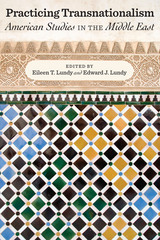 Practicing Transnationalism: American Studies in the Middle East
Edited Eileen T. Lundy and Edward J. Lundy
University of Texas Press, 2016 Practicing Transnationalism explores the challenges of teaching American studies in the Middle East during a time of tension and conflict between the United States and the region. In the first decade of the twenty-first century, American studies programs began to spread in the Middle East. During a time of rising anti-American sentiment, ten major programs were established in the region. What impulses propelled universities in the Middle East to establish these centers and programs? What motivated students to take courses and pursue degrees in American studies? In part, American studies programs developed as a way to “know the enemy,” to better understand America’s ubiquitous influence in foreign relations, technology, and culture; however, some programs grew because residents admired the ideals set forth as American, including democracy and free speech. Practicing Transnationalism investigates these issues and others, using the experiences and research of the editors and contributors, who worked either directly in these programs or as adjunct to them. These scholars seek to understand what American power means to people in the Middle East. They examine the challenge of developing American studies programs in a transnational paradigm, striving to build programs that are separate from and critical of American imperialism without simply becoming anti-American. In the essays, the contributors provide context for how the field of American studies has grown and developed, and they offer views of cultural interactions and classroom situations, demonstrating the problems instructors faced and how they worked to address them.
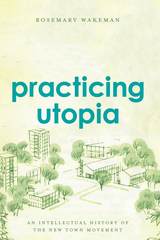 Practicing Utopia: An Intellectual History of the New Town Movement
Rosemary Wakeman
University of Chicago Press, 2016 The typical town springs up around a natural resource—a river, an ocean, an exceptionally deep harbor—or in proximity to a larger, already thriving town. Not so with “new towns,” which are created by decree rather than out of necessity and are often intended to break from the tendencies of past development. New towns aren’t a new thing—ancient Phoenicians named their colonies Qart Hadasht, or New City—but these utopian developments saw a resurgence in the twentieth century.
In Practicing Utopia, Rosemary Wakeman gives us a sweeping view of the new town movement as a global phenomenon. From Tapiola in Finland to Islamabad in Pakistan, Cergy-Pontoise in France to Irvine in California, Wakeman unspools a masterly account of the golden age of new towns, exploring their utopian qualities and investigating what these towns can tell us about contemporary modernization and urban planning. She presents the new town movement as something truly global, defying a Cold War East-West dichotomy or the north-south polarization of rich and poor countries. Wherever these new towns were located, whatever their size, whether famous or forgotten, they shared a utopian lineage and conception that, in each case, reveals how residents and planners imagined their ideal urban future.
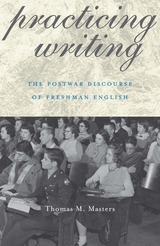 Practicing Writing: Postwar Discourse Of Freshman English
Thomas M. Masters
University of Pittsburgh Press, 2004
Practicing Writing examines a pivotal era in the history of the most ubiquitous-and possibly most problematic-course in North American colleges and universities: the requireAd first-year writing course generally known as “freshman English.”
Thomas Masters's focus is the mid-twentieth century, beginning with the returning waves of World War II veterans attending college on the GI Bill. He then traces the education reforms that took place in the late 1950s after the launch of Sputnik and the establishment of composition as a separate discipline in 1963. This study draws upon archives at three midwestern schools that reflect a range of higher education options: Wheaton, a small, sectarian liberal arts college; Northwestern, a large private university; and Illinois, a large public university.
Practicing Writing gives voice to those whose work is often taken for granted or forgotten in other studies of the subject: freshman English students and their instructors. Masters examines students' papers, professors' letters, and course descriptions, and draws upon interviews conducted with teachers to present the practitioners' points of view.
Unlike other studies of the subject, which have tended to focus more on the philosophy, theory, and ideology of teaching composition and rhetoric, Masters reveals freshman English to be a practice-based phenomenon with a durable ideological apparatus. By reexamining texts that had previously been considered insignificant, he reveals the substance of first-year composition courses and the reasons for their durability.
Practising the Real on the Contemporary Stage
José Antonio Sánchez
Intellect Books, 2014 An analysis of reality and "the real" as presented in contemporary artistic creation, Practising the Real on the Contemporary Stage examines the responses given by performing arts to the importance placed on reality beyond representation. This book proposes four historic itineraries defined by the ways in which the issue of the real is addressed: the representation of visible reality and its paradoxes, the place of the real on the lived body, the limits placed on representation by experiences of pain and death, and those practices that denounce the real. Practising the Real on the Contemporary Stage will be warmly welcomed by scholars of aesthetics and contemporary artistic practice.
 A Practitioner's Guide to Freshwater Biodiversity Conservation
Edited by Nicole Silk and Kristine Ciruna
Island Press, 2006 A Practitioner's Guide to Freshwater Biodiversity Conservation brings together knowledge and experience from conservation practitioners and experts around the world to help readers understand the global challenge of conserving biodiversity in freshwater ecosystems. More importantly, it offers specific strategies and suggestions for managers to use in establishing new conservation initiatives or improving the effectiveness of existing initiatives. The book: offers an understanding of fundamental issues by explaining how ecosystems are structured and how they support biodiversity; provides specific information and approaches for identifying areas most in need of protection; examines promising strategies that can help reduce biodiversity loss; and describes design considerations and methods for measuring success within an adaptive management framework. The book draws on experience and knowledge gained during a five-year project of The Nature Conservancy known as the Freshwater Initiative, which brought together a range of practitioners to create a learning laboratory for testing ideas, approaches, tools, strategies, and methods. For professionals involved with land or water management-including state and federal agency staff, scientists and researchers working with conservation organizations, students and faculty involved with freshwater issues or biodiversity conservation, and policymakers concerned with environmental issues-the book represents an important new source of information, ideas, and approaches.
 Practitioners of the Divine: Greek Priests and Religious Officials from Homer to Heliodorus
Beate Dignas and Kai Trampedach
Harvard University Press, 2008 “What is a Greek priest?” The volume, which has its origins in a symposium held at the Center for Hellenic Studies in Washington, D.C., focuses on the question through a variety of lenses: the visual representation of cult personnel, priests as ritual experts, variations of priesthood, ideal concepts and their transformation, and the role of manteis. Each chapter looks at how priests and religious officials used a potential authority to promote themselves and their posts, how they played a role in conserving, shaping and reviving cult activity, how they acted behind the curtain of polis institutions, and how they performed as mediators between men and gods. It becomes clear that Greek priests had many faces, and that the factors that determined their roles and activities are political as well as historical, religious as well as economic, idealistic as well as pragmatic, personal as well as communal.
Praeambula Fidei: Thomism and the God of the Philosophers
Ralph McInerny
Catholic University of America Press, 2006 In this book, renowned philosopher Ralph McInerny sets out to review what Thomas meant by the phrase and to defend a robust understanding of Thomas's teaching on the subject.
A Pragmatic Alliance: Jewish-Lithuanian political cooperation at the beginning of the 20th century
Vladas Sirutavicius
Central European University Press, 2011 Discusses the political cooperation between Jews and Lithuanians in the Tsarist Empire from the last decades of the 19th century until the early 1920s. These years saw the transformation of both Jewish and Lithuanian political life. Within the Jewish community, the previously dominant integrationists were now challenged both by those who believed that the Jews were not a religious but an ethnic or proto-nationalist group and those who believed that only with the abolition of capitalism and the establishment of a socialist state would Jewish integration be possible. Among the Lithuanians, the emergence of a modern national identity became increasingly prevalent.
Pragmatic Liberalism
Charles W. Anderson
University of Chicago Press, 1990 Drawing on the legacy of prominent pragmatic philosophers and political economists—C. S. Peirce, William James, John Dewey, Thorstein Veblen, and John R. Commons—Charles W. Anderson creatively brings pragmatism and liberalism together, striving to temper the excesses of both and to fashion a broader vision of the proper domain of political reason.
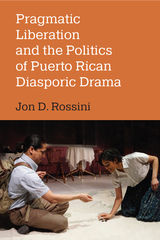 Pragmatic Liberation and the Politics of Puerto Rican Diasporic Drama
Jon D. Rossini
University of Michigan Press, 2024 Pragmatic Liberation and the Politics of Puerto Rican Diasporic Drama explores the work of a unique group of playwrights—Puerto Rican dramatists writing in the United States—who offer a model of political engagement. As members of the Puerto Rican diaspora, they have a heightened awareness of the systematic discrimination and the colonial citizenship created by Puerto Rico’s territorial status. Pragmatic Liberation analyzes the work of established playwrights as well as work that has previously received little attention in the world of theater studies, including René Marqués’s Palm Sunday. The book demonstrates the strategies these playwrights use to model a nuanced way of moving toward liberation while being sensitive to the potential impact these actions might have on those closest to us. This is a crucially important model that needs more attention in our currently polarized political moment.
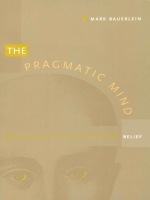 The Pragmatic Mind: Explorations in the Psychology of Belief
Mark Bauerlein
Duke University Press, 1997 The Pragmatic Mind is a study of the pragmatism of Emerson, James, and Peirce and its overlooked relevance for the neopragmatism of thinkers like Richard Rorty, Stanley Cavell, Stanley Fish, and Cornel West. Arguing that the "original" pragmatists are too-often cited casually and imprecisely as mere precursors to this contemporary group of American intellectuals, Mark Bauerlein explores the explicit consequences of the earlier group’s work for current debates among and around the neopragmatists.
Bauerlein extracts from Emerson, James, and Peirce an intellectual focus that can be used to advance the broad social and academic reforms that the new pragmatists hail. He claims that, in an effort to repudiate the phony universalism of much contemporary theory, the new generation of theorists has ignored the fact that its visions of pragmatic action are grounded in this "old" school, not just in a way of doing things but also in a way of thinking about things. In other words, despite its inclination to regard psychological questions as irrelevant, Bauerlein shows that the pragmatic method demands a pragmatic mind—that is, a concept of cognition, judgment, habit, and belief. He shows that, in fact, such a concept of mind does exist, in the work of the "old" pragmatists.
Pragmatic Naturalism: An Introduction
S. Morris Eames
Southern Illinois University Press, 1977 It is said that America came of age intellectually with the appearance of the pragmatic movement in philosophy. Pragmatic Naturalism presents a selective and interpretative overview of this philosophy as developed in the writings of its intellectual founders and chief exponents—Charles Sanders Peirce, William James, George Herbert Mead, and John Dewey. Mr. Eames groups the leading ideas of these pragmatic naturalists around the general fields of “Nature and Human Life,” “Knowledge,” “Value,” and “Education,” treating the primary concerns and special emphasis of each philosopher to these issues. Philosophy students, teachers of philosophy, and general readers will find this book a comprehensive overview of American philosophy.
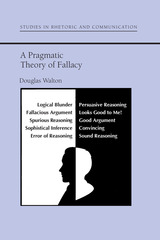 A Pragmatic Theory of Fallacy
Douglas Walton
University of Alabama Press, 1995 Takes a new analytical look at the concept of fallacy and presents an up-to-date analysis of its usefulness for argumentation studies
Although fallacies have been common since Aristotle, until recently little attention has been devoted to identifying and defining them. Furthermore, the concept of fallacy itself has lacked a sufficiently clear meaning to make it a useful tool for evaluating arguments. Douglas Walton takes a new analytical look at the concept of fallacy and presents an up-to-date analysis of its usefulness for argumentation studies. Walton uses case studies illustrating familiar arguments and tricky deceptions in everyday conversation where the charge of fallaciousness is at issue.
The numerous case studies show in concrete terms many practical aspects of how to use textual evidence to identify and analyze fallacies and to evaluate arguments as fallacious. Walton looks at how an argument is used in the context of conversation. He defines a fallacy as a conversational move, or sequence of moves, that is supposed to be an argument that contributes to the purpose of the conversation but in reality interferes with it. The view is a pragmatic one, based on the assumption that when people argue, they do so in a context of dialogue, a conventionalized normative framework that is goal-directed. Such a contextual framework is shown to be crucial in determining whether an argument has been used correctly. Walton also shows how examples of fallacies given in the logic textbooks characteristically turn out to be variants of reasonable, even if defeasible or questionable arguments, based on presumptive reasoning. This is the essence of the evaluation problem. A key thesis of the book, which must not be taken for granted as previous textbooks have so often done, is that you can spot a fallacy from how it was used in a context of dialogue. This is an innovative and even, as Walton notes, "a radical and controversial" theory of fallacy.
 Pragmatic Theory of Rhetoric
Walter H. Beale
Southern Illinois University Press, 1987 Walter H. Beale offersthe most coherent treatment of the aims and modes of discourse to be presented in more than a decade. His development of a semiotic “grammar of motives” that relates the problems of meaning in discourse both to linguistic structure and ways of constructing reality stands as a provocative new theory of rhetoric sharply focused on writing. He includes a comprehensive treatment of rhetoric, its classes and varieties, modes, and strategies. In addition, he demonstrates the importance of the purpose, substance, and social context of discourse, at a time when scholarly attention has become preoccupied with process. He fortifies and extends the Aristotelian approach to rhetoric and discourse at a time when much theory and pedagogy have yielded to modernist assumptions and methods. And finally, he develops a theoretical framework that illuminates the relationship between rhetoric, the language arts, and the human sciences in general.
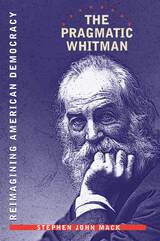 The Pragmatic Whitman: Reimaining American Democracy
Stephen John Mack
University of Iowa Press, 2002 In this surprisingly timely book, Stephen Mack examines Whitman’s particular and fascinating brand of patriotism: his far-reaching vision of democracy. For Whitman, loyalty to America was loyalty to democracy. Since the idea that democracy is not just a political process but a social and cultural process as well is associated with American pragmatism, Mack relies on the pragmatic tradition of Emerson, James, Dewey, Mead, and Rorty to demonstrate the ways in which Whitman resides in this tradition. Mack analyzes Whitman's democratic vision both in its parts and as a whole; he also describes the ways in which Whitman's vision evolved throughout his career. He argues that Whitman initially viewed democratic values such as individual liberty and democratic processes such as collective decision-making as fundamental, organic principles, free and unregulated. But throughout the 1860s and 1870s Whitman came to realize that democracy entailed processes of human agency that are more deliberate and less natural—that human destiny is largely the product of human effort, and a truly humane society can be shaped only by intelligent human efforts to govern the forces that would otherwise govern us. Mack describes the foundation of Whitman’s democracy as found in the 1855 and 1856 editions of Leaves of Grass, examines the ways in which Whitman’s 1859 sexual crisis and the Civil War transformed his democratic poetics in “Sea-Drift,” “Calamus,” Drum-Taps,and Sequel to Drum-Taps, and explores Whitman’s mature vision in Democratic Vistas, concluding with observations on its moral and political implications today. Throughout, he illuminates Whitman's great achievement—learning that a full appreciation for the complexities of human life meant understanding that liberty can take many different and conflicting forms—and allows us to contemplate the relevance of that achievement at the beginning of the twenty-first century.
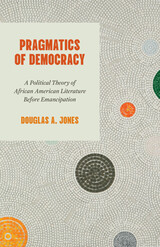 Pragmatics of Democracy: A Political Theory of African American Literature Before Emancipation
Douglas A. Jones
University of Chicago Press, 2025 This study argues early African American literature constitutes an abiding repository of modern democratic thought that is lacking in the political philosophy we normally analyze.
Douglas A. Jones’s Pragmatics of Democracy reads African American literature, from its beginnings through the mid-nineteenth century, to theorize how we have come to regard democracy as the most excellent form of political life. Jones notes that the aims of democracy, especially consent of the governed and equality under the law, can seem like tenets of governance that humans desire instinctively. But human nature does not correlate absolutely to politics. Jones argues that political selfhood is formed by “bodily events.” He proposes a typology of such experiences that dispose persons toward democratic subjectivity: ecstasy, impersonality, violence, respectability, and care.
African American literature before Emancipation reveals the democratic features of these categories that conventional political philosophy ignores or obscures. Given their lives as enslaved persons or the descendants of enslaved persons, early black writers crafted narratives about achieving democratic subjectivity that were missing in other Anglo-American canons. Pragmatics of Democracy discusses the works of well-known figures such as Phillis Wheatley, Harriet E. Wilson, and Frederick Douglass as well as those of more neglected writers such as Richard Allen, Peter Paul Simmons, James McCune Smith, and Frank J. Webb.
Pragmatism
William James
Harvard University Press, 1975 "It is absolutely the only philosophy with no humbug in it," an exhilarated William James wrote to a friend early in 1907. And later that year, after finishing the proofs of his "little book," he wrote to his brother Henry: "I shouldn't be surprised if ten years hence it should be rated as 'epoch-making,' for of the definitive triumph of that general way of thinking I can entertain no doubt whatever—I believe it to be something quite like the protestant reformation."
Both the acclaim and outcry that greeted Pragmatism: A New Name for Some Old Ways of Thinking helped to affirm James's conviction. For it was in Pragmatism that he confronted older philosophic methods with the "pragmatic" method, demanding that ideas be tested by their relation to life and their effects in experience. James's reasoning and conclusions in Pragmatism have exerted a profound influence on philosophy in this century, and the book remains a landmark.
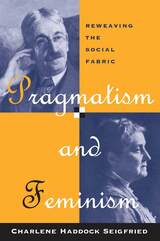 Pragmatism and Feminism: Reweaving the Social Fabric
Charlene Haddock Seigfried
University of Chicago Press, 1996 Though many pioneering feminists were deeply influenced by American pragmatism, their contemporary followers have generally ignored that tradition because of its marginalization by a philosophical mainstream intent on neutral analyses devoid of subjectivity. In this revealing work, Charlene Haddock Seigfried effectively reunites two major social and philosophical movements, arguing that pragmatism, because of its focus on the emancipatory potential of everyday experiences, offers feminism its most viable and powerful philosophical foundation.
With careful attention to their interwoven histories and contemporary concerns, Pragmatism and Feminism effectively invigorates both traditions, opening them to new interpretations and appropriations and asserting their timely philosophical relevance. This foundational work in feminist theory simultaneously invites and guides future scholarship in an area of rapidly emerging significance.
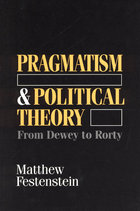 Pragmatism and Political Theory: From Dewey to Rorty
Matthew Festenstein
University of Chicago Press, 1997 Pragmatism has enjoyed a considerable revival in the latter part of the twentieth century, but what precisely constitutes pragmatism remains a matter of dispute. In reconstructing the pragmatic tradition in political philosophy, Matthew Festenstein rejects the idea that it is a single, cohesive doctrine. His incisive analysis brings out the commonalities and shared concerns among contemporary pragmatists while making clear their differences in how they would resolve those concerns. His study begins with the work of John Dewey and the moral and psychological conceptions that shaped his philosophy. Here Festenstein lays out the major philosophic issues with which first Dewey, and then his heirs, would grapple.
The book's second part traces how Dewey's approach has been differently developed, especially in the work of three contemporary pragmatic thinkers: Richard Rorty, Jurgen Habermas, and Hilary Putnam. This first full-length critical study of the relationship between the pragmatist tradition and political philosophy fills a significant gap in contemporary thought.
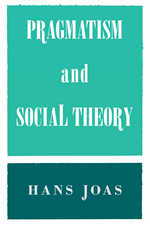 Pragmatism and Social Theory
Hans Joas
University of Chicago Press, 1993 Rising concerns among scholars about the intellectual and cultural foundations of democracy have led to a revival of interest in the American philosophical tradition of pragmatism. In this book, Hans Joas shows how pragmatism can link divergent intellectual efforts to understand the social contexts of human knowledge, individual freedom, and democratic culture.
Along with pragmatism's impact on American sociology and social research from 1895 to the 1940s, Joas traces its reception by French and German traditions during this century. He explores the influences of pragmatism—often misunderstood—on Emile Durkheim's sociology of knowledge, and on German thought, with particularly enlightening references to its appropriation by Nazism and its rejection by neo-Marxism. He also explores new currents of social theory in the work of Habermas, Castoriadis, Giddens, and Alexander, fashioning a bridge between Continental thought, American philosophy, and contemporary sociology; he shows how the misapprehension and neglect of pragmatism has led to systematic deficiencies in contemporary social theory.
From this skillful historical and theoretical analysis, Joas creates a powerful case for the enduring legacy of Peirce, James, Dewey, and Mead for social theorists today.
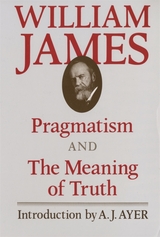 Pragmatism and The Meaning of Truth
William James
Harvard University Press, 1978 Pragmatism is the most famous single work of American philosophy. Its sequel, The Meaning of Truth, is its imperative and inevitable companion. The definitive texts of both works are here available for the first time in one volume, with an introduction by the distinguished contemporary philosopher A. J. Ayer.
In Pragmatism, William James attacked the transcendental, rationalist tradition in philosophy and tried to clear the ground for the doctrine he called radical empiricism. When first published, the book caused an uproar. It was greeted with praise, hostility, ridicule. Determined to clarify his views, James collected nine essays he had written on this subject before he wrote Pragmatism and six written later in response to criticisms by Bertrand Russell and others. He published The Meaning of Truth in 1909, the year before his death.
These two works show James at his best full of verve and good humor. Intent upon making difficult ideas clear, he is characteristically vigorous in his effort to make them prevail.
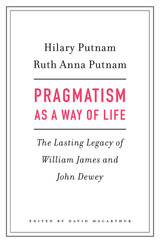 Pragmatism as a Way of Life: The Lasting Legacy of William James and John Dewey
Hilary Putnam and Ruth Anna Putnam; edited by David Macarthur
Harvard University Press, 2017 Throughout his diverse and highly influential career, Hilary Putnam was famous for changing his mind. As a pragmatist he treated philosophical “positions” as experiments in deliberate living. His aim was not to fix on one position but to attempt to do justice to the depth and complexity of reality. In this new collection, he and Ruth Anna Putnam argue that key elements of the classical pragmatism of William James and John Dewey provide a framework for the most progressive and forward-looking forms of philosophy in contemporary thought. The Putnams present a compelling defense of the radical originality of the philosophical ideas of James and Dewey and their usefulness in confronting the urgent social, political, and moral problems of the twenty-first century.
Pragmatism as a Way of Life brings together almost all of the Putnams’ pragmatist writings—essays they wrote as individuals and as coauthors. The pragmatism they endorse, though respectful of the sciences, is an open experience-based philosophy of our everyday lives that trenchantly criticizes the fact/value dualism running through contemporary culture. Hilary Putnam argues that all facts are dependent on cognitive values, while Ruth Anna Putnam turns the problem around, illuminating the factual basis of moral principles. Together, they offer a shared vision which, in Hilary’s words, “could serve as a manifesto for what the two of us would like philosophy to look like in the twenty-first century and beyond.”
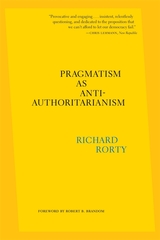 Pragmatism as Anti-Authoritarianism
Richard Rorty
Harvard University Press, 2021 “Provocative and engaging…The array of urgent questions and crises facing our democracy makes one miss Richard Rorty’s voice: insistent, relentlessly questioning, and dedicated to the proposition that we can’t afford to let our democracy fail.”
—Chris Lehmann, New Republic
“Richard Rorty was the most iconoclastic and dramatic philosopher of the last half-century. In this final book, his unique literary style, singular intellectual zest, and demythologizing defiance of official philosophy are on full display.”
—Cornel West
“Coherent, often brilliant, and it presents a clear and timely case for political pragmatism.”
—Jonathan Rée, Prospect
“Today, there are few philosophers left whose thoughts are inspired by a unifying vision; there are even fewer who can articulate such a view in terms of such a ravishing flow of provocative, but sharp and differentiated, arguments.”
—Jürgen Habermas
Richard Rorty’s final masterwork offers his culminating thoughts on the influential version of pragmatism he began to articulate decades ago in his groundbreaking Philosophy and the Mirror of Nature. He identifies anti-authoritarianism as the principal impulse and virtue of pragmatism. Anti-authoritarianism, in this view, means acknowledging that our cultural inheritance is always open to revision because no authority exists to ascertain the truth, once and for all. If we cannot rely on the unshakable certainties of God or nature, then all we have left to go on—and argue with—are the opinions and ideas of our fellow humans. The test of these ideas, Rorty suggests, is relatively simple: Do they work? Do they produce the peace, freedom, and happiness we desire? To achieve this enlightened pragmatism is not easy, though. Pragmatism demands trust. It demands that we think and care about what others think and care about, and that we account for their doubts of and objections to our own beliefs.
No book offers a more accessible account of pragmatism, just as no philosopher has more eloquently challenged the hidebound traditions arrayed against the goals of social justice.
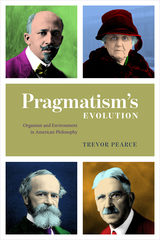 Pragmatism's Evolution: Organism and Environment in American Philosophy
Trevor Pearce
University of Chicago Press, 2020 In Pragmatism’s Evolution, Trevor Pearce demonstrates that the philosophical tradition of pragmatism owes an enormous debt to specific biological debates in the late 1800s, especially those concerning the role of the environment in development and evolution. Many are familiar with John Dewey’s 1909 assertion that evolutionary ideas overturned two thousand years of philosophy—but what exactly happened in the fifty years prior to Dewey’s claim? What form did evolutionary ideas take? When and how were they received by American philosophers?
Although the various thinkers associated with pragmatism—from Charles Sanders Peirce to Jane Addams and beyond—were towering figures in American intellectual life, few realize the full extent of their engagement with the life sciences. In his analysis, Pearce focuses on a series of debates in biology from 1860 to 1910—from the instincts of honeybees to the inheritance of acquired characteristics—in which the pragmatists were active participants. If we want to understand the pragmatists and their influence, Pearce argues, we need to understand the relationship between pragmatism and biology.
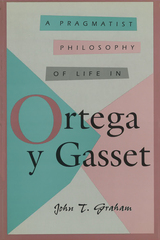 A Pragmatist Philosophy of Life in Ortega y Gasset
John T. Graham
University of Missouri Press, 1994
Jose Ortega y Gasset (1883-1955), the most widely known and well liked of Spanish philosophers, was much admired in the United States from the 1930s through the 1960s for Revolt of the Masses, History as a System, and Dehumanization of Art, among other works. Those popular works, however, poorly reflected the complexity of Ortega's philosophy. In this first historical analysis of all the parts of Ortega's total thought, John Graham explores the extent to which Ortega's metaphysics was built not only on a native Spanish realism but also upon the pragmatism of William James. Graham details the extent to which Ortega developed an existentialsim before Martin Heidegger and a new historicism less absolute than Benedetto Croce's, by means of a phenomenological method-all within a comprehensive philosophy of life similar to Wilhelm Dilthey's, but more realist and social. In addition, an extensive bibliographical essay examines how Ortega's philosophy, as a whole and in each part, has stood in the estimation of critics worldwide from the 1920s to the present.
Over ten years in preparation, A Pragmatist Philosophy of Life in Ortega y Gasset reveals how open, adaptable, and inventive was pragmatism as Ortega elaborated its philosophical implications and applications for Spain, Europe, and the Americas. It is based on extensive use of the twelve volumes of Ortega's Obras completas, the eighty microfilm reels of his archive in the Library of Congress, and his private library of fifteen hundred volumes in Madrid. These sources, many of which have not been available previously, provide the essential evidence needed to demonstrate the novelty and subtlety, the diversity and unity, of Ortega's thematic "system" of thought.
Students and scholars of intellectual history, Spanish literature, and philosophy will welcome this important new study.
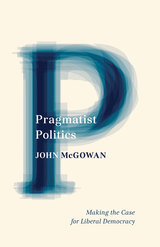 Pragmatist Politics: Making the Case for Liberal Democracy
John McGowan
University of Minnesota Press, 2012 In our current age of cynicism, John McGowan suggests that the time is right to take a fresh look at pragmatism, the philosophy of American democracy. As McGowan shows, pragmatism can be an inspiring alternative to the despair that seems to dominate contemporary American politics. Pragmatist Politics is passionate and convincing, both heartfelt and clear-eyed. It offers an expansive vision of what the United States could be and should be. From John Dewey and William James, McGowan derives a history of democracy as a way of life, characterized by a distinctive ethos and based on an understanding of politics as potentially effective collective agency. That democratic ideal is wedded to a liberalism that focuses on extending the benefits of democracy and of material prosperity to all. Beyond the intellectual case for liberal democracy, McGowan turns to how James, especially, was attuned to the ways that emotional appeals often trump persuasion through arguments, and he examines the work of Kenneth Burke, among others, to investigate the link between liberal democracy and a comic view of human life. Comedy, McGowan notes, allows consideration of themes of love, forgiveness, and generosity that figure far too infrequently in philosophical accounts of politics. In McGowan’s work, the combination of pragmatism and comedy takes us on a wide-ranging exploration of what American politics—and by extension American life—could actually be like if it truly reflected American values.
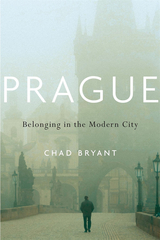 Prague: Belonging in the Modern City
Chad Bryant
Harvard University Press, 2021 A poignant reflection on alienation and belonging, told through the lives of five remarkable people who struggled against nationalism and intolerance in one of Europe’s most stunning cities.
What does it mean to belong somewhere? For many of Prague’s inhabitants, belonging has been linked to the nation, embodied in the capital city. Grandiose medieval buildings and monuments to national heroes boast of a glorious, shared history. Past governments, democratic and Communist, layered the city with architecture that melded politics and nationhood. Not all inhabitants, however, felt included in these efforts to nurture national belonging. Socialists, dissidents, Jews, Germans, and Vietnamese—all have been subject to hatred and political persecution in the city they called home.
Chad Bryant tells the stories of five marginalized individuals who, over the last two centuries, forged their own notions of belonging in one of Europe’s great cities. An aspiring guidebook writer, a German-speaking newspaperman, a Bolshevik carpenter, an actress of mixed heritage who came of age during the Communist terror, and a Czech-speaking Vietnamese blogger: none of them is famous, but their lives are revealing. They speak to tensions between exclusionary nationalism and on-the-ground diversity. In their struggles against alienation and dislocation, they forged alternative communities in cafes, workplaces, and online. While strolling park paths, joining political marches, or writing about their lives, these outsiders came to embody a city that, on its surface, was built for others.
A powerful and creative meditation on place and nation, the individual and community, Prague envisions how cohesion and difference might coexist as it acknowledges a need common to all.
Prague English Studies and the Transformation of Philologies
Edited by Martin Procházka and Ondrej Pilný
Karolinum Press, 2012 This collaborative monograph will commemorate the centenary of the Prague English Studies, officially inaugurated in 1912 by the appointment of Vilém Mathesius. Apart from reassessing the work of major representatives, such as Mathesius, Vladislav Vancura and others, and reviewing important developments in literature-oriented Prague English Studies with respect to Prague Structuralism. Prague English Studies and the Transformation of Philologies will focus on the methodological problems of the discipline related to the transformation of humanistic and modern philologies, searching for the links between two historically distinct interdisciplinary projects: humanist philology and structuralist semiology.
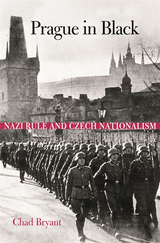 Prague in Black: Nazi Rule and Czech Nationalism
Chad Bryant
Harvard University Press, 2009 In September 1938, the Munich Agreement delivered the Sudetenland to Germany. Six months later, Hitler’s troops marched unopposed into Prague and established the Protectorate of Bohemia and Moravia—the first non-German territory to be occupied by Nazi Germany. Although Czechs outnumbered Germans thirty to one, Nazi leaders were determined to make the region entirely German.
Chad Bryant explores the origins and implementation of these plans as part of a wider history of Nazi rule and its consequences for the region. To make the Protectorate German, half the Czech population (and all Jews) would be expelled or killed, with the other half assimilated into a German national community with the correct racial and cultural composition. With the arrival of Reinhard Heydrich, Germanization measures accelerated. People faced mounting pressure from all sides. The Nazis required their subjects to act (and speak) German, while Czech patriots, and exiled leaders, pressed their countrymen to act as “good Czechs.”
By destroying democratic institutions, harnessing the economy, redefining citizenship, murdering the Jews, and creating a climate of terror, the Nazi occupation set the stage for the postwar expulsion of Czechoslovakia’s three million Germans and for the Communists’ rise to power in 1948. The region, Bryant shows, became entirely Czech, but not before Nazi rulers and their postwar successors had changed forever what it meant to be Czech, or German.
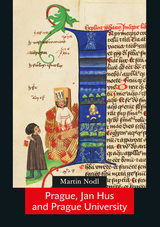 Prague, Jan Hus and Prague University
Martin Nodl
Karolinum Press, 2024 Contextualizes the Czech Reformation in the setting of Prague University.
The Czech Reformation offered a radical solution to the spiritual and institutional crisis of the late medieval church at the end of the fourteenth century. The beginnings of this reform are distinctly connected with Prague University, which drew many educated people to Prague from across Europe. Through John Hus—a former Prague University student who became its rector in 1402—the Czech Reformation gave rise to a new, radical ecclesiology. Not only did Hus challenge the hierarchical system of the church, but under his influence, the Czech Reformation acquired a specific national shape, and elements of Czech messianism emerged with the university.
Prague, John Hus and Prague University explores that sentiment within Prague University, as well as its limits and restrictive consequences for the Czech Reformation and Czech medieval society. Emphasis is placed on showing how Prague and the university became a world that existed outside the Christian ecumenism of the time.
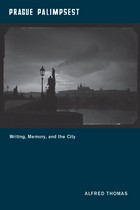 Prague Palimpsest: Writing, Memory, and the City
Alfred Thomas
University of Chicago Press, 2010 A city of immense literary mystique, Prague has inspired writers across the centuries with its beauty, cosmopolitanism, and tragic history. Envisioning the ancient city in central Europe as a multilayered text, or palimpsest, that has been constantly revised and rewritten—from the medieval and Renaissance chroniclers who legitimized the city’s foundational origins to the modernists of the early twentieth century who established its reputation as the new capital of the avant-garde—Alfred Thomas argues that Prague has become a paradoxical site of inscription and effacement, of memory and forgetting, a utopian link to the prewar and pre-Holocaust European past and a dystopia of totalitarian amnesia. Considering a wide range of writers, including the city’s most famous son, Franz Kafka, Prague Palimpsest reassesses the work of poets and novelists such as Bohumil Hrabal, Milan Kundera, Gustav Meyrink, Jan Neruda, Vítĕzslav Nezval, and Rainer Maria Rilke and engages with other famous authors who “wrote” Prague, including Guillaume Apollinaire, Ingeborg Bachmann, Albert Camus, Paul Celan, and W. G. Sebald. The result is a comparative, interdisciplinary study that helps to explain why Prague—more than any other major European city—has haunted the cultural and political imagination of the West.
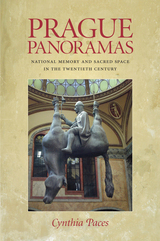 Prague Panoramas: National Memory and Sacred Space in the Twentieth Century
Cynthia Paces
University of Pittsburgh Press, 2009 Prague Panoramas examines the creation of Czech nationalism through monuments, buildings, festivals, and protests in the public spaces of the city during the twentieth century. These “sites of memory” were attempts by civic, religious, cultural, and political forces to create a cohesive sense of self for a country and a people torn by war, foreign occupation, and internal strife.
The Czechs struggled to define their national identity throughout the modern era. Prague, the capital of a diverse area comprising Czechs, Slovaks, Germans, Poles, Ruthenians, and Romany as well as various religious groups including Catholics, Protestants, and Jews, became central to the Czech domination of the region and its identity. These struggles have often played out in violent acts, such as the destruction of religious monuments, or the forced segregation and near extermination of Jews.
During the twentieth century, Prague grew increasingly secular, yet leaders continued to look to religious figures such as Jan Hus and Saint Wenceslas as symbols of Czech heritage. Hus, in particular, became a paladin in the struggle for Czech independence from the Habsburg Empire and Austrian Catholicism.
Through her extensive archival research and personal fieldwork, Cynthia Paces offers a panoramic view of Prague as the cradle of Czech national identity, seen through a vast array of memory sites and objects. From the Gothic Saint Vitus Cathedral, to the Communist Party's reconstruction of Jan Hus's Bethlehem Chapel, to the 1969 self-immolation of student Jan Palach in protest of Soviet occupation, to the Hosková plaque commemorating the deportation of Jews from Josefov during the Holocaust, Paces reveals the iconography intrinsic to forming a collective memory and the meaning of being a Czech. As her study discerns, that meaning has yet to be clearly defined, and the search for identity continues today.
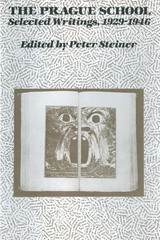 The Prague School: Selected Writings, 1929-1946
Edited by Peter Steiner
University of Texas Press, 1982 The Prague Linguistic Circle came into being on the afternoon of October 6, 1926, when five Czech and Russian linguists gathered to hear a lecture by a German colleague. From this international beginning, the interests of the group grew to first encompass language in all its functional heterogeneity and then finally all of culture, which the Circle conceived of as a structure of sign systems. Semiotics was thus the overarching discipline for the Prague School, serving to organize all phenomena shared and exchanged by a cultural community. In recent years increasing attention has been paid to the importance of the Prague School, but writing about it has frequently been marred by misconceptions. The central aim of this volume is to correct those misconceptions and to present the diversity of interests within the Prague School—literary criticism, linguistics, theory of theater, folklore, and philosophy. These essays by Bogatyrëv, Jakobson, Karcevskij, Mukařovský, Rieger, Vodička, and Honzl are here translated into English for the first time. Some have a special historical value in illuminating critical stages of structuralist thinking; others reveal the timeliness of the School's contributions for the theoretical conflicts of our day. Each essay is accompanied by an informative introductory note, and the whole is followed by the editor's "Postscript," tracing the roots of structuralist aesthetics.
Prague Soundscapes
Zuzana Jurková
Karolinum Press, 2014 Dvorák’s opera Rusalka at the National Theatre. A punk concert in an underground club. The hypnotic chanting of Hare Krishnas joyfully dancing through the streets. These are the sounds of Prague. And in this book, they are the subject of a musical anthropological inquiry.
Prague Soundscapes seeks to understand why in human society—in its behavior, values, and relationships—music is produced and how those who make it listen to it. Based on recent theories of cultural anthropology, this study offers an account of the musical activities of contemporary Prague in different musical genres, cultural spaces, and events. The text is bolstered by color photographs of the musical events, producers, and listeners.
 The Prague Spring, 1968
The National Security Archive Navratíl
Central European University Press, 1998 This is the first ever documented account of a Cold War crisis as seen from both sides of the Iron Curtain. Based on unprecedented access to the previously closed archives of each member-state of the Warsaw Pact, this book offers a unique look at a deeply divisive intra-bloc crisis.
Presented in a highly readable form, the book offers top-level documents from Kremlin Politburo meetings, multi-lateral sessions of the Warsaw Pact leading up to the decision to invade, and even transcriptions of KGB-recorded phone conversations between Leonid Brezhnev and Alexander Dubcek. Once highly classified American documents from the National Security Council, CIA, and other relevant agencies acquired through the U.S. Freedom of Information Act have also been included.
In order to provide a historical and political context, the editors have included an introductory essay for each section of the volume. A chronology, glossary, and bibliography offer further background information for the reader. As members of the commission appointed by Václav Havel to investigate the events of 1967-1970, the editors have a unique Czech-Slovak perspective to offer to foreign audiences.
Prague Tales
Jan Neruda
Central European University Press, 1996 This is a collection of Jan Neruda's intimate, wry, bittersweet stories of life among the inhabitants of the Little Quarter of nineteenth-century Prague. These finely tuned and varied vignettes established Neruda as the quintessential Czech nineteenth-century realist, the Charles Dickens of a Prague becoming ever more aware of itself as a Czech rather than an Austrian city. Prague Tales is a classic by a writer whose influence has been acknowledged by generations of Czech writers, including Ivan Klíma, who contributes an introduction to this new translation.
The Prairie
James Fenimore Cooper
Harvard University Press, 2014 The action of James Fenimore Cooper's The Prairie (1827) unfolds against the backdrop of the grasslands beyond the Mississippi, just after the Louisiana Purchase, in the early days of western expansion. It features Cooper's most celebrated literary creation, Natty Bumppo, now aged and reduced to making a living by trapping. As the frontiersman's epic journey from the Atlantic to the Pacific nears its end in a vast and still uninhabited region that Cooper consistently imagines as an ocean of the interior, nothing less than the future identity of America is at stake, Domhnall Mitchell suggests in his Introduction.
The John Harvard Library edition reproduces the authoritative text of the novel from The Writings of James Fenimore Cooper, published by the State University of New York Press.
Since 1959 The John Harvard Library has been instrumental in publishing essential American writings in authoritative editions.
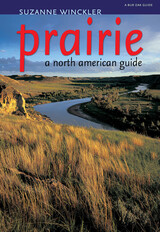 Prairie: A North American Guide
Suzanne Winckler
University of Iowa Press, 2004 North America’s grasslands once stretched from southern Canada to northern Mexico, and across this considerable space different prairie types evolved to express the sum of their particular longitude and latitude, soils, landforms, and aspect. This prairie guide is your roadmap to what remains of this varied and majestic landscape. Suzanne Winckler’s goal is to encourage travelers to get off the highways, out of their cars, and onto North America’s last remaining prairies. She makes this adventure as easy as possible by providing exact driving directions to the more than three hundred sites in her guide. She also includes information about size, management, phone numbers, and outstanding characteristics for every prairie site and provides readers with a thorough list of recommended readings and Web sites. The scope of the guide is impressive. It encompasses prairies found within national grasslands, parks, forests, recreation areas, wildlife refuges, state parks, preserves, and natural areas and on numerous working ranches in Saskatchewan and Manitoba, the Dakotas, Minnesota, Illinois, Iowa, Kansas, Missouri, Nebraska, Oklahoma, and Texas. A series of maps locate the prairies both geographically and by name. From “the largest restoration project within the historic range of tallgrass prairie” at Neal Smith National Wildlife Refuge in Iowa to Big Bend National Park in Texas, where “the Chisos Mountains, completely surrounded by the park, rise up majestically from the Chihuahuan Desert floor,” Winckler celebrates the dramatic expanses of untouched prairie, the crown jewels of prairie reconstruction and restoration, and the neglected remnants that deserve to be treasured.
Prairie Albion: An English Settlement in Pioneer Illinois
Charles Boewe
Southern Illinois University Press, 1999 Originally published in 1962, this story of the English Settlement in pioneer Illinois is compiled from the eyewitness accounts of the participants. The founders, Morris Birkbeck and George Flower, as well as their associates and the many visitors to their prairie settlement, wrote mainly for immediate and sometimes controversial ends. Charles Boewe has selected excerpts from letters, descriptions, diaries, histories, and periodicals within a chronological framework to emphasize the implicit drama of the settlers' deeds as they searched for a suitable site, founded their colony, and augmented their forces with new arrivals from England. No less dramatic is the subsequent estrangement of the two founders, the disillusionment of many of the English settlers, the untimely death of Birkbeck, and the financial ruin of Flower.
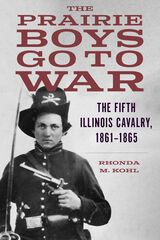 The Prairie Boys Go to War: The Fifth Illinois Cavalry, 1861-1865
Rhonda M. Kohl
Southern Illinois University Press, 2013 Cavalry units from Midwestern states remain largely absent from Civil War literature, and what little has been written largely overlooks the individual men who served. The Fifth Illinois Cavalry has thus remained obscure despite participating in some of the most important campaigns in Arkansas and Mississippi. In this pioneering examination of that understudied regiment, Rhonda M. Kohl offers the only modern, comprehensive analysis of a southern Illinois regiment during the Civil War and combines well-documented military history with a cultural analysis of the men who served in the Fifth Illinois. The regiment’s history unfolds around major events in the Western Theater from 1861 to September 1865, including campaigns at Helena, Vicksburg, Jackson, and Meridian, as well as numerous little-known skirmishes. Although they were led almost exclusively by Northern-born Republicans, the majority of the soldiers in the Fifth Illinois remained Democrats. As Kohl demonstrates, politics, economics, education, social values, and racism separated the line officers from the common soldiers, and the internal friction caused by these cultural disparities led to poor leadership, low morale, disciplinary problems, and rampant alcoholism. The narrative pulls the Fifth Illinois out of historical oblivion, elucidating the highs and lows of the soldiers’ service as well as their changing attitudes toward war goals, religion, liberty, commanding generals, Copperheads, and alcoholism. By reconstructing the cultural context of Fifth Illinois soldiers, Prairie Boys Go to War reveals how social and economic traditions can shape the wartime experience.
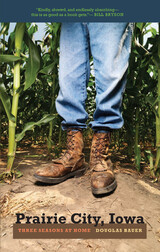 Prairie City, Iowa: Three Seasons at Home
Douglas Bauer
University of Iowa Press, 1979 Weary from the journalistic treadmill of "going from one assignment to the next, like an itinerant fieldworker moving to his harvests" and healing from a divorce, Douglas Bauer decided it was time to return to his hometown. Back in Prairie City, he helped on his father's farm, scooped grains at the Co-op, and tended bar at the Cardinal. The resultant memoir is a classic picture of an adult experiencing one's childhood roots as a grown-up and testing whether one can ever truly go home again.
Bauer grew up "awkward with soil and with machines" in a small town east of Des Moines, As a teenager, he left the farm for college life twenty miles away and, after graduation, took a job with Better Homes and Gardens in Des Moines, writing in the junk-mail fictional persona of "Barbara Joyce,"asking millions of people to subscribe. After a few years he moved to Chicago to work as an editor and writer for Playboy and eventually as a freelance journalist. In the summer of 1975, he returned home to attend his grandmother's funeral and by autumn he moved back to Prairie City, where he stayed for the next three seasons.
Bauer's book is neither a wistful nostalgia about returning to a simpler time and place nor a patronizing look at those who never leave the town in which they were born. What emerges is an unsentimental yet loving account of life in the Midwest. Not just a portrait of Prairie City, Iowa, but of everyone's small town, everywhere.
 Prairie Conservation: Preserving North America's Most Endangered Ecosystem
Edited by Fred B. Samson and Fritz L. Knopf; Foreword by Governor of Nebraska E.Benjamin Nelson
Island Press, 1996 The area of native prairie known as the Great Plains once extended from Canada to the Mexican border and from the foothills of the Rocky Mountains to western Indiana and Wisconsin. Today the declines in prairie landscape types, estimated to be as high as 99%, exceed those of any other major ecosystem in North America. The overwhelming loss of landscape and accompanying loss of species constitute a real threat to both ecological and human economic health.Prairie Conservation is a comprehensive examination of the history, ecology, and current status of North American grasslands. It presents for the first time in a single volume information on the historical, economic, and cultural significance of prairies, their natural history and ecology, threats, and conservation and restoration programs currently underway. Chapters cover: environmental history of the Great Plains the economic value of prairie prairie types -- tallgrass, mixed grass, shortgrass, wetlands -- and the ecological processes that sustain each type prairie fauna -- invertebrates, fish and other aquatic creatures, amphibians and reptiles, birds, and mammals conservation programs such as the Great Plains Partnership, Canada's Prairie Conservation Action Plan, the U.S. Prairie Pothole Joint Venture, and others The book brings together knowledge and insights from a wide range of experts to describe and explain the importance of prairies and to position them in the forefront of North American conservation efforts. Praire Conservation is an essential reference for anyone interested in prairie ecology and conservation and will play a critical role in broadening our awareness and understanding of prairie ecosystems.
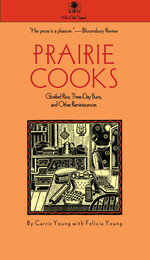 Prairie Cooks: Glorified Rice Three-Day Buns
Carrie Young
University of Iowa Press, 1993 Growing up in a Norwegian American community imbued with the customs and foods of the Old Country, Carrie Young recalls how her mother and her neighbors skillfully blended Scandinavian with what they always called the American style of cooking. Young recounts how her mother, Carrine Gafkjen—after homesteading as a single woman in 1904—cooked for a large threshing crew during harvest season. Living and cooking around the clock in a cook car the size of a Pullman kitchen, she delighted the crew with her soda pancakes and her sour cream doughnuts, her fattigman (Poor Man's Cookies) and her fabulous North Dakota Lemon Meringue Pie. During holidays lutefisk and lefse reigned supreme, but when the Glorified Rice fad swept the country in the thirties women broke new ground with inventive variations. And the short-lived but intensely experienced Three-Day Bun Era (when the buns became so ethereal they were in danger of floating off the plate) kept the Ladies Aid luncheons competitive. Whatever the times, in good years or bad, there was always the solace ofKaffe Tid, the forenoon and afternoon coffee time, when the table was set with smor og brod (butter and bread) and something sweet, like a Whipped Cream Cake or Devil's Food Cake with Rhubarb Sauce. This book will appeal to those who feel nostalgia for a parent's or grandparent's cooking, to those who have a longing for the heartier fare of times past. The author's daughter, Felicia Young, who has "cooked Scandinavian since she was old enough to hold a lefse stick," has compiled and tested the seventy-two recipes accompanying this joyful memoir.
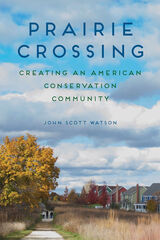 Prairie Crossing: Creating an American Conservation Community
John Scott Watson
University of Illinois Press, 2016 Carved out of century-old farmland near Chicago, the Prairie Crossing development is a novel experiment in urban public policy that preserves 69 percent of the land as open space. The for-profit project has set out to do nothing less than use access to nature as a means to challenge America's failed culture of suburban sprawl. The first comprehensive look at an American conservation community, Prairie Crossing goes beyond windmills and nest boxes to examine an effort to connect adults to the land while creating a healthy and humane setting for raising a new generation attuned to nature. John Scott Watson places Prairie Crossing within the wider context of suburban planning, revealing how two first-time developers implemented a visionary new land ethic that saved green space by building on it. The remarkable achievements include a high rate of resident civic participation, the reestablishment of a thriving prairie ecosystem, the reintroduction of endangered and threatened species, and improved water and air quality. Yet, as Watson shows, considerations like economic uncertainty, lack of racial and class diversity, and politics have challenged, and continue to challenge, Prairie Crossing and its residents.
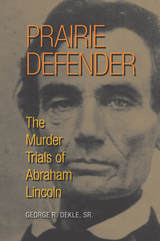 Prairie Defender: The Murder Trials of Abraham Lincoln
George R. Dekle, Sr.
Southern Illinois University Press, 2017 2018 FAPA President’s book award medalist in the non-fiction adult, biography, and political/current events categories
2018 ISHS Annual Award Winner for a Scholarly Publication
According to conventional wisdom, Abraham Lincoln spent most of his law career collecting debt and representing railroads, and this focus made him inept at defending clients in homicide cases. In this unprecedented study of Lincoln’s criminal cases, George Dekle disproves these popular notions, showing that Lincoln was first and foremost a trial lawyer. Through careful examination of Lincoln’s homicide cases and evaluation of his legal skills, Dekle demonstrates that criminal law was an important part of Lincoln's practice, and that he was quite capable of defending people accused of murder, trying approximately one such case per year.
Dekle begins by presenting the viewpoints of not only those who see Lincoln as a perfect lawyer whose only flaw was his inability to represent the wrong side of a case but also those who believe Lincoln was a less-than-honest legal hack. The author invites readers to compare these wildly different stereotypes with the flesh-and-blood Lincoln revealed in each case described in the book, including an axe murder suit in which Lincoln assisted the prosecution, a poisoning case he refused to prosecute for $200 but defended for $75, and a case he won by proving that a supposed murder victim was actually still alive.
For each case Dekle covers, he first tells the stories of the feuds, arguments, and insults that led to murder and other criminal activity, giving a gripping view of the seamy side of life in nineteenth-century Illinois. Then he traces the course of the pretrial litigation, describes the trials and the various tactics employed in the prosecution and defense, and critiques the performance of both Lincoln and his adversaries.
Dekle concludes that Lincoln was a competent, diligent criminal trial lawyer who knew the law, could argue it effectively to both judge and jury, and would use all lawful means to defend clients whether he believed them to be innocent or guilty. His trial record shows Lincoln to have been a formidable defense lawyer who won many seemingly hopeless cases through his skill as a courtroom tactician, cross-examiner, and orator. Criminal defendants who could retain Lincoln as a defense attorney were well represented, and criminal defense attorneys who sought him as co-counsel were well served. Providing insight into both Lincoln’s legal career and the culture in which he practiced law, Prairie Defender resolves a major misconception concerning one of our most important historical figures.
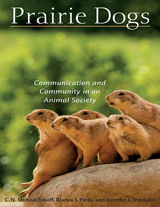 Prairie Dogs: Communication and Community in an Animal Society
C. N. Slobodchikoff, Bianca S. Perla, and Jennifer L. Verdolin
Harvard University Press, 2007 Constantine Slobodchikoff and colleagues synthesize the results of their long-running study of Gunnison’s prairie dogs (Cynomys gunnisoni), one of the keystone species of the short-grass prairie ecosystem. They set their research in the context of the biology of the five Cynomys species found in the United States and Mexico, and detail their investigation into the prairie dogs’ sophisticated system of barks, yips, and chirps, which Slobodchikoff argues represents a referential communication capable of fine distinctions among predators.
Seen as vermin that spoiled valuable rangeland, prairie dogs were long the subject of eradication campaigns and are now threatened by habitat loss and the loss of genetic diversity. The authors hope their research will help to pull the prairie dog back from the brink of extinction, as well as foster an appreciation of larger conservation challenges. By examining the complex factors behind prairie dog decline, we can begin to understand the problems inherent in our adversarial relationship with the natural world. Understanding these interactions is the first step toward a more sustainable future.
 Prairie Edge
Conor Kerr
University of Minnesota Press, 2024 Set loose a herd of bison in downtown Edmonton: what could go wrong?
Métis cousins Isidore “Ezzy” Desjarlais and Grey Ginther have beef with their world. With the latest racist policy rolling out. With whatever new pipeline plowing through traditional territory. With the way a treaty (aka, the army) forced the Papaschase Cree off their home on the prairie. And, on the other hand, with how Grey’s friends think if they all just went back to the Rez or the settlement, life would be so much better—pretty, like an Instagram ad. Then there’s the warming planet. And their future, which they seem to be screwing up quite well on their own. Being alive can’t be all cribbage, Lucky Lager, and swiping the occasional catalytic converter. One night, the cousins hatch a plan to capture a herd of bison from a nearby national park and release them in downtown Edmonton. They want to be seen, be heard, and to disrupt the settler routines of the city, yet they have no idea what awaits them or the fateful consequences their actions have. Balancing wit and sorrow in a work of satire, social commentary, and whip-smart storytelling, Prairie Edge follows Ezzy and Grey’s inspired misadventures as their zealous ideas about bringing about real change do indeed elicit change, just in unexpected and sometimes disastrous ways. Conor Kerr imagines a web of Métis relationships strained by dislocation, poverty, violence, and cultural drift, but he also laces the ties that bind Ezzy and Grey—and forever bind the Métis to the land—to explore the radical possibility that a couple of inspired miscreants might actually have the power to make a difference.
 The Prairie Falcon
By Stanley H. Anderson and John R. Squires
University of Texas Press, 1997 Skillful hunters beautiful in flight, Prairie Falcons inhabit the rocky cliffs of the American West. These raptors range from southern Canada and northern North Dakota to Baja California, Arizona, New Mexico, western and northern Texas, and southeastern Coahuila, Mexico. This is the first book for a wide audience devoted exclusively to the Prairie Falcon. Stanley Anderson and John Squires cover all aspects of the falcon's life history from mating and rearing young to hunting behaviors and the yearly migration cycle. They provide complete descriptive characteristics for identifying Prairie Falcons and also compare them to other raptors, especially the closely related Peregrine Falcon. In addition, the authors recount the long association of falcons with people, which may extend back as far as 2000 BC. They describe the practice of falconry from the Middle Ages until today. And they assess the threats to Prairie Falcons posed by human activities, from pesticide use and destruction of habitat to disruption of the breeding cycle by careless birdwatchers.
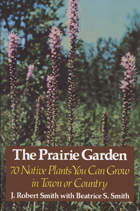 The Prairie Garden: Seventy Native Plants You Can Grow in Town or Country
J. Robert Smith with Beatrice S. Smith
University of Wisconsin Press, 1980 Prairie plants are among the toughest of all ornamentals. While they fascinate gardeners with their beauty and versatility, they require little maintenance. They are highly resistant to insect and disease damage, and they need not be replanted every year. In recent years, the idea of growing prairie plants has gained increasing appeal among gardeners. Bob and Beatrice Smith have prepared this practical growing guide—based on their more than fourteen years of experience and experimentation—for all people who wish to grow prairie plants. The Smiths, who have grown all the plants they discuss here, share their wealth of experience with the reader. They recommend the best sites, tell how to plan and prepare the site and how to treat and plant seeds, and share important tips on propagation, transplanting, and managing the prairie garden or landscape. To aid in both planning and identification, the book includes full-color illustrations of all seventy plants.
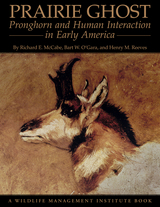 Prairie Ghost: Pronghorn and Human Interaction in Early America
Richard E. McCabe
University Press of Colorado, 2010
A Wildlife Management Institute Book
In this lavishly illustrated volume Richard E. McCabe, Bart W. O'Gara and Henry M. Reeves explore the fascinating relationship of pronghorn with people in early America, from prehistoric evidence through the Battle of Little Bighorn in 1876. The only one of fourteen pronghorn-like genera to survive the great extinction brought on by human migration into North America, the pronghorn has a long and unique history of interaction with humans on the continent, a history that until now has largely remained unwritten.
With nearly 150 black-and-white photographs, 16 pages of color illustrations, plus original artwork by Daniel P. Metz, Prairie Ghost: Pronghorn and Human Interaction in Early America tells the intriguing story of humans and these elusive big game mammals in an informative and entertaining fashion that will appeal to historians, biologists, sportsmen and the general reader alike.
Winner of the Wildlife Society's Outstanding Book Award for 2005
Prairie Grass Roots: An Iowa Small Town in the Early Twentieth Century
Thomas J. Morain
University of Iowa Press, 1998 Prairie Grass Roots describes how broad social changes taking place in the early twentieth century influenced one particular town, Jefferson, Iowa. Examing the three turbulent decades between the turn of the century and the New Deal, Morain looks at the impact of social change on community social structure, gender roles, the influence of the automobile,electricty,World War I, and the farm depression. A final chapter analyzes the state of the small town at the beginning of the 1930's. Combining archival research, oral histories and local newspaper accounts, Morain revisitis Jefferson's residents perceptions of their times.
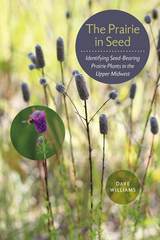 The Prairie in Seed: Identifying Seed-Bearing Prairie Plants in the Upper Midwest
Dave Williams
University of Iowa Press, 2016 The tallgrass prairie offers solutions to the many environmental challenges facing our water, soils, and ecosystems. Planting prairie on just 10 percent of a field can effectively remove excess phosphorous and nitrogen from the remaining 90 percent. Deep prairie roots and dense aboveground growth filter and hold soils, keeping them from eroding into our streams and rivers. Plants such as common milkweed are the key to the monarch butterfly’s recovery. In light of these benefits, perhaps our love affair with European turf grass is slowly giving way to an appreciation of the beauty of our original native prairie.
As interest in these wildflowers and grasses has grown, so has demand for better resources to identify the hundreds of species that make up the native prairie. In The Prairie in Seed, Dave Williams shows us how to identify wildflowers when they are out of bloom and, in particular, how to harvest their seeds. Without the flower color and shape as guides, it can be difficult to identify prairie plants. Imagine trying to distinguish between a simple prairie sunflower and an ox-eye sunflower with no flowers to look at!
In this richly illustrated guide, Williams offers dormant plant identification information, seed descriptions, and advice on seed harvesting and cleaning for seventy-three of the most common wildflowers found in the tallgrass prairie. He includes photographs and descriptions of the plants in bloom and in seed to assist in finding them when you are ready to harvest. Each species description explains where the seeds are located on the plant, when seed ripening begins, and how many seeds each species produces, along with a photograph and approximate measurements of the actual seed. Finally, this guide provides assistance on how and when to hand-harvest seeds for each species, as well as some simple tips on seed cleaning.
An indispensable guide for anyone involved in prairie restoration or conservation, this book is the perfect complement to Williams’s The Tallgrass Prairie Center Guide to Seed and Seedling Identification in the Upper Midwest.
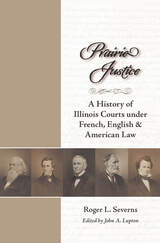 Prairie Justice: A History of Illinois Courts under French, English, and American Law
Roger L. Severns. Edited by John A. Lupton
Southern Illinois University Press, 2015 Winner, ISHS Superior Achievement Award for a Scholarly Publication, 2016
A concise legal history of Illinois through the end of the nineteenth century, Prairie Justice covers the region’s progression from French to British to early American legal systems, which culminated in a unique body of Illinois law that has influenced other jurisdictions. Written by Roger L. Severns in the 1950s and published in serial form in the 1960s, Prairie Justice is available now for the first time as a book, thanks to the work of editor John A. Lupton, an Illinois and legal historian who also contributed an introduction. Illinois’ legal development demonstrates the tension between two completely different European legal systems, between river communities and prairie towns, and between agrarian and urban interests. Severns uses several rulings—including a reconstitution of the Supreme Court in 1824, slavery-related cases, and the impeachment of a Supreme Court justice—to examine political movements in Illinois and their impact on the local judiciary. Through legal decisions, the Illinois judiciary became an independent, co-equal branch of state government. By the mid-nineteenth century, Illinois had established itself as a leading judicial authority, influencing not only the growing western frontier but also the industrialized and farming regions of the country. With a close eye for detail, Severns reviews the status of the legal profession during the 1850s by looking new members of the Court, the nostalgia of circuit riding, and how a young lawyer named Abraham Lincoln rose to prominence. Illinois has a rich judicial history, but that history has not been adequately documented until now. With the publication of Prairie Justice, those interested in Illinois legal history finally have a book that covers the development of the state’s judiciary in its formative years.
Prairie Metropolis: New Essays on Winnipeg Social History
Esyllt W. Jones
University of Manitoba Press, 2009 At the turn of the twentieth century, Winnipeg was the fastest-growing city in North America. But its days as a diverse and culturally rich metropolis did not end when the boom collapsed. Prairie Metropolis brings together some of the best new graduate research on the history of Winnipeg and makes a groundbreaking contribution to the history of the city between 1900 and the 1980s. The essays in this collection explore the development of social institutions such as the city’s police force, juvenile court, health care institutions, volunteer organizations, and cultural centres. They offer critical analyses on ethnic, gender, and class inequality and conflict, while placing Winnipeg’s experiences in national and international contexts.
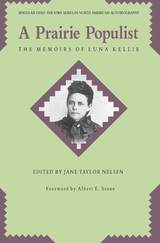 A Prairie Populist: The Memoirs of Luna Kellie
Jane Taylor Nelsen
University of Iowa Press, 1992 Populist singer, Mid-Roader, editor, publisher, wife, mother of eleven, Luna Kellie was a well-informed, fervent member of the Farmers' Alliance movement in the latter part of the nineteenth century. Radicalized by railroad monopolies, corrupt government, recurring drought, heavy mortgages, and a desperate combination of rising costs and falling returns, prairie farmers were turning their energy toward raising "less corn and more hell."
Kellie actively sought to organize Nebraska into cooperatives and educate rural people about land, transportation, and money reform. Her compelling, often heartbreaking memoirs—written on the backs of ornate red-and-gold Farmers' Alliance certificates in 1925—give us her own description of how she became motivated to join the Alliance and participate in the Populist party. Kellie writes of her homesteading and political life from the age of eighteen to forty, of failed crops, mortgaged fields, intense hardships, and her devastation at the death of her children.
One of the most complete accounts of the Mid-Road political faction available, relevant in many ways to the plight of today's farmers, A Prairie Populist should be read by anyone with an interest in national politics, the farm protest movement, women's studies, and American cultural history.
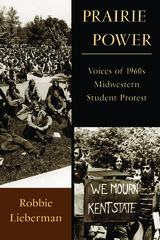 Prairie Power: Voices of 1960s Midwestern Student Protest
Robbie Lieberman
University of Missouri Press, 2019 Prairie Power, a superb collection of oral histories from the 1960s, focuses on former student radicals at the University of Missouri, the University of Kansas, and Southern Illinois University. Robbie Lieberman presents a view of Midwestern New Left activists that has been neglected in previous studies. Scholarship on the sixties has been shifting from a national focus to more local and regional studies, but few authors have studied the student movement in the Midwest. Moreover, the characterization of prairie power activists as “long-haired, dope-smoking anarchists” who were responsible for the downfall of Students for a Democratic Society (SDS) has not been challenged directly. While still viewing these activists critically, Lieberman argues that Midwestern students made significant contributions to the New Left in the latter half of the decade, and that their efforts were not only important at the time but also had a lasting impact on the universities and towns in which they were active. The author begins by explaining “prairie power” and establishing its significance in the history of 1960s protest. She then presents the oral histories in three parts. The first section reveals what “prairie power” meant to national leaders of SDS who were regional organizers in the Midwest. The second section of oral histories gives insight into the backgrounds, concerns, and activities of local leaders from the three universities who were homegrown Midwestern activists. Lieberman shows that while the national leaders take credit for organizing on several college campuses, the local activists often felt that they were on their own. The third group of oral histories—from grassroots activists—is what most sets this book apart from previous works on the student New Left. These are students who joined demonstrations on their own campuses but did not necessarily identify with either local or national organizations. Their rarely heard voices help provide a better understanding of who participated in the student protest movement, why they were involved, and how their activities profoundly affected their lives for years to come. Prairie Power makes a significant contribution toward a more comprehensive history of student activism in the turbulent 1960s.
Prairie Reunion
Barbara J. Scot
University of Iowa Press, 2000 “What do you think? You don't understand. You'll never know how much. ” Barbara Scot's memoir begins with a trunk full of memories and her mother's cryptic letters about a marriage unraveling. Like a mystery detective, the author searches for the truth, which takes her back to the scene of a tragedy—to the farm her family lost and the close-knit and secretive community she left behind. In uncovering the secrets of her family, Scot comes to understand her own failed marriage.
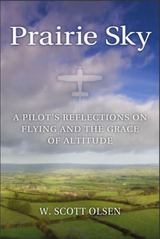 Prairie Sky: A Pilot's Reflections on Flying and the Grace of Altitude
W. Scott Olsen
University of Missouri Press, 2013 “It’s almost like ballet. Preflight. Starting. Warm-up. The voices from the control tower—the instructions. Taxiing. The rush down the runway. Airborne. There are names for every move. The run-up. Position and hold. Every move needs to be learned, practiced, made so familiar you feel the patterns in every other thing you do. It’s technical, yes. But there is a grace to getting metal and bone into the sky.” Prairie Sky is a celebration of curiosity and a book for explorers. In this collection of contemplative essays, Scott Olsen invites readers to view the world from a pilot’s seat, demonstrating how, with just a little bit of altitude, the world changes, new relationships become visible, and new questions seem to rise up from the ground. Whether searching for the still-evident shores of ancient lakes, the dustbowl-era shelterbelt supposed to run the length of the country, or the even more elusive understandings of physics and theology, Olsen shares the unique perspective and insight allowed to pilots. Prairie Sky explores the reality as well as the metaphor of flight: notions of ceaseless time and boundless space, personal interior and exterior vision, social history, meteorology, and geology. Olsen takes readers along as he chases a new way of looking at the physical world and wonders aloud about how the whole planet moves in interconnected ways not visible from the ground. While the northern prairie may call to mind images of golden harvests and summer twilight such images do not define the region. The land bears marks left by gut-shaking thunderstorms, hard-frozen rivers, sweeping floods, and hurricane-size storms. Olsen takes to the midwestern sky to confront the ordinary world and reveals the magic--the wondrous and unique sights visible from the pilot’s seat of a Cessna. Like Antoine de Saint-Exupery’s classic work Wind, Sand and Stars, Olsen’s Prairie Sky reveals the heart of what it means to fly. In the grand romantic tradition of the travel essay, it opens the dramatic paradoxes of self and collective, linear and circular, the heart and the border.
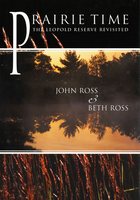 Prairie Time: The Leopold Reserve Revisited
John Ross and Beth Ross
University of Wisconsin Press, 1998 In the rush of modern life, we measure our lives by the clock, the calendar, the timetable. But there are older rhythms in nature: the call of chickadees before the first hint of spring, the golden face of a compass plant in July, the first snowfall. These signs mark the passage of time in a world that Aldo Leopold knew well and eloquently described.
With notebook and camera in hand, John and Beth Ross revisit the Aldo Leopold Memorial Reserve in south-central Wisconsin fifty years after Leopold’s death. Thanks to the efforts of Leopold, his family, and the Leopold Foundation, this once-ruined farmland is now largely restored to a natural state. The Rosses explore the terrain of this sandy land, encounter its natural citizens, and relate life here to its physical underpinnings. Following Leopold’s own practice of phenology, they note the seasonal changes: arrivals and departures of wild geese, the blossoming of the pasque flower at the edge of melting snow, the appearance of monarch butterflies on the milkweed. And further, they seek to find in this landscape an underlying morality, a communion of understanding, a sense of place in the cosmos.
Beautifully illustrated with color photographs, the book also includes notes on the behavior, habitat, and human interactions with ninety-four species of plants, birds, and other animals found in the reserve. An extensive glossary explains terms from geology, ecology, meteorology, and related life and earth sciences.
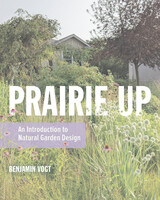 Prairie Up: An Introduction to Natural Garden Design
Benjamin Vogt
University of Illinois Press, 2023 Connecting to nature with native plants Landscaping with native plants has encouraged gardeners from the Midwest and beyond to embark on a profound scientific, ecological, and emotional partnership with nature. Benjamin Vogt shares his expertise with prairie plants in a richly photographed guide aimed at gardeners and homeowners, making big ideas about design approachable and actionable. Step-by-step blueprints point readers to plant communities that not only support wildlife and please the eye but that rethink traditional planting and maintenance. Additionally, Vogt provides insider information on plant sourcing, garden tools, and working with city ordinances. This book will be an invaluable reference in sustainable garden design for those wanting both beautiful and functional landscapes. Easy to use and illustrated with over 150 color photos, Prairie Up is a practical guide to artfully reviving diversity and wildness in our communities.
Received Honorable Mention from the AHS Book Awards (American Horticultural Society)
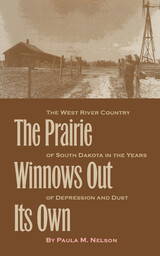 The Prairie Winnows Out Its Own: The West River Country of South Dakota in the Years of Depression and Dust
Nelson, Paula M.
University of Iowa Press, 1996 Between 1900 and 1915, in the last great land rush, over one hundred thousand homesteaders flooded into the west river country of South Dakota, a land noted for its aridity and unpredictable weather, its treelessness, and its endless sky. The settlers of “the last, best west” weathered their first crisis in the severe drought of 1910-1911, which winnowed out many of the speculators and faint of heart; they abandoned their founding hopes of quick success and substituted a new ethos of “next year country”—while this year was hard, next year would be better, an ironic phrase at once optimistic and fatalistic. “Next year,” however, was in many of those years not better. The collapse of the agricultural economy in the immediate aftermath of the boom years of World War I set in motion a pattern of regional decline amid national prosperity and cultural change: the rise of radio and mass culture increased rural folks' awareness of national trends and tastes, a development which paradoxically increased their own sense of remoteness and isolation. The failure of the farm economy to recover to any substantial degree in the twenties caused a less dramatic but cumulatively greater impact on the west river country's population and prospects—a second great crisis. The Great Depression and the dustbowl years of the thirties were the greatest test of the west river people. The drought of 1910-1911, heretofore seen as the benchmark of bad times, faded even in the remembrances of the original pioneers in the face of the thirties' relentless drought, grasshoppers, blowing dust, and the accompanying starvation, struggle, and despair. The Depression in the west river country was a blast furnace from which a hardened yet still hopeful people emerged, scathed but undefeated. The Prairie Winnows Out Its Own is the voice of this experience.
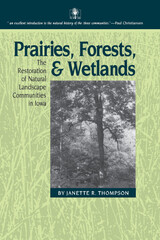 Prairies Forests And Wetlands: Natural Landscape Communities
Janette R. Thompson
University of Iowa Press, 1992 Before Euro-American settlement, graceful prairies and prairie-wetland complexes dominated Iowa's rolling landscape, with forest communities hugging rivers and streams and savannas or forests covering the southern and eastern portions of the state. During the last 150 years these original natural communities have nearly been eliminated by conversion of over 95 percent of the land to agricultural and urban uses. This timely, practical book combines a nontechnical natural history of each native community with a how-to manual for lay restorationists dedicated to reconstructing prairies, forests, and wetlands. Thompson intelligently presents the collective experience of professionals active in restoring the splendid natural areas of Iowa and the greater Midwest—discussing site selection, site preparation, plant species, planting techniques, costs, and maintenance of restoration areas. She includes a useful list of sources for plant materials in and near Iowa as well as information on the birds and mammals, reptiles and amphibians of these landscapes. Prairies, Forests, and Wetlands will help individual landowners, farmers, landscape architects, D.O.T. engineers, teachers, botanists, county conservation boards, and wildlife area managers in their private and professional campaigns to reclaim Iowa's land.
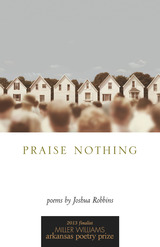 Praise Nothing: Poems
Joshua Robbins
University of Arkansas Press, 2013 In Praise Nothing, Joshua Robbins writes from a suburban landscape of strip mall bars and vacant lots in which addicts and itinerant preachers, hymns and the turnpike's whine are all made to confess, to testify to the hard truths of faith and doubt in middle-class America. In this arresting and finely crafted debut collection, readers travel a via negativa of sidewalk weeds and patched asphalt that meanders past cheap motels and laundromats, trailer parks, and corner churches to a place where a truant God aimlessly and endlessly drives the neighborhood, where birds sing their "fevered hymn / over the dusty tract house roofs" and even the "gravel-throated hallelujahs of dumpsters" profess that "no one is looking for the infinite." Populated with figures as diverse as Janis Joplin, Ronald Reagan, the Big Bopper, and Søren Kierkegaard, these poems are wrought by reverence and skepticism. Praise Nothing navigates the religious, the political, and the sublime. In the lyric tradition of Gerard Manley Hopkins's Terrible Sonnets and James Wright's odes to the Midwest, Robbins's compassionate poems sing of our broken connection to the transcendent. Robbins shows us that if there is anything left to praise, it is Nothing. Praise Nothing is part of the University of Arkansas Press Poetry series, edited by Enid Shomer.
Praise of Folly
Desiderius Erasmus; Translated by John Wilson
University of Michigan Press, 1958 The Praise of Folly by Desiderius Erasmus is an enduring classic that satirically critiques the societal and religious norms of its time. Translated by John Wilson in 1668, this seminal work uses wit and humor to examine the folly prevalent in various human behaviors and institutions, making it a timeless piece that continues to resonate. With a foreword by Kenneth E. Boulding, this edition delves into the essence of folly through a monologue by the allegorical character, Folly herself. She extols the virtues of foolishness in a world riddled with pretentious wisdom and self-importance. Erasmus, with his sharp intellect and playful prose, not only entertains but also provokes deep reflection on the paradoxes of human nature and the pursuit of wisdom, making The Praise of Folly a profound yet accessible read for anyone interested in literature, philosophy, and social commentary.
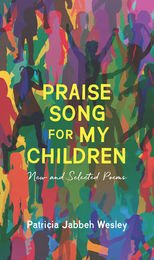 Praise Song for My Children: New and Selected Poems
Patricia Jabbeh Wesley
Autumn House Press, 2020 Praise Song for My Children celebrates twenty-one years of poetry by one of the most significant African poets of this century. Patricia Jabbeh Wesley guides us through the complex and intertwined highs and lows of motherhood and all the roles that it encompasses: parent, woman, wife, sister, friend. Her work is deeply personal, drawing from her own life and surroundings to convey grief, the bleakness of war, humor, deep devotion, and the hope of possibility. These poems lend an international voice to the tales of motherhood, as Wesley speaks both to the African and to the Western experience of motherhood, particularly black motherhood. She pulls from African motifs and proverbs, utilizing the poetics of both the West and Africa to enrich her striking emotional range. Leading us to the depths of mourning and the heights of tender love, she responds to American police brutality, writing “To be a black woman is to be a woman, / ready to mourn,” and remembers a dear friend who is at once “mother and wife and friend and pillar / and warrior woman all in one.”
Wesley writes poetry that moves with her through life, land, and love, seeing with eyes that have witnessed both national and personal tragedy and redemption. Born in Tugbakeh, Liberia and raised in Monrovia, Wesley immigrated to the United States in 1991 to escape the Liberian civil war. In this moving collection, she invites us to join her as she buries loved ones, explores long-distance connections through social media, and sings bittersweet praises of the women around her, of mothers, and of Africa.
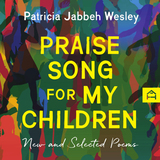 Praise Song for My Children: New and Selected Poems
Patricia Jabbeh Wesley
Autumn House Press, 2022 Praise Song for My Children celebrates twenty-one years of poetry by one of the most significant African poets of this century. Patricia Jabbeh Wesley guides us through the complex and intertwined highs and lows of motherhood and all the roles that it encompasses: parent, woman, wife, sister, friend. Her work is deeply personal, drawing from her own life and surroundings to convey grief, the bleakness of war, humor, deep devotion, and the hope of possibility. These poems lend an international voice to the tales of motherhood, as Wesley speaks both to the African and to the Western experience of motherhood, particularly black motherhood. She pulls from African motifs and proverbs, utilizing the poetics of both the West and Africa to enrich her striking emotional range. Leading us to the depths of mourning and the heights of tender love, she responds to American police brutality, writing “To be a black woman is to be a woman, / ready to mourn,” and remembers a dear friend who is at once “mother and wife and friend and pillar / and warrior woman all in one.”
Wesley writes poetry that moves with her through life, land, and love, seeing with eyes that have witnessed both national and personal tragedy and redemption. Born in Tugbakeh, Liberia and raised in Monrovia, Wesley immigrated to the United States in 1991 to escape the Liberian civil war. In this moving collection, she invites us to join her as she buries loved ones, explores long-distance connections through social media, and sings bittersweet praises of the women around her, of mothers, and of Africa.
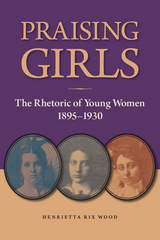 Praising Girls: The Rhetoric of Young Women, 1895-1930
Henrietta Rix Wood
Southern Illinois University Press, 2016 In Praising Girls, Henrietta Rix Wood explores how ordinary schoolgirls engaged in extraordinary rhetorical activities during the late nineteenth and early twentieth centuries in the United States. Focusing on high school girls’ public writing, Wood analyzes newspaper editorials and articles, creative writing projects, yearbook entries, and literary magazines, revealing how young women employed epideictic rhetoric—traditionally used to praise and blame in ceremonial situations—to define their individual and collective identities. Many girls, Wood argues, intervened rhetorically in national and international discourses on class, race, education, immigration, racism, and imperialism, confronting the gender politics that denigrated young women and often deprived them of positions of authority.
The site of the study—Kansas City, Missouri—reflects the diverse rhetorical experiences of girls in cities across the United States at the beginning of the last century. Four case studies examine the writing of privileged white girls at a college preparatory school, Native American girls at an off-reservation boarding school, African American girls at a segregated high school, and working- and middle-class girls at a large whites-only public high school. Wood’s analysis reveals a contemporary concept of epideictic rhetoric that accounts for issues of gender, race, class, and age.
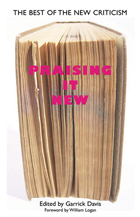 Praising It New: The Best of the New Criticism
Garrick Davis
Ohio University Press, 2008 Marked by a rigorously close textual reading, detached from biographical or other extratextual material, New Criticism was the dominant literary theory of the mid-twentieth century. Since that time, schools of literary criticism have arisen in support of or in opposition to the approach advocated by the New Critics. Nonetheless, the theory remains one of the most important sources for groundbreaking criticism and continues to be a controversial approach to reading literature.
Praising It New is the first anthology of New Criticism to be printed in fifty years. It includes important essays by such influential poets and critics as T. S. Eliot, Ezra Pound, John Crowe Ransom, Allen Tate, Yvor Winters, Cleanth Brooks, R. P. Blackmur, W. K. Wimsatt, and Robert Penn Warren. Together, these authors ushered in the modernist age of poetry and criticism and transformed the teaching of literature in the schools. As the American poet and critic Randall Jarrell once noted: “I do not believe there has been another age in which so much extraordinarily good criticism of poetry has been written.”
This anthology now makes much of the best American poetry criticism available again, and includes short biographies and selected bibliographies of its chief figures. Praising It New is the perfect introduction for students to the best American poetry criticism of the twentieth century.
Prater Violet
Christopher Isherwood
University of Minnesota Press, 2001
Pray for Yourself and Other Stories
Anne Calcagno
Northwestern University Press, 1993 Anne Calcagno's exhilaratingly original first collection of short stories vividly captures the textures of women's lives. Her style is at once idiomatic and metaphorical; her dramatic situations are extreme, edgy, and utterly convincing. Calcagno's characters grapple with problems ranging from domestic violence to obsession with body weight, and speak with conviction and authority about the complex obstacles in their lives. She writes of the desperation of fragile families, of sibling rivalries, of husbands and wives hanging onto or running from each other.
Prayer and Play in Late Tokugawa Japan: Asakusa Sensōji and Edo Society
Nam-lin Hur
Harvard University Press, 2000 The unique amalgam of prayer and play at the Sensōji temple in Edo is often cited as proof of the “degenerate Buddhism” of the Tokugawa period. This investigation of the economy and cultural politics of Sensōji, however, shows that its culture of prayer and play reflected changes taking place in Tokugawa Japan, particularly in the city of Edo. Play was an integral part of the business of religion at Sensōji, and the temple supplied both in equal measure to often rootless Edoites.
Nam-lin Hur’s reappraisal of prayer and play and their inherent connectedness provides a cultural critique of conventional scholarship on Tokugawa religion and shows how Edo commoners incorporated cultural politics into their daily lives through the pursuit of prayer and play.
 Prayer and Power: George Herbert and Renaissance Courtship
Michael C. Schoenfeldt
University of Chicago Press, 1991 Michael C. Schoenfeldt here offers the first major exploration of the connections between George Herbert's devotional poetry and the social practices and political discourse of his day. Viewing The Temple and The Country Parson as part of the larger "civilizing process" of Western Europe, Schoenfeldt shows how Herbert discovers in the discourses of courtesy and theology a common vocabulary of authority, selfhood, petition, and discipline.
Before entering the priesthood, Herbert nourished contacts in court, was elected University Orator at Cambridge, and served in Parliament. In turning to God, Schoenfeldt argues, Herbert did not simply turn away from the secular world but also turned its language, particularly the language of courtesy, into the medium for his lyric worship of God. The confluence of courtesy and spirituality in Herbert's poetry provides a fascinating insight into a society searching for an appropriate discourse of reverence in a time of baffling change. The first five chapters investigate the manifold ways in which Herbert's life and works exemplify the interdependence of social and religious behavior in the English Renaissance. The sixth and final chapter extends this investigation into the nervous eroticism of Herbert's poems.
Considering The Temple as well as Herbert's letters, speeches, Latin poems, collections of foreign proverbs, translations, The Country Parson, and less familiar lyrics, Schoenfeldt offers a thorough and detailed reading of Herbert's rich and conflicted corpus. Prayer and Power is not only a bold redefinition of the accomplishment of one of the finest poets of the English Renaissance but also the first sustained study to advance a cultural poetics of the religious lyric.
Prayer: Christian and Muslim Perspectives
David Marshall and Lucinda Mosher, Editors. Afterword by Rowan Williams
Georgetown University Press, 2016 Prayer: Christian and Muslim Perspectives is a rich collection of essays, scriptural texts, and personal reflections featuring leading scholars analyzing the meaning and function of prayer within their traditions. Drawn from the 2011 Building Bridges seminar in Doha, Qatar, the essays in this volume explore the devotional practices of each tradition and how these practices are taught and learned. Relevant texts are included, with commentary, as are personal reflections on prayer by each of the seminar participants. The volume also contains a Christian reflection on Islamic prayer and a Muslim reflection on Christian prayer. An extensive account of the informal conversations at the seminar conveys a vivid sense of the lively, penetrating, but respectful dialogue that took place.
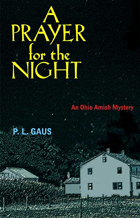 A Prayer for the Night: An Ohio Amish Mystery
P. L. Gaus
Ohio University Press, 2006 Amid a whirlwind of drugs, sex, and other temptations of the “English” world, a group of Amish teenagers on their Rumschpringe test the limits of their parents’ religion to the breaking point. The murder of one and the abduction of another challenge Professor Michael Branden as he confronts the communal fear that the young people can never be brought home safely. Along with Holmes County Sheriff Bruce Robertson and Pastor Cal Troyer, Professor Branden works against the clock to find a murderer and a kidnapper, and to break a drug ring operating in the county, determined, wherever the trail may lead him, to restore the shattered community. In his desperate search, Branden struggles with the reluctance of the Amish to trust the law to help them find the answers to their problems. In A Prayer for the Night, his fifth Ohio Amish Mystery, P. L. Gaus deftly balances the pace and practices of Amish life in northern Ohio against the unfolding urgency of a hostage situation. As Gaus has proven before, the mystery gains from its exploration of the ever-widening chasm between the traditional life of the Amish people and their interaction with the outside world.
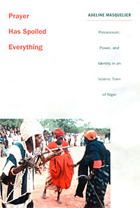 Prayer Has Spoiled Everything: Possession, Power, and Identity in an Islamic Town of Niger
Adeline Masquelier
Duke University Press, 2001 Bori, in the Mawri society of Niger, are mischievous and invisible beings that populate the bush. Bori is also the practice of taming these wild forces in the context of possession ceremonies. In Prayer Has Spoiled Everything Adeline Masquelier offers an account of how this phenomenon intervenes—sometimes subtly, sometimes dramatically—in human lives, providing a constantly renewed source of meaning for Mawri peasants confronted with cultural contradictions and socio-economic marginalization.
To explore the role of bori possession in local definitions of history, power, and identity, Masquelier spent a total of two years in Niger, focusing on the diverse ways in which spirit mediums share, transform, and contest a rapidly changing reality, threatened by Muslim hegemony and financial hardship. She explains how the spread of Islam has provoked irreversible change in the area and how prayer—a conspicuous element of daily life that has become virtually synonymous with Islamic practice in this region of west Africa—has thus become equated with the loss of tradition. By focusing on some of the creative and complex ways that bori at once competes with and borrows from Islam, Masquelier reveals how possession nonetheless remains deeply embedded in Mawri culture, representing more than simple resistance to Islam, patriarchy, or the state. Despite a widening gap between former ways of life and the contradictions of the present, it maintains its place as a feature of daily life in which villagers participate with varying degrees of enthusiasm and approval.
Specialists in African studies, in the anthropology of religion, and in the historical transformations of colonial and postcolonial societies will welcome this study.
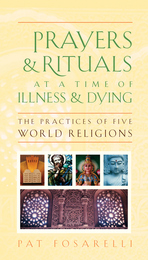 Prayers and Rituals at a Time of Illness and Dying: The Practices of Five World Religions
Patricia Fosarelli
Templeton Press, 2008 In the course of caring for the ill or dying, health care professionals are sometimes the only ones available to provide spiritual comfort to their patients. In our modern pluralistic society, where patients could come from any number of religious traditions, it can often be difficult to find exactly the right words in these situations. Prayers and Rituals at a Time of Illness and Dying: The Practices of Five World Religions by experienced physician and theologian Pat Fosarelli offers clear instructions for health care professionals on how to better understand the needs of their Buddhist, Hindu, Muslim, Christian, and Jewish patients during these difficult times. Devoting separate chapters to each tradition, Fosarelli briefly outlines the basic beliefs and then looks at the main tenets of each religion, exploring the varied approaches that they take to illness and end-of-life issues. For each tradition, she also describes practices and offers suitable prayers. Each chapter suggests modifications that may be necessary for Western hospitals, modifications for children, and specific suggestions about what not to do or say in respect to different faith traditions. This easy-to-use, pocket-sized resource will be referenced again and again by physicians, paramedics, hospital and military chaplains, pastoral counselors, hospice providers, and other medical professionals.
Prayers and the Construction of Israelite Identity
Susanne Gillmayr-Bucher
SBL Press, 2019 Substantial insights into various identity discourses reflected in the biblical prayers
This collection of essays from an international group of scholars focuses on how biblical prayers of the Persian and early Hellenistic periods shaped identity, evoked a sense of belonging to specific groups, and added emotional significance to this affiliation. Contributors draw examples from different biblical texts, including Genesis, Samuel, Kings, Chronicles, Ezra and Nehemiah, Psalms, Jonah, and Daniel.
Features
- Thorough study of prayers that play a key role for a biblical book’s (re)construction of the people’s history and identity
- An examination of ways biblical figures are remodeled by their prayers by introducing other, sometimes even contradictory, discourses on identity
- An exploration of different ways in which psalms from postexilic times shaped, reflected, and modified identity discourses
Prayers for Dark People
W.E.B. Du Bois
University of Massachusetts Press, 1980 A collection of prayers written by Du Bois for students at Atlanta University, thoughtfully compiled and introduced by Herbert Aptheker. These prayers are deeply commited to paying attention to and caring for the inner lives of black Americans. Biblical familiarity and agnosticity are both present in these autobiographical writings, uplifting the hopes and practices of W. E. B. Du Bois's life, while meditating on the still relevant question of how to make "a good life for all".
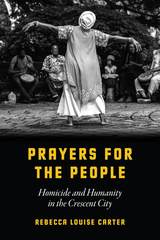 Prayers for the People: Homicide and Humanity in the Crescent City
Rebecca Louise Carter
University of Chicago Press, 2019 “Grieve well and you grow stronger.” Anthropologist Rebecca Louise Carter heard this wisdom over and over while living in post-Katrina New Orleans, where everyday violence disproportionately affects Black communities. What does it mean to grieve well? How does mourning strengthen survivors in the face of ongoing threats to Black life?
Inspired by ministers and guided by grieving mothers who hold birthday parties for their deceased sons, Prayers for the People traces the emergence of a powerful new African American religious ideal at the intersection of urban life, death, and social and spiritual change. Carter frames this sensitive ethnography within the complex history of structural violence in America—from the legacies of slavery to free but unequal citizenship, from mass incarceration and overpolicing to social abandonment and the unequal distribution of goods and services. And yet Carter offers a vision of restorative kinship by which communities of faith work against the denial of Black personhood as well as the violent severing of social and familial bonds. A timely directive for human relations during a contentious time in America’s history, Prayers for the People is also a hopeful vision of what an inclusive, nonviolent, and just urban society could be.
 Prayers in the Precincts: The Christian Right in the 1998 Elections
John C. Green, Mark J. Rozell, and Clyde Wilcox, Editors
Georgetown University Press, 2000 In the wake of the Clinton-Lewinsky scandal, the Christian Right expected major victories in the 1998 elections. Instead, many of its allies lost close contests, and the movement was seen as a liability in some high-profile campaigns. In the only in-depth study of the Christian Right's role in these races, leading scholars analyze the role of the movement in fourteen key states, from Maine to California, and address speculations that the movement is fading from the American political scene. The book focuses on elections on the state and local levels, where the Christian Right is most influential, and it describes the movement's niche in some detail. Although each campaign described in the book had its unique characteristics, the editors have drawn some broad conclusions about the 1998 elections. While the movement was weak in the areas of candidate recruitment and fundraising, they say, the outcome may have also been related to external factors including a broader turnout of typically Democratic constituencies and the country's boredom with the scandal that conservatives had made the centerpiece of their campaign. Despite the setbacks of 1998, the contributors argue, the Christian Right continues to have an enormous influence on the political dialogue of the country. Written from an unbiased, nonpartisan perspective, this volume sheds light on a topic that is too frequently mired in controversy.
The Prayers of Kierkegaard
Edited by Perry D. LeFevre
University of Chicago Press, 1996 Soren Kierkegaard's influence has been felt in many areas of human thought from theology to psychology. The nearly one hundred of his prayers gathered here from published works and private papers, not only illuminate his own life of prayer, but speak to the concerns of Christians today.
The second part of the volume is a reinterpretation of the life and thought of Kierkegaard. Long regarded as primarily a poet or a philosopher, Kierkegaard is revealed as a fundamentally religious thinker whose central problem was that of becoming a Christian, of realizing personal existence. Perry D. LeFevre's penetrating analysis takes the reader to the religious center of Kierkegaard's world.
 Prayers of the Faithful: The Shifting Spiritual Life of American Catholics
James P. McCartin
Harvard University Press, 2010 A hundred years ago Catholic believers young and old, rich and poor, would fill churches on holy days, drawn together in prayer and in the conviction that they, the laypeople, needed the clergy and patron saints to mediate between them and their God. Today a Catholic believer in America is as likely as not to find God for herself.
This book traces dramatic changes in the practice of faith among American Catholics through evolving ideas about prayer. Where so many have seen the movement of American Catholics away from traditional devotional practices as a symptom of encroaching secularism, author James P. McCartin shows how the changing practice of prayer itself was the primary catalyst behind Catholics’ growing sense of spiritual independence.
Prayers of the Faithful reveals how, over the decades, Catholics’ ways of praying underwent a significant shift alongside the larger transformations of American society and culture. The book documents the novel ways of praying that transcended the formal rites of earlier generations. Whether “praying in tongues” or working on behalf of social justice or participating in public protests as outpourings of prayer, lay Catholics consistently expanded their notions of praying. And in doing so, McCartin suggests, they reshaped and redefined American Catholicism. By examining the spiritual life of prayer over the twentieth century, this book thus opens up new ways of understanding Catholics, their church, and their place in American life.
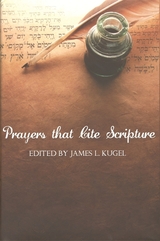 Prayers that Cite Scripture: Biblical Quotation in Jewish Prayers from Antiquity through the Middle Ages
James L. Kugel
Harvard University Press, 2006 In the beginning, prayers were straightforward: people turned to God and asked for help. By the closing centuries of the biblical period, however, a change became observable. Prayers now began to include references to Scripture--allusions to biblical stories in which God had answered a prayer, or the evocation of specific biblical passages, or the recycling of biblical phrases in the creation of a new prayer. This process, the "Scripturalization of prayer," grew in intensity and refinement as Judaism moved from the biblical period to early post-biblical times. It is attested throughout the prayers found in the biblical apocrypha and pseudepigrapha, the Dead Sea Scrolls, and early piyyut, and it continued apace in the liturgical compositions of the Geonic period and still later times. This collection of essays seeks to chart the main lines of the Scripturalization of prayer over this entire period.
Praying for Power: Buddhism and the Formation of Gentry Society in Late-Ming China
Timothy Brook
Harvard University Press, 1993 In seventeenth- and eighteenth-century China, Buddhists and Confucians alike flooded local Buddhist monasteries with donations. As gentry numbers grew faster than the imperial bureaucracy, traditional Confucian careers were closed to many; but visible philanthropy could publicize elite status outside the state realm. Actively sought by fundraising abbots, such patronage affected institutional Buddhism.
After exploring the relation of Buddhism to Ming Neo-Confucianism, the growth of tourism to Buddhist sites, and the mechanisms and motives for charitable donations, Timothy Brook studies three widely separated and economically dissimilar counties. He draws on rich data in monastic gazetteers to examine the patterns and social consequences of patronage.
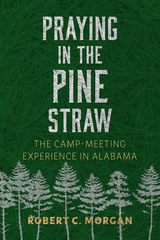 Praying in the Pine Straw: The Camp-Meeting Experience in Alabama
Robert C. Morgan
University of Alabama Press, 2025 Step into the South’s brush arbors and piney woods where faith runs deep, stories run wild, and the old-time camp meeting was anything but quiet. Praying in Pine Straw immerses readers in the raw, rollicking, and deeply human world of Alabama’s camp meetings—a Southern tradition where fire-and-brimstone preaching echoed through pine forests and where faith was often accompanied by contradiction. From “treeing the Devil” to “holy laughter,” these revivals blended heartfelt worship with all the complications of human nature. Mule-drawn wagons brought the faithful to rustic camps, where gospel fervor mingled with whiskey traders, local politicians, and opportunists of every kind. Preachers thundered against sin—even as they sometimes flirted with it themselves. Robert C. Morgan offers a textured portrait of camp meetings as both spiritual experience and cultural spectacle, reviving a Southern tradition that flourished from the late nineteenth to mid-twentieth centuries. With a blend of humor and keen insight, Praying in the Pine Straw unveils the enduring contradictions of “old-time religion” and its significant influence on Southern culture and faith—a legacy that is both treasured and complex.
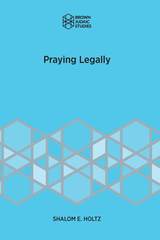 Praying Legally
Shalom E. Holtz
SBL Press, 2019 Explore the lengthy history of legal metaphors in ancient prayer
In biblical and other ancient Near Eastern sources, prayer is an opportunity to make one’s case before divine judges. Prayers were formulated using courtroom or trial language, including demands for judgment, confessions, and accusations. The presence of these legal concepts reveals ancient Near Eastern thoughts about what takes place when one prays. Holtz highlights legal concepts that appear in prayers, including the motif of the speakers' oppression in Psalms the possibility of countersuit against God through prayer, and divine attention and inattention as legal responses. By reading ancient prayers together with legal texts, this book shows how speakers took advantage of prayer as an opportunity to have their day in the divine court and even sue against divine injustice.
Features
- Identification of legal vocabulary and concepts that appear in ancient prayers
- Analysis of legal metaphors in prayer examples in Akkadian and postbiblical rabbinic texts
- Interpretations of trial records and texts from Psalms and Lamentations
Praying Naked
Katie Condon
Ohio State University Press, 2020 Through language both reverent and reckless, Katie Condon’s debut collection renders the body a hymn. Praying Naked is Eden in the midst of the fall, the meat of the apple sweet as sex. In this collection, God is a hopeless and dangerous flirt, mothers die and are resurrected, and disappointing lovers run like hell for the margins. With effortless swagger and confessional candor, Condon lays bare the thrill of lust and its subsequent shame. In poems brimming with “the desire / to be desired” by men, by God, by lovers’ other women, by oneself, she renders a world in which wildflowers are coated in ash and dark bedrooms flicker with the blue light of longing. The speaker implores like an undressed wound: “is it wrong to feel a hurt kind of beautiful?” Ecstatic and incisive, Praying Naked is a daring sexual and spiritual reckoning by a breathtaking new poet.
 Praying the Psalms in Christ
Laurence Kriegshauser, O.S.B.
University of Notre Dame Press, 2009
Written centuries before Christ, the Psalms of the Hebrew Bible have been prayed by Christians since the founding of the Church. The early church fathers expounded the psalms in the light of the mystery of Christ, his death and resurrection, and his saving redemption. In this book, a Benedictine monk examines the Christian praying of the Psalms, taking into account modern and contemporary research on the Psalms. Working from the Hebrew text, Fr. Laurence Kriegshauser offers a verse-by-verse commentary on each of the one hundred and fifty psalms, highlighting poetic features such as imagery, rhythm, structure, and vocabulary, as well as theological and spiritual dimensions and the relation of psalms to each other in the smaller collections that make up the whole. The book attempts to integrate modern scholarship on the Psalms with the act of prayer and help Christians pray the psalms with greater understanding of their Christological meaning.
The book contains an introduction, a glossary of terms, an index of topics, a table of English renderings of selected Hebrew words, and an index of biblical citations.
Praying the Psalms in Christ will be welcomed by students of theology and liturgy, by priests, religious, and laypeople who pray the Liturgy of the Hours, and by all Christians who seek to pray the Psalms with greater profit and fervor.
“It is no easy task to combine devotion with scholarship. From the introduction onwards this book breathes a prayerfulness that lifts the heart to God. With contemporary linguistic, literary, and theological scholarship, it joins the rich tradition of the Church expressed over the centuries in the writings of the Fathers. Each psalm is given a striking image as a sort of ‘logo’ and then discussed for itself. A special feature of the book is the appreciation that the prayer of the psalms in Christ is interwoven, threads of one bringing richness to another.” —Dom Henry Wansbrough, Master Emeritus of St. Benet’s Hall, Oxford
“In Praying the Psalms in Christ, Fr. Kriegshauser has given us a form of reading the psalms that runs very close in intention to that ancient practice of lectio divina where the text of the bible is read prayerfully as a form of contemplative prayer. His prayerful study is made all the more rich by the abundant cross references to other places in the bible, both Old and New Testaments, that add richness to the text. The result is an informative and spiritually nourishing companion to reading the psalms.” —Lawrence S. Cunningham, University of Notre Dame
"Clear, accessible, and rooted in the tradition, Praying the Psalms in Christguides us into the ancient prayers of Israel and the Church. The result is a fresh contribution to the great Christian tradition of spiritual commentary.” —Russell R. Reno, Creighton University
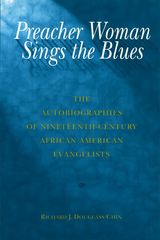 Preacher Woman Sings the Blues: The Autobiographies of Nineteenth-Century African American Evangelists
Richard J. Douglass-Chin
University of Missouri Press, 2001 In this thorough and detailed study, Richard Douglass-Chin examines collectively for the first time the autobiographies of nineteenth-century African American women evangelists, along with their eighteenth-century forerunner "Belinda." By studying how black women evangelists employed dialogue created by socioeconomic conditions, the author shows how their writings form the groundwork for a contemporary womanist literature rooted in spirituality. Arguing that the writings have their own unique figurations and forms that develop and alter over time, Douglass-Chin claims that the changing black female spiritual narrative traces an important line in the ongoing traditions of black women's writing, a line that has only now begun to be reclaimed and validated. Through references to the writings of black male autobiographers Frederick Douglass, Richard Allen, Daniel Payne, and John Jea as well as the works of white female autobiographers Harriet Livermore and Phoebe Palmer, Douglass-Chin is able to make valuable comparisons. Preacher Woman Sings the Blues begins with the study of black evangelists Belinda, Jarena Lee, and Zilpha Elaw, continuing with Rebecca Cox Jackson, Sojourner Truth, Julia Foote, Amanda Smith, Elizabeth, and Virginia Broughton. The author's discussion of Zora Neale Hurston focuses on how Hurston operates as a connection between early black women evangelist writers and black women writing in America today. He ends with the works of Alice Walker, Toni Morrison, and Toni Cade Bambara. By examining the early traditions prefiguring contemporary African American women's texts and the impact that race and gender have on them, Douglass-Chin shows how the nineteenth-century black women's works are still of utmost importance to many African American women writers today. Preacher Woman Sings the Blues makes a valuable contribution to literary criticism and theoretical analysis and will be welcomed by scholars and students alike.
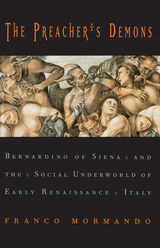 The Preacher's Demons: Bernardino of Siena and the Social Underworld of Early Renaissance Italy
Franco Mormando
University of Chicago Press, 1999 "When the city was filled with these bonfires, he then combed the city, and whenever he received notice of some public sodomite, he had him immediately seized and thrown into the nearest bonfire at hand and had him burned immediately." This story, of an anonymous individual who sought to cleanse medieval Paris, was part of a sermon delivered in Siena, Italy, in 1427. The speaker, the friar Bernardino (1380-1444), was one of the most important public figures of the time, and he spent forty years combing the towns of Italy, instructing, admonishing, and entertaining the crowds that gathered in prodigious numbers to hear his sermons.
His story of the Parisian vigilante was a recommendation. Sexual deviants were the objects of relentless, unconditional persecution in Bernardino's sermons. Other targets of the preacher's venom were witches, Jews, and heretics. Mormando takes us into the social underworld of early Renaissance Italy to discover how one enormously influential figure helped to dramatically increase fear, hatred, and intolerance for those on society's margins.
This book is the first on Bernardino to appear in thirty-five years, and the first ever to consider the preacher's inflammatory role in Renaissance social issues.
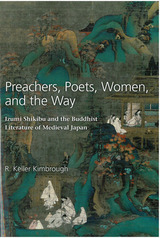 Preachers, Poets, Women, and the Way: Izumi Shikibu and the Buddhist Literature of Medieval Japan
R. Keller Kimbrough
University of Michigan Press, 2008 According to a sixteenth-century Japanese commentary on the Lotus Sutra, the venerable Chinsō Kashō was once preaching on the “ten wickednesses of women” when an angry old nun stepped out from the audience and shouted, “It’s not just women who are so evil—you’ve got plenty of wickedness in you, too!” Women were reviled in much of the popular Buddhist rhetoric of medieval Japan, castigated for their “filthy femininity,” but their low spiritual status was in fact frequently contested. This dispute over the place of women in Buddhism was often played out in the realm of medieval preachers’ and storytellers’ apocryphal tales of the lives, deaths, and inevitable religious awakenings of prominent female literary figures of an earlier age. Inspired by the folklorist Yanagita Kunio’s groundbreaking work of the early 1930s, Preachers, Poets, Women, and the Way explores the ways in which such fictional and usually scandalous stories of the Heian women authors Izumi Shikibu, Ono no Komachi, Murasaki Shikibu, and Sei Shōnagon were employed in the competitive preaching and fund-raising of late-Heian and medieval Japan. The book draws upon a broad range of medieval textual and pictorial sources to describe the diverse and heretofore little-studied roles of itinerant and temple-based preacher-entertainers in the formation and dissemination of medieval literary culture. By plumbing the medieval roots of Heian women poets’ contemporary fame, Preachers, Poets, Women, and the Way illuminates a forgotten world of doctrinal and institutional rivalry, sectarian struggle, and passionately articulated belief, revealing the processes by which Izumi Shikibu and her peers came to be celebrated as the national cultural icons that they are today.
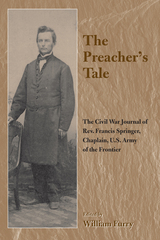 The Preacher's Tale: The Civil War Journal of Rev. Francis Springer, Chaplain, U.S. Army of the Frontier
William Furry
University of Arkansas Press, 2001 In the fall of 1861, fifty-one-year-old Rev. Francis Springer enlisted in the Union army. The following spring, Springer, a friend and one-time neighbor to Abraham Lincoln, rode away with the 10th Illinois Cavalry. A witness to the Battle of Prairie Grove (December 1862), Springer was later named post chaplain at Fort Smith, where, in additon to preaching and ministering to the troops, he was placed in charge of refugees—widows, orphans, and contrabands—the displaced victims of virulent guerrilla warfare in Northwest Arkansas. Springer also wrote articles and columns in the Fort Smith New Era under the pseudonym, “Thrifton.” Springer’s honest appraisals of life in the Army of the Frontier make for fascinating reading, and his unique perspective as moralist, educator, and journalist provide new insight into the Civil War and how it was fought in the West. The book includes several never-before published photographs and appendixes which feature accounts of six military executions that Springer participated in as a Union Army chaplain, the hitherto unpublished last letters home of two rebel soldiers condemned and executed at Fort Smith, as well as a eulogy for Abraham Lincoln. The Preacher’s Tale includes several never before published photographs, and appendixes that contain accounts of six military executions that Springer participated in as a Union Army chaplain, the last letters home of two rebel soldiers condemned and executed at Fort Smith, as well as a eulogy written for Abraham Lincoln.
 Preaching and the Rise of the American Novel
Dawn Coleman
Ohio State University Press, 2013 Preaching and the Rise of the American Novel by Dawn Coleman recovers a crucial moment in the history of the intimate yet often contentious relationship between religion and literature. Coleman’s book highlights the intersection of two cultural trajectories in America around 1850, both often downplayed in literary histories: a boom in preaching, associated with the growth of evangelicalism and the country’s oratorical traditions, and the long struggle of the novel, still facing considerable disdain at mid-century, to achieve moral legitimacy and aesthetic autonomy. Before the Civil War, the preacher in the pulpit was the culture’s paradigmatic voice of moral authority, and novelists who wished to establish the moral value of their own storytelling needed to incorporate sermons. This book explores how antebellum ministers sought to preach effective, authoritative sermons and how novelists sought to claim a similar authority through canny representations of preachers, often veiled critiques of actual ministers, and sermonic voice, or a creative reworking of the sound of preaching. Such intense engagement with sermons shaped some of the period’s most interesting and important novels, including The Scarlet Letter, The Quaker City, Moby-Dick, Uncle Tom’s Cabin, and Clotel. In illuminating how novelists sought to displace traditional religious institutions, Preaching and the Rise of the American Novel reminds readers of the deep connections between Americans’ religious practices and their literature and speaks to how the processes of secularization are often less concerned with rejecting the elements of religion than reimagining them.
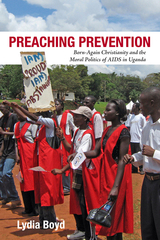 Preaching Prevention: Born-Again Christianity and the Moral Politics of AIDS in Uganda
Lydia Boyd
Ohio University Press, 2015 Preaching Prevention examines the controversial U.S. President’s Emergency Plan for AIDS Relief (PEPFAR) initiative to “abstain and be faithful” as a primary prevention strategy in Africa. This ethnography of the born-again Christians who led the new anti-AIDS push in Uganda provides insight into both what it means for foreign governments to “export” approaches to care and treatment and the ways communities respond to and repurpose such projects. By examining born-again Christians’ support of Uganda’s controversial 2009 Anti-Homosexuality Bill, the book’s final chapter explores the enduring tensions surrounding the message of personal accountability heralded by U.S. policy makers. Preaching Prevention is the first to examine the cultural reception of PEPFAR in Africa. Lydia Boyd asks, What are the consequences when individual responsibility and autonomy are valorized in public health initiatives and those values are at odds with the existing cultural context? Her book investigates the cultures of the U.S. and Ugandan evangelical communities and how the flow of U.S.-directed monies influenced Ugandan discourses about sexuality and personal agency. It is a pioneering examination of a global health policy whose legacies are still unfolding.
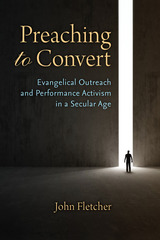 Preaching to Convert: Evangelical Outreach and Performance Activism in a Secular Age
John Fletcher
University of Michigan Press, 2015 Preaching to Convert offers an intriguing new perspective on the outreach strategies of U.S. evangelicals, framing them as examples of activist performance, broadly defined as acts performed before an audience in the hopes of changing hearts and minds. Most writing about activist performance has focused on left-progressive causes, events, and actors. Preaching to Convert argues against such a constricted view of activism and for a more nuanced understanding of U.S. evangelicalism as a movement defined by its desire to win converts and spread the gospel.
The book positions evangelicals as a diverse, complicated group confronting the loss of conservative Christianity’s default status in 21st-century U.S. culture. In the face of an increasingly secular age, evangelicals have been reassessing models of outreach. In acts like handing out Bible tracts to strangers on the street or going door-to-door with a Bible in hand, in elaborately staged horror-themed morality plays or multimillion-dollar creationist discovery centers, in megachurch services beamed to dozens of satellite campuses, and in controversial “ex-gay” ministries striving to return gays and lesbians to the straight and narrow, evangelicals are redefining what it means to be deeply committed in a pluralist world. The book’s engaging style and careful argumentation make it accessible and appealing to scholars and students across a range of fields.
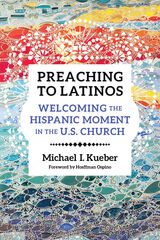 Preaching to Latinos: Welcoming the Hispanic Moment in the U.S. Church
Michael Kueber
Catholic University of America Press, 2022 There is a wide and growing gap in the Catholic Church in the United States between the clergy, who are mostly of European descent, and the large percentages of Catholics who identify as Latinos. While the US Church has made a concerted effort to build Hispanic ministries, many clergy and lay ministers are still ill-equipped to understand the cultural background of their parishioners, especially the large numbers who are foreign born. Because of this disconnect, the Church risks missing "the Hispanic Moment" in the US Church, in which the faith and traditions of these newest waves of US immigration could not just exist in parallel to English-language congregations, but enrich and enliven the faith of the whole community while passing on the faith to subsequent generations.
Learning Spanish--while helpful--is not enough. There are intercultural competencies that can only be developed through practice, but it also helps already-busy clergy to have a concise guide. In addition to knowing the scholarly literature on cross-cultural preaching and Hispanic culture, Father Michael Kueber has twenty years of experience serving first generation Hispanic immigrants and their second generation children. In Preaching to Latinos, Kueber provides the readers with best practices for preaching to and leading their churches. As a member of an ecumenical community, he is able to speak to members of all Christian denominations.
 Precarious Accumulation: Fast Fashion Bosses in Transnational Guangzhou
Nellie Chu
Duke University Press, 2026 In Precarious Accumulation, Nellie Chu tells the story of the migrant entrepreneurs at the heart of Guangzhou’s fast fashion industry—one of the world’s most dynamic hubs of transnational commodity production. Chu shows how rural Chinese migrants, West African traders, and South Korean jobbers navigate the high-speed, low-margin world of just-in-time garment production that fuels the constant accumulation of wealth via global supply chains. Drawing on fieldwork in Guangzhou’s urban villages and household workshops, Chu outlines how these entrepreneurs’ dreams of economic freedom clash with the reality of precarity and the exclusions of emigre status. Migrant bosses operate within a highly competitive, informal economy where they are both agents and target of exploitation, as they must evade rent collectors, endure racialized policing, and mitigate extortion from security officers and competitors. Chu crucially demonstrates how their efforts generate novel forms of migratory labor, commodity production, and cross-cultural exchange in postsocialist China.
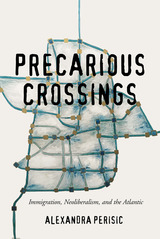 Precarious Crossings: Immigration, Neoliberalism, and the Atlantic
Alexandra Perisic
Ohio State University Press, 2019 With global debt, labor, and environmental crises on the rise, the precarious position of people in the Global South has become a significant force moving people across countries, continents, and around the world. Through a comparative study of contemporary trans-Atlantic immigrant narratives in French, Spanish, and English, Alexandra Perisic offers an account of a multilingual Atlantic under neoliberalism. More specifically, Precarious Crossings: Immigration, Neoliberalism, and the Atlantic examines how contemporary authors from the Caribbean, Sub-Saharan Africa, and Latin America—including Roberto Bolaño, Giannina Braschi, Maryse Condé, Fatou Diome, Marie Ndiaye, and Caryl Phillips, among others—have reconceptualized the Atlantic from a triangular space into a multipolar one, introducing new destinations for contemporary immigrants and establishing new Atlantic connections.
Perisic argues that in traveling beyond the postcolonial route that connects former colonizer and former colonized, these authors also shift their focus from cultural difference and national belonging to precarity—a condition characterized by a lack of economic and social stability and protection—as a shared characteristic under global neoliberalization. She demonstrates how contemporary Atlantic narratives reveal the contradictions inherent in neoliberalism as an ideology—thereby showing how they further participate in Atlantic literary and cultural dialogues and push against literary conventions of various genre as they explore the complexities of a globalized Atlantic.
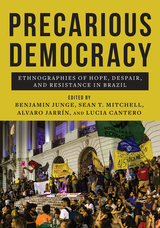 Precarious Democracy: Ethnographies of Hope, Despair, and Resistance in Brazil
Benjamin Junge
Rutgers University Press, 2021 Brazil changed drastically in the 21st century’s second decade. In 2010, the country’s outgoing president Lula left office with almost 90% approval. As the presidency passed to his Workers' Party successor, Dilma Rousseff, many across the world hailed Brazil as a model of progressive governance in the Global South. Yet, by 2019, those progressive gains were being dismantled as the far right-wing politician Jair Bolsonaro assumed the presidency of a bitterly divided country. Digging beneath this pendulum swing of policy and politics, and drawing on rich ethnographic portraits, Precarious Democracy shows how these transformations were made and experienced by Brazilians far from the halls of power. Bringing together powerful and intimate stories and portraits from Brazil's megacities to rural Amazonia, this volume demonstrates the necessity of ethnography for understanding social and political change, and provides crucial insights on one of the most epochal periods of change in Brazilian history.
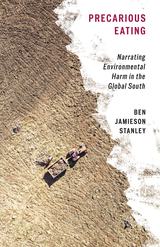 Precarious Eating: Narrating Environmental Harm in the Global South
Ben Jamieson Stanley
University of Minnesota Press, 2024 The role of food and hunger in contemporary South African and Indian environmental writing
From GMOs to vegetarianism and veganism, questions of what we should (and shouldn’t) eat can be frequent sources of debate and disagreement. In Precarious Eating, Ben Jamieson Stanley asks how recentering global South representations of food might shift understandings of environmental precarity. Precarious Eating follows the lead of writers and thinkers in South Africa and India who are tracing the production and consumption of food, exploring ways to reconnect our narratives about climate change, global capitalism, and social justice. Taking up a diverse range of novels, films, scholar/activist writings, intellectual histories, and cookbooks, Stanley connects the ethics of eating to histories of empire and apartheid, uneven globalization, gender and sexuality, and global South experiences of climate change. They shift the lens of environmental humanities from climate-focused paradigms developed in the global North to food-focused environmental culture and activism in the South, addressing topics that range from foraging and farmer suicides to disordered eating and queer intimacy. By highlighting authors, activists, and environments of the global South, Precarious Eating joins with scholarship from postcolonial, decolonial, Indigenous, and Black studies to underscore how capitalism and empire shape our planetary environmental crisis. Retail e-book files for this title are screen-reader friendly with images accompanied by short alt text and/or extended descriptions.
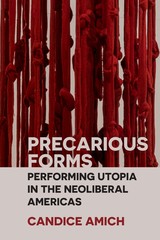 Precarious Forms: Performing Utopia in the Neoliberal Americas
Candice Amich
Northwestern University Press, 2020 Precarious Forms: Performing Utopia in the Neoliberal Americas explores how performance art and poetry convey utopian desires even in the bleakest of times. Candice Amich argues that utopian longing in the neoliberal Americas paradoxically arises from the material conditions of socioeconomic crisis. Working across national, linguistic, and generic boundaries, Amich identifies new political and affective modes of reception in her examination of resistant art forms. She locates texts in the activist struggles of the Global South, where neoliberal extraction and exploitation most palpably reanimate the colonial and imperial legacies of earlier stages of capitalism.
The poets and artists surveyed in Precarious Forms enact gestures of solidarity and mutual care at sites of neoliberal dispossession. In her analysis of poems, body art, and multimedia installations that illuminate the persistence of a radical utopian imaginary in the Americas, Amich engages critical debates in performance studies, Latin American cultural studies, literature, and art history.
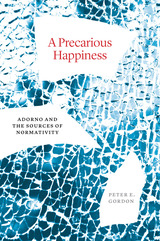 A Precarious Happiness: Adorno and the Sources of Normativity
Peter E. Gordon
University of Chicago Press, 2023 A strikingly original account of Theodor Adorno’s work as a critique animated by happiness.
"Gordon’s confidently gripping and persistently subtle interpretation brings a new tone to the debate about Adorno’s negativism."—Jürgen Habermas
Theodor Adorno is often portrayed as a totalizing negativist, a scowling contrarian who looked upon modern society with despair. Peter E. Gordon thinks we have this wrong: if Adorno is uncompromising in his critique, it is because he sees in modernity an unfulfilled possibility of human flourishing. In a damaged world, Gordon argues, all happiness is likewise damaged but not wholly absent. Through a comprehensive rereading of Adorno’s work, A Precarious Happiness recovers Adorno’s commitment to traces of happiness—fragments of the good amid the bad. Ultimately, Gordon argues that social criticism, while exposing falsehoods, must also cast a vision for an unrealized better world.
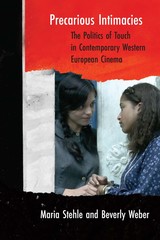 Precarious Intimacies: The Politics of Touch in Contemporary Western European Cinema
Maria Stehle and Beverly Weber
Northwestern University Press, 2020 Drawing on and responding to the writings of theorists such as Judith Butler, Sara Ahmed, Lauren Berlant, and Lisa Lowe, this book proposes the notion of “precarious intimacies” to navigate a dilemma: how to recognize, affirm, and value love, touch, and care while challenging the racialized and gendered politics in which they are embedded.
Twenty-first-century Europe is undergoing dramatic political and economic transformations that produce new forms of transnational contact as well as new regimes of exclusion and economic precarity. These political and economic shifts both circumscribe and enable new possibilities for intimacy. Many European films of the last two decades depict experiences of political and economic vulnerability in narratives of precarious intimacies. In these films, stories of intimacy, sex, love, and friendship are embedded in violence and exclusion, but, as Maria Stehle and Beverly Weber show, the politics of touch and connection also offers avenues to theorize forms of attention and affection that challenge exclusive notions of race, citizenship, and belonging.
Precarious Intimacies examines the aesthetic strategies that respond to this tension and proposes a politics of interpretation that identifies the potential and possibility of intimacy.
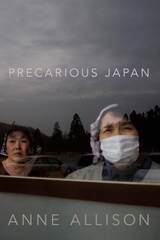 Precarious Japan
Anne Allison
Duke University Press, 2013 In an era of irregular labor, nagging recession, nuclear contamination, and a shrinking population, Japan is facing precarious times. How the Japanese experience insecurity in their daily and social lives is the subject of Precarious Japan. Tacking between the structural conditions of socioeconomic life and the ways people are making do, or not, Anne Allison chronicles the loss of home affecting many Japanese, not only in the literal sense but also in the figurative sense of not belonging. Until the collapse of Japan's economic bubble in 1991, lifelong employment and a secure income were within reach of most Japanese men, enabling them to maintain their families in a comfortable middle-class lifestyle. Now, as fewer and fewer people are able to find full-time work, hope turns to hopelessness and security gives way to a pervasive unease. Yet some Japanese are getting by, partly by reconceiving notions of home, family, and togetherness.
 Precarious Motherhood: Navigating Relationships and Support Post-Migration in the UK
Rachel Benchekroun
University College London, 2025 When the state withdraws support, migrant mothers build their own safety nets—a look at the strategies and struggles of those raising children under immigration insecurity.
Precarious Motherhood is a deeply human investigation of the lives of racially minoritized mothers as they navigate the intersecting challenges of financial hardship and the UK’s hostile immigration policies. Based on thorough ethnographic research, Rachel Benchekroun examines how these mothers forge relationships to access support, maintain their children’s well-being, and carve out spaces of belonging in an often unwelcoming system. The book captures the resilience and the relentless precarity of motherhood in migration, where every relationship shapes social barriers and everyday survival.
Through the voices of over twenty migrant mothers, this work sheds light on the personal and political dimensions of motherhood. It provides critical insights into state policies and social infrastructures that shape migrant lives, making it a valuable resource for scholars of migration and social justice.
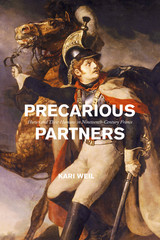 Precarious Partners: Horses and Their Humans in Nineteenth-Century France
Kari Weil
University of Chicago Press, 2020 From the recent spate of equine deaths on racetracks to protests demanding the removal of mounted Confederate soldier statues to the success and appeal of War Horse, there is no question that horses still play a role in our lives—though fewer and fewer of us actually interact with them. In Precarious Partners, Kari Weil takes readers back to a time in France when horses were an inescapable part of daily life. This was a time when horse ownership became an attainable dream not just for soldiers but also for middle-class children; when natural historians argued about animal intelligence; when the prevalence of horse beatings led to the first animal protection laws; and when the combined magnificence and abuse of these animals inspired artists, writers, and riders alike.
Weil traces the evolving partnerships established between French citizens and their horses through this era. She considers the newly designed “races” of workhorses who carried men from the battlefield to the hippodrome, lugged heavy loads through the boulevards, or paraded women riders, amazones, in the parks or circus halls—as well as those unfortunate horses who found their fate on a dinner plate. Moving between literature, painting, natural philosophy, popular cartoons, sports manuals, and tracts of public hygiene, Precarious Partners traces the changing social, political, and emotional relations with these charismatic creatures who straddled conceptions of pet and livestock in nineteenth-century France.
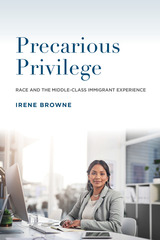 Precarious Privilege: Race and the Middle-Class Immigrant Experience
Irene Browne
Russell Sage Foundation, 2024 In recent years crackdowns on immigrant labor and a shrinking job market in California, Arizona, and Texas have pushed Latine immigrants to new destinations, particularly places in the American South. Although many of these immigrants work in manufacturing or food-processing plants, a growing number belong to the professional middle class. These professionals find that despite their privileged social class and regardless of their national origin, many non-Latines assume that they are undocumented working-class Mexicans, the stereotype of the “typical Latine.” In Precarious Privilege, sociologist Irene Browne focuses on how first-generation middle-class Mexican and Dominican immigrants in Atlanta respond to this stigmatizing assumption.
Browne finds that when asked to identify themselves by race, these immigrants either reject racial identities entirely or draw on belief systems from Mexico and the Dominican Republic that emphasize European-indigenous mixed race identities. When branded as typical Latines in the U.S., Mexican middle-class immigrants emphasize their social class or explain that a typical Latine can be middle-class, while Dominicans simply indicate that they are not Mexican. Rather than blame systemic racism, both Mexican and Dominican middle-class immigrants often attribute misperceptions of their identity to non-Latines’ ignorance or to individual Latines’ lack of effort in trying to assimilate.
But these middle-class Latine immigrants do not simply seek to position themselves on par with the U.S.-born white middle class. Instead, they leverage their cosmopolitanism—for example, their multilingualism or their children’s experiences traveling abroad—to engage in what Browne calls “one-up assimilation,” a strategy that aims to position them above the white middle class, who are often monolingual and unaware of the world outside the United States. Middle-class Latines’ cosmopolitanism and valuing of diversity also lead them to have cordial relations with African Americans, but these immigrants do not see themselves as sharing African Americans’ status as oppressed minorities.
Although the stereotype of the typical Latine has made middle-class Latine immigrants susceptible to stigma, they insist that this stigma does not play a significant role in their lives. In many cases, they view the stereotype as a minor issue, feel that opportunities for upward mobility outweigh any negative experiences, or downplay racism by emphasizing their class privilege. Browne observes that while downplaying racism may help middle-class Latine immigrants maintain their dignity, it also perpetuates inequality by reinforcing the lower status of working-class undocumented immigrants. It is thus imperative, Browne argues, to repeal harsh anti-immigration policies, a move that will not only ease the lives of the undocumented but also send a message about who belongs in the country.
Offering a nuanced exploration of how race, social class, and immigration status intersect, Precarious Privilege provides a complex portrait of middle-class Latine immigrants in the United States today.
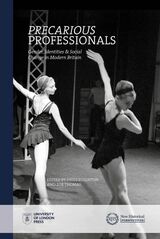 Precarious Professionals: Gender, Identities and Social Change in Modern Britain
Edited by Heidi Egginton and Zoë Thomas
University of London Press, 2021 Precarious Professionals details the fight for equality in the workplace, particularly among women and queer people in nineteenth and twentieth-century Britain.
Precarious Professionals uncovers the inequalities and insecurities which lay at the heart of professional life in nineteenth and twentieth-century Britain. This book challenges conventional categories in the history of work, exploring instead the everyday labor of maintaining a professional identity on the margins of the traditional professions. Situating new historical perspectives on gender at the forefront of their research, the contributors explore how professional cultures could not only define themselves against but often flourished outside of, the confines of patriarchal codes and structures.
Precarious Professionals offers twelve fascinating case studies, ranging between the 1840s and the 1960s. From pioneering female lawyers and scientists to ballet dancers, secretaries, historians, humanitarian relief workers, social researchers, and Cold War diplomats, this book reveals that precarity was a thread woven throughout the very fabric of modern professional life. Together, these essays enrich our understanding of the histories and mysteries of professional identity and help us to reimagine the future of work in precarious times.
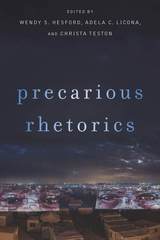 Precarious Rhetorics
Edited by Wendy S. Hesford, Adela C. Licona, and Christa Teston
Ohio State University Press, 2018 Across disciplines, scholars have employed theories of precarity to help explain the pervasiveness of problems related to labor, migration, biopolitics, global and state governance, economies of war and violence, poverty, environmental degradation, and a host of other pressing issues. Precarous Rhetorics is the first work to bring precarity studies to the field of rhetoric and communication—and to couple it with new materialist frameworks—in order to unearth and analyze the material conditions and structuring logics of inequality.
This collection features cross-disciplinary contributions from leading scholars, including the editors of the volume as well as James J. Brown Jr., Gale Coskan-Johnson, Ronald Greene, Lavinia Hirsu, Arabella Lyon, Louis Maraj, Sara McKinnon, Alexandra Schultheis Moore, Kimberlee Pérez, Margaret Price, Amy Shuman, Kristin Swenson, Becca Tarsa, and Belinda Walzer. Chapters emphasize a materialist-rhetorical approach while also drawing on feminist studies, women of color feminisms, affect studies, critical disability studies, critical race and ethnic studies, medical humanities, sexuality studies, queer migration studies, and human rights and humanitarian studies. While theoretically rich, this volume intentionally features chapters that explore precarious rhetorics as they operate in practice—whether in borderlands, politics, public policy, or the quotidian spaces of human activity, such as school, work, social media, and medicine.
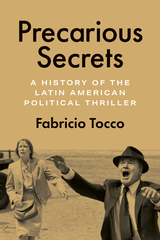 Precarious Secrets: A History of the Latin American Political Thriller
Fabricio Tocco
University of Texas Press, 2025 An exploration of the political thriller genre and its context in Latin American politics and entertainment. For the past five decades, a distinctive type of political thriller has been steadily developing in Latin America. Precarious Secrets is a panoramic overview of the genre in the hands of renowned writers and filmmakers from Argentina, Mexico, Chile, and Brazil, as well as lesser-known Peruvian, Uruguayan and Paraguayan artists for whom the style has been a vehicle for pungent narratives shot through with menace and conspiracy. Fabricio Tocco explores the genre’s unique role in Latin American entertainment and activism. Precarious Secrets traces the evolutions of the Latin American political thriller from its emergence in the 1970s, through the silence imposed by dictatorships and the genre’s resurgence after the Cold War. The political thriller has dramatized the region’s turbulent past, through assassinations, coups, mass killings, revolutions and the search of desaparecidos by human rights organizations. In the process, Tocco isolates the Latin American political thriller’s particular grammar of secrecy. In the Hollywood thriller, revealing secrets involves high stakes and transformative consequences. In Latin American political thrillers, by contrast, secrets produce only more precarity—moral ambiguity as unsettling as it is unshakeable.
 Precarious Spaces: The Arts, Social and Organizational Change
Edited by Katarzyna Kosmala and Miguel Imas
Intellect Books, 2016 Using an arts-based inquiry, Precarious Spaces addresses current concerns around the instrumentality and agency of art in the context of the precarity of daily life. The book offers a survey of socially and community-engaged art practices in South America, focusing in particular on Brazil’s “informal” situation, and contributes much to the ongoing debate of the possibility for change through social, environmental, and ecological solutions. The individual chapters, compiled by Katarzyna Kosmala and Miguel Imas, present a wide spectrum of contemporary social agency models with a particular emphasis on detailed case studies and local histories. Featuring critical reflections on the spaces of urban voids, derelict buildings, self-built communities such as favela, and roadside occupations, Precarious Spaces will make readers question their assumptions about precarity, and life in precarious realms.
 Precarious Workers: History of Debates, Political Mobilization, and Labor Reforms in Italy
Eloisa Betti
Central European University Press, 2023 The recent vast upsurge in social science scholarship on job precarity has generally little to say about earlier forms of this phenomenon. Eloisa Betti’s monograph convincingly demonstrates on the example of Italy that even in the post-war phase of Keynesian stability and welfare state, precarious labor was an underlying feature of economic development. She examines how in this short period exceptional politics of labor stability prevailed. The volume then presents the processes whereby labor precarity regained momentum— under the name of flexibility— in the post-Fordist phase from the early 1980s, taking on new forms in the Craxi and Berlusconi eras. Multiple actors are addressed in the analysis. The book gives voice to intellectuals, scholars, politicians and trade unionists as they have framed the concept and debates on precarious work from the 1950s onwards. Views of labor law experts, politicians and public servants are investigated in regard to labor regulations. Positions of the very precarians are explored, ranging from rural women, industrial homeworkers and blue-collar workers to physicians, university researchers and trainees, unveiling the emergence of anti-precarity social movements. The continuous role of women’s associations and feminist groups in opposing labor precarity since the 1950s is prominently exposed.
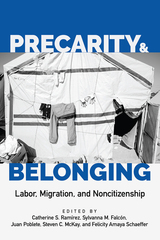 Precarity and Belonging: Labor, Migration, and Noncitizenship
Catherine S. Ramírez
Rutgers University Press, 2021 Precarity and Belonging examines how the movement of people and their incorporation, marginalization, and exclusion, under epochal conditions of labor and social precarity affecting both citizens and noncitizens, have challenged older notions of citizenship and alienage. This collection brings mobility, precarity, and citizenship together in order to explore the points of contact and friction, and, thus, the spaces for a possible politics of commonality between citizens and noncitizens.The editors ask: What does modern citizenship mean in a world of citizens, denizens, and noncitizens, such as undocumented migrants, guest workers, permanent residents, refugees, detainees, and stateless people? How is the concept of citizenship, based on assumptions of deservingness, legality, and productivity, challenged when people of various and competing statuses and differential citizenship practices interact with each other, revealing their co-constitutive connections? How is citizenship valued or revalued when labor and social precarity impact those who seemingly have formal rights and those who seemingly or effectively do not? This book interrogates such binaries as citizen/noncitizen, insider/outsider, entitled/unentitled, “legal”/“illegal,” and deserving/undeserving in order to explore the fluidity--that is, the dynamism and malleability--of the spectra of belonging.
Precarity in Western European Cinema
Temenuga Trifonova
Amsterdam University Press, 2025 This book explores the new European cinema of precarity, with a particular focus on Western European films, by revisiting some of its most important precursors, including 1930s Popular Front films and 1990s French New Realism, Italian neorealism, and the British New Wave. It identifies dominant themes and motifs in contemporary films and their precursors, as well as important continuities and discontinuities between earlier and later representations of work, class, class struggle, solidarity, precarity, the moral economy of capitalism and neoliberalism and their affective pathologies. Trifonova examines the ways in which the cinema of precarity mediates economic and social capital in the age of neoliberalism and considers whether these films lend validity to Guy Standing’s idea of the precariat as “the new dangerous class.”
 Precaution, Environmental Science, and Preventive Public Policy
Edited by Joel A. Tickner
Island Press, 2002 The "precautionary principle"—the idea that society should guard against potentially harmful activities even if some cause and effect relationships have not been fully established—has often been attacked for being unscientific. However leading scientists studying the issue have begun to make the case that the precautionary principle is in fact science based, and that it creates a need for more rigorous and transparent science in examining complex and uncertain environmental risks.Precaution, Environmental Science, and Preventive Public Policy is the first book to explore the role of science in developing a more precautionary approach to environmental and public health policy. The book brings together leading scientists, legal experts, philosophers, environmental health professionals, and environmentalists to offer a multi-disciplinary perspective on the controversial debate over science and precaution. The book:discusses the critical need for science in promoting sustainabilityoutlines the ethical imperative of a more precautionary science and the philosophical foundations of that new approachconsiders some of the ways in which the current conduct of environmental science works against precautionary policiesexamines how the role and use of science differs across cultures and political systemsprovides the components of an approach to environmental science that more effectively supports precautionary decisionsThe book also offers case studies that consider various types of uncertainty and sets forth a framework for evaluating and addressing uncertainty in decision-making.Contributors include Juan Almendares, Katherine Barrett, Kamaljit Bawa, Finn Bro-Rasmussen, Donald Brown, Theofanis Christoforou, Terry Collins, Barry Commoner, Carl Cranor, Stephen Dovers, David Gee, Elizabeth Guillette, Cato ten Hallers-Tjabbes, James Huff, Matthias Kaiser, Richard Levins, Mary O'Brien, Carolyn Raffensperger, Jerry Ravetz, Vandana Shiva, Boyce Thorne-Miller, Joe Thornton, Reginald Victor, and Alistair Woodward.Precaution, Environmental Science, and Preventive Public Policy presents a broad overview of the role of science in implementing the precautionary principle and makes a compelling case that science should be used not just to study problems but to develop solutions.
The Preceramic Horizons of Northeastern Oklahoma
David Albert Baerreis
University of Michigan Press, 1951 David Albert Baerreis reports on the excavation of three sites in Delaware County in northeastern Oklahoma, and the artifacts found there. The author focuses on lithics (projectile points and other chipped stone tools as well as ground stone tools) and provides a comparative analysis of the material.
 Pre-Christian Baltic Religion and Belief
Francis Young
Arc Humanities Press, 2025 The Baltic peoples of Prussia, Lithuania, and Latvia were among the last in Europe to be Christianized. In spite of their survival (in some cases) as late as the eighteenth century, the pre-Christian religions of the Baltic are little known beyond the Baltic states. Baltic religions have often been interpreted through the lens of modern reconstructions of mythology based on nineteenth-century folklore collections. This book, by contrast, draws on historical sources contemporaneous with or close in time to the practice of pre-Christian cults. These include the writings of chroniclers and early ethnographers, documents produced by authorities concerned about the continuation of pre-Christian practices, and the evidence of archaeology. Focusing on the deities, sacred places, and sacred rites of the Balts, this book is the first dedicated introduction in English to the religious world of some of Europe’s last pagan peoples.
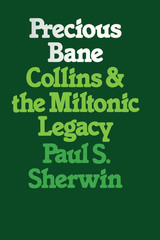 Precious Bane: Collins and the Miltonic Legacy
By Paul S. Sherwin
University of Texas Press, 1977 During his brief and sorrowful career William Collins wrote a handful of enduring poems, the most powerful and innovative verse of the Age of Sensibility. This study traces Collins' struggle to assimilate or transcend rather than to be overwhelmed by the influence of his Sublime precursor Milton. Collins' achievement is remarkably diverse, his restless experimentation a manifestation of the quest for imaginative autonomy which is the dominant impulse of all his writing. Authoritatively and eloquently, Sherwin interprets Collins' major works including the "Ode to Evening," the poem in which Milton's presence is most enriching, the "Ode on the Poetical Character," "The Passions," "Popular Superstitions Ode," and the "Ode to Fear," Collins' most haunting and painfully burdened poem. Although Harold Bloom and other prominent theorists of literary influence have recognized that Milton is the chief "daemonic" precursor of the Sensibility poets and the Romantics, Precious Bane represents the first extensive analysis of Milton's power both to daunt and emancipate an aspirant to the Sublime tradition. Bloom writes: "Paul Sherwin's Precious Bane is at once the definitive study of the poetry of William Collins and also the best informed, most critically acute book yet written upon the Miltonic influence on subsequent poetry. Sherwin's deep learning and original insights illuminate Milton and Keats quite as much as they do Collins and the other tragic poets of Sensibility. "Readers who seek rich speculation and advanced knowledge on such associated critical and historical problems as Romanticism, the Sublime mode, the agonies of poetic incarnation, and the relation of psychoanalysis to literature, will find abundant recompense in Sherwin's pages. No one in the future will teach, read or write about Collins, or the burdens of Miltonic influence, without starting from Sherwin's achievement."
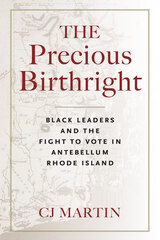 The Precious Birthright: Black Leaders and the Fight to Vote in Antebellum Rhode Island
CJ Martin
University of Massachusetts Press, 2024 In 1842, Black Rhode Islanders secured a stunning victory, a success rarely seen in antebellum America: they won the right to vote. Amid heightened public discourse around shifting ideas of race, citizenship, and political rights, they methodically deconstructed the arguments against their enfranchisement, exposing the arbitrariness of the color line in delineating citizenship rights and choosing the perfect moments in which to act forcefully. At the head of this movement, a cohort of prominent business and community members formed an early example of a Black leadership class in the US.
CJ Martin draws upon a wealth of sources—including personal correspondences, government and organizational documents, tax records, and petitions—to argue that Black leaders employed a unique combination of agitation and accommodation to ensure the success of the movement. By investigating their tactics, Martin deepens the story of how race played a crucial role in American citizenship, and by focusing on Black leadership, he relates this history through the people who lived it—who thought, debated, petitioned, and enacted their own liberation. Telling the story of a fight that was as important to the pioneers of interracial democracy as it was for the civil rights activists of the twentieth century, The Precious Birthright provides new insight into the larger story of Black freedom.
 Precious Commodity: Providing Water for America’s Cities
Martin V. Melosi
University of Pittsburgh Press, 2011
As an essential resource, water has been the object of warfare, political wrangling, and individual and corporate abuse. It has also become an object of commodification, with multinational corporations vying for water supply contracts in many countries. In Precious Commodity, Martin V. Melosi examines water resources in the United States and addresses whether access to water is an inalienable right of citizens, and if government is responsible for its distribution as a public good.
Melosi provides historical background on the construction, administration, and adaptability of water supply and wastewater systems in urban America. He cites budgetary constraints and the deterioration of existing water infrastructures as factors leading many municipalities to seriously consider the privatization of their water supply. Melosi also views the role of government in the management of, development of, and legal jurisdiction over America’s rivers and waterways for hydroelectric power, flood control, irrigation, and transportation access. Looking to the future, he compares the costs and benefits of public versus private water supply, examining the global movement toward privatization.
 Precious Fire: Maud Russell and the Chinese Revolution
Karen Garner
University of Massachusetts Press When Maud Russell (1893–1989) first sailed for China in 1917, she traveled as one of a number of "foreign secretaries" dispatched by the YWCA to do "Woman's Work for Woman." A product of the Progressive Era, she sought to bring the benefits of Christianity and Western civilization to a new generation of Chinese women struggling to find their own path to modernity in the wake of the 1911 Republican Revolution. Instead, over the next twenty-six years, Russell was herself transformed—from Christian liberal reformer to committed Marxist revolutionary. According to Karen Garner, Russell's personal political trajectory paralleled that of the YWCA in China, which evolved during the 1920s and 1930s from a Western-led, middle-class-oriented institution into a Chinese-led organization that addressed the needs of revolutionary working women. Crossing class, race, and cultural boundaries to learn from their Chinese associates, Russell and a few other western YWCA secretaries developed a shared vision of feminist social change that included support for the Chinese Communist Party and its leadership. Returning to the United States during World War II, Russell joined American liberals and leftists in promoting government cooperation with the Soviet Union and other Communist Party-led states and movements. After the war her views, including her advocacy of a "one world" Progressive Party, collided with the anticommunist imperatives of the emerging Cold War. In response, Russell adopted a defensive and dogmatic pro-communist stance from which she would never retreat. During a long and at times lonely career as a radical activist and publisher of the Far East Reporter (1952–1989), Russell was defamed and investigated by the anticommunist right and embraced by the antiwar New Left. Her notoriety as a proponent of friendship with the People's Republic of China soared during the restoration of U.S–China diplomatic relations in the 1970s, only to dissolve in the 1980s as she denounced the revival of capitalist economics in China on ideological grounds. Although Russell's own political vision may have narrowed over the years, Garner's reconstruction of her life broadens our understanding of U.S.–China relations during the twentieth century. Not only did Russell come to see her own country through the eyes of an ideological antagonist, she also brought to that vantage point the experiences of a modern American woman. As Garner shows, even if one did not agree with Russell's views, one could not deny the fervor of her commitment to gender equality, social justice, and internationalism.
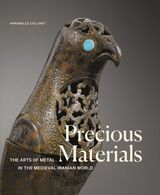 Precious Materials: The Arts of Metal in the Medieval Iranian World
Annabelle Collinet
Gingko, 2024 A historic collection of metal art from ancient Iran, featuring images of more than 150 objects described in detail and fully illustrated, some with X-rays.
Medieval metalwork is one of the artistic highlights of the Iranian world, as well as of the Département des Arts de l’Islam at the Louvre in Paris, which holds more than one hundred and fifty objects from this period. A new approach to the study of a historic collection, Precious Material: The Arts of Metal in the Medieval Iranian World is a comprehensive overview of the production of metal in medieval Iran. Although this is one of the most important collections in the world, the objects, some well-known but many more unpublished, have never been studied or published as an ensemble. This volume includes a presentation of the collection through the lens of its centers of manufacture, a full technical analysis, as well as the functions and contexts in which the pieces were used. Each object is fully described and illustrated in color with close-up or X-ray images, and many inscriptions have been translated and are included in the catalog entries.
Precious Volumes: An Introduction to Chinese Sectarian Scriptures from the Sixteenth and Seventeenth Centuries
Daniel L. Overmyer
Harvard University Press, 1999 “Precious volumes,” or pao-chüan, were produced by popular sects in the Ming and early Qing dynasties. These scriptures were believed to have been divinely revealed to sect leaders and contain teachings and ritual instructions that provide valuable information about a lively and widespread religious tradition outside mainstream Confucianism, Taoism, and Buddhism. Largely neglected until now, they testify to the imagination and devotion of popular religious leaders.
This book, the most detailed and comprehensive study of pao-chüan in any language, studies 34 early examples of this literature in order to understand the origins and development of this textual tradition. Although the work focuses on content and structure, it also treats the social context of these works as well as their transmission and ritual use.
The Precipice
Elia W. Peattie
University of Illinois Press, 1989 "One of the finest - and most unaccountably neglected - of Chicago novels by and about women. The book is strongly feminist in tone and message. . . . also a fine work of literature."--Robert Bray, A Reader's Guide to Illinois Literature
precis
José Felipe Alvergue
Omnidawn, 2017 The border is a policed realm, neoliberal market, an affective landscape of spectral echoes, a geography of traces. The death of a girl, a crossing narrative, media static of late-century rhetoric on border bodies, precis involves poetry in mapping the Mexico/US border and its relationship to America, while resisting the urge to impose definitiveness. precis simply asks: What about the body? What about the personal and the communal? The reader is asked to follow along without forgetting that overshadowed in every moment of the known, every authorization of what is, there is a print or silence asking what should also be.
Precision and Purpose: Airpower in the Libyan Civil War
Karl P. Mueller
RAND Corporation, 2015 A team of U.S. and international experts assesses the impact of various nations’ airpower efforts during the 2011 conflict in Libya, including NATO allies and non-NATO partners, and how their experiences offer guidance for future conflicts. In addition to the roles played by the United States, Britain and France, it examines the efforts of Italy, Canada, Belgium, Denmark, the Netherlands, Norway, Sweden, Qatar, the UAE, and the Libyan rebels.
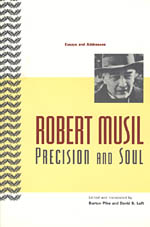 Precision and Soul: Essays and Addresses
Robert Musil
University of Chicago Press, 1990 "We do not have too much intellect and too little soul, but too little precision in matters of the soul."—Robert Musil
Best known as author of the novel The Man without Qualities, Robert Musil wrote these essays in Vienna and Berlin between 1911 and 1937. Offering a perspective on modern society and intellectual life, they are concerned with the crisis of modern culture as it manifests itself in science and mathematics, capitalism and nationalism, the changing roles of women and writers, and more. Writing to find his way in a world where moral systems everywhere were seemingly in decay, Musil strives to reconcile the ongoing conflict between functional relativism and the passionate search for ethical values.
Robert Musil was born in 1880 and died in 1942. His first novel, Young Törless, is available in English. A new two-volume translation by Burton Pike and Sophie Wilkins of The Man without Qualities is forthcoming from Alfred A. Knopf.
"Now we have these thirty-one invaluable and entertaining pieces, from an article on 'The Obscene and Pathological in Art' to the equally provocative talk 'On Stupidity,' which, with a new translation of The Man without Qualities forthcoming . . . amount to a literary event for the reader of English comparable to Constance Garnett's massive translation of Chekhov's stories."—Joseph Coates, Chicago Tribune
"Musil is one of the few great moderns, one of the handful who ventured to confront the issues that shape and define our time. . . . He has a range and a striking capacity every bit as great as that of Mann, Joyce, or Beckett."—Boston Review
"These essays are crucial in understanding a writer and critic whose lifelong task was an attempt to resolve the dichotomy between the precision of scientific form and the soul—the matter of life and art."—Choice
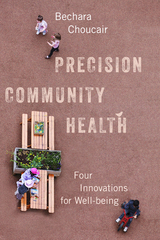 Precision Community Health: Four Innovations for Well-being
Bechara Choucair
Island Press, 2020 When Bechara Choucair was a young doctor, he learned an important lesson: treating a patient for hypothermia does little good if she has to spend the next night out in the freezing cold. As health commissioner of Chicago, he was determined to address the societal causes of disease and focus the city’s resources on its most vulnerable populations. That targeted approach has led to dramatic successes, such as lowering rates of smoking, teen pregnancy, breast cancer mortalities, and other serious ills.
In Precision Community Health, Choucair shows how those successes can be replicated and expanded around the country. The key is to use advanced technologies to identify which populations are most at risk for specific health threats and avert crises before they begin. Big data makes precision community health possible. But in our increasingly complex world, we also need new strategies for developing effective coalitions, media campaigns, and policies. This book showcases four innovations that move public health departments away from simply dispensing medical care and toward supporting communities to achieve true well-being.
The approach Choucair pioneered in Chicago requires broadening our thinking about what constitutes public health. It is not simply about access to a doctor, but access to decent housing, jobs, parks, food, and social support. It also means acknowledging that a one-size-fits-all strategy may exacerbate inequities. By focusing on those most in need, we create an agenda that is simultaneously more impactful and more achievable. The result is a wholesale change in the way public health is practiced and in the well-being of all our communities.
 Precision Medicine Oncology: A Primer
Lorna Rodriguez-Rodriguez
Rutgers University Press, 2019 Precision medicine is rapidly becoming the standard-of-care for the treatment of cancer patients. This is made possible, in part, by the ready availability and reasonable costs of comprehensive DNA and RNA sequencing assays. However, precision medicine is complex and incorporates entirely new types of data and treatment paradigms that are outside of the training of most oncologists in practice today.
Precision Medicine Oncology: A Primer is a concise review of the fundamental principles and applications of precision medicine, intended for clinicians, particularly those working in oncology. It provides an accessible introduction to the technological advances in DNA and RNA sequencing, gives a detailed overview of approaches to the interpretation of molecular test results and their point-of-care implementation for individual patients, and describes innovative clinical trial designs in oncology as well as characteristics of the computational infrastructures through which massive quantities of data are collected, stored, and used in precision medicine oncology.
Precision Radiation Oncology
Haffty, Bruce G
Rutgers University Press, 2018 Precision medicine is a rapidly-evolving field in the management of cancer. The use of novel molecular or genetic signatures in local-regional management is still in its infancy. Precision Radiation Oncology demystifies this state-of-the-art research and technology.
By describing current existing clinical and pathologic features, and focusing on the ability to improve outcomes in cancer using radiation therapy, this book discusses incorporating novel genomic- or biology-based biomarkers in the treatment of patients moving radiation oncology into precision/personalized medicine. Precision Radiation Oncology provides readers with an overview of the new developments of precision medicine in radiation oncology, further advancing the integration of new research findings into individualized radiation therapy and its clinical applications.
Preclassic Maya Pottery at Cuello, Belize
Laura J. Kosakowsky
University of Arizona Press, 1987 “Kosakowsky’s book, produced in the clear, easy-to-read and well-designed format . . . is a substantive contribution to Maya ceramic studies. She details the significant changes in the ceramic sequence and in so doing provides the kind of information that enables other ceramicists, and other Mayanists, to compare the Cuello phenomenon with developments elsewhere. Studies such as these are the building blocks of any larger-scale structural understanding of Maya cultural change.”—Journal of Latin American Studies
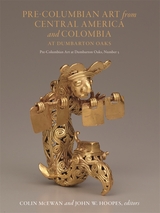 Pre-Columbian Art from Central America and Colombia at Dumbarton Oaks
Colin McEwan
Harvard University Press The final installment in the definitive series of catalogues of the Robert Woods Bliss Collection, Pre-Columbian Art from Central America and Colombia at Dumbarton Oaks examines a comprehensive and expertly curated collection of jade and gold objects from Costa Rica, Panama, and Colombia. This lavish catalogue provides over two hundred detailed and illustrated descriptions of objects that span approximately two millennia. Illustrated in detail with hundreds of high-quality photographs in full color and with stunning clarity, these breathtaking works of art reveal the ingenuity, skill, and vision of Indigenous artists and artisans.
With a dozen accompanying chapters by thirty contributors from the United States, Europe, and Latin America, this landmark publication describes the objects in the context of a history of the collection, production techniques, technical analyses, iconographic interpretations, and evaluations of material from specific archaeological sites. Pre-Columbian Art from Central America and Colombia at Dumbarton Oaks is a major watershed in the archaeology of the Isthmo-Colombian Area, representing an essential contribution to scholarship on fascinating cultures from an area located between Mesoamerica and the Andes, with ties to the Antilles and Amazonia, in the center of the Americas.
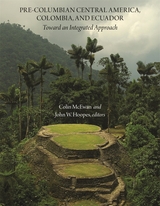 Pre-Columbian Central America, Colombia, and Ecuador: Toward an Integrated Approach
Colin McEwan
Harvard University Press Archaeologists, art historians, ethnohistorians, and ethnographers have long been captivated by the expressive material culture of the prehispanic indigenous peoples in the lands between Mesoamerica and the Andes. Interconnected communities of practice that were active from central Honduras in the north to coastal Ecuador in the south, with networks of interaction that included the Antilles and Amazonia, made this area essential for understanding long-term culture change.
Pre-Columbian Central America, Colombia, and Ecuador: Toward an Integrated Approach presents twenty chapters on current research in this central area of Latin America. Over two dozen specialists have contributed to this lavishly illustrated book, on topics ranging from historical and theoretical perspectives to analytical studies, reports on recent excavations, and evaluations of material such as ceramics, stone sculpture, gold artifacts, and ceremonial seats from various contexts in Honduras, Nicaragua, Costa Rica, Panama, Colombia, and Ecuador. Edited by Colin McEwan and John W. Hoopes, this book is an essential addition to the library of any scholar fascinated by the diverse indigenous peoples of the Americas.
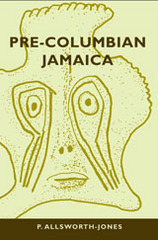 Pre-Columbian Jamaica
Phillip Allsworth-Jones
University of Alabama Press, 2008 Much of Jamaican prehistoric research—like that in the rest of the Caribbean basin—has been guided by at least a subconscious attempt to allow prehistoric native peoples to find their places within the charts established by Irving Rouse, who guided Caribbean research for much of the last half-century. The pre-Columbian peoples of Jamaica, and not merely their material culture, are beginning to take form, revealing their lifestyles and rituals, and taking their rightful place among the cultures of the New World. Pre-Columbian Jamaica represents the first substantial attempt to summarize the prehistoric evidence from the island in a single published account since J. E. Duerden’s invaluable 1897 article on the subject, which is also reprinted within this volume. The book is designed to provide general commentary that can stand alone and be read as a continuous narrative; and as an additional and valuable resource is the accompanying CD-ROM that furnishes a great range of further illustrations, data, calculations, measurements, and comparisons. This data is curated at the Archaeology Laboratory at the University of the West Indies, Mona Campus, in Kingston, and was presented to the university by Dr. James Lee in 2000. His gift, and the comprehensive study that followed, provide the impetus for both the book and the CD-ROM.
Pre-Columbian Man Finds Central America: The Archaeological Bridge
Doris Stone
Harvard University Press This presentation of the pre-contact history of Central America is an introduction and guide for visitors to the region and also illustrates hundreds of the Peabody Museum’s lesser-known holdings. Doris Stone spent decades working and traveling throughout Central America, from Guatemala to Panama. As Stephen Williams writes in his Introduction, “her numerous journeys on mule back with Sam Lothrop and other archaeologists in pursuit of elusive sites in the Central American jungles were epic.” The volume is enriched by Stone’s deep firsthand knowledge of the area and its cultural past.
Pre-Columbian Metallurgy of South America
Elizabeth P. Benson
Harvard University Press Metallurgy is an important indicator of the art of high cultures wherever it appears in Pre-Columbian South America. From Early Horizon sheet-gold disks, spoons, plaques, and ear ornaments that show Chavín deities and themes to the gold and silver walls at the temples of Cuzco, metallurgy was a site of technological innovation and development. This volume’s six papers investigate social and political implications of metallurgy, focusing on questions of the significance of metal objects in society, what they were used for, who had them, and the relationships of metalworking to the society as a whole.
Pre-Columbian Metallurgy of South America
Elizabeth P. Benson
Harvard University Press Metallurgy is an important indicator of the art of high cultures wherever it appears in Pre-Columbian South America. From Early Horizon sheet-gold disks, spoons, plaques, and ear ornaments that show Chavín deities and themes to the gold and silver walls at the temples of Cuzco, metallurgy was a site of technological innovation and development. This volume’s six papers investigate social and political implications of metallurgy, focusing on questions of the significance of metal objects in society, what they were used for, who had them, and the relationships of metalworking to the society as a whole.
Pre-Columbian Shell Engravings from the Craig Mound at Spiro, Oklahoma
Philip Phillips and James A. Brown
Harvard University Press, 1978 The Craig Mound at Spiro, Oklahoma was the richest source of pre-Columbian shell engravings in North America, a treasury of early native American artistry. From about 1250 AD until the early part of this century, it remained virtually undisturbed, but in 1933, it was plundered by commercial diggers. The fragments of the shell cups and gorgets became widely scattered, as museums and private collectors sought to acquire them. It is only through the publication of this work that the pieces have been put back together.
These lavishly illustrated volumes showcase the variety of iconography and of the engravers.
Pre-Columbian Shell Engravings from the Craig Mound at Spiro, Oklahoma
Philip Phillips and James A. Brown
Harvard University Press, 1978 The Craig Mound at Spiro, Oklahoma was the richest source of pre-Columbian shell engravings in North America, a treasury of early native American artistry. From about A.D. 1250 until the early part of this century, it remained virtually undisturbed, but in 1933, it was plundered by commercial diggers. The fragments of the shell cups and gorgets became widely scattered, as museums and private collectors sought to acquire them. It is only through the publication of this work that the pieces have been put back together and that the variety of iconography and the skill of the engravers can be appraised.
Pre-Columbian Shell Engravings from the Craig Mound at Spiro, Oklahoma: Large-Format Limited Edition Set
Philip Phillips and James A. Brown
Harvard University Press, 1975 Unequaled in North America as a single source of prehistoric figurative and decorative art, the Craig burial mound was plundered by commercial diggers in 1933. Hundreds of fragile shell artifacts covered with engraved designs were quickly sold and, whole or fragmented, were scattered in public and private collections across the country.
For the past ten years, Dr. Philip Phillips, Honorary Curator of Southeastern Archaeology at Harvard, has supervised a massive project that has involved making rubbings and line drawings of this whole corpus of Southeastern Indian art, matching hundreds of fragments, and classifying the engraved designs by schools.
Volume VI, the last volume of the set, deals with the final phase of the Craig style, then concludes with a summary of the study, a bibliography, and an extensive index.
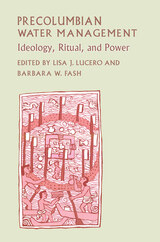 Precolumbian Water Management: Ideology, Ritual, and Power
Edited by Lisa J. Lucero and Barbara W. Fash
University of Arizona Press, 2006 Among ancient Mesoamerican and Southwestern peoples, water was as essential as maize for sustenance and was a driving force in the development of complex society. Control of water shaped the political, economic, and religious landscape of the ancient Americas, yet it is often overlooked in Precolumbian studies. Now one volume offers the latest thinking on water systems and their place within the ancient physical and mental language of the region.
Precolumbian Water Management examines water management from both economic and symbolic perspectives. Water management facilities, settlement patterns, shrines, and water-related imagery associated with civic-ceremonial and residential architecture provide evidence that water systems pervade all aspects of ancient society. Through analysis of such data, the contributors seek to combine an understanding of imagery and the religious aspects of water with its functional components, thereby presenting a unified perspective of how water was conceived, used, and represented in ancient greater Mesoamerica. The collection boasts broad chronological and geographical coverage—from the irrigation networks of Teotihuacan to the use of ritual water technology at Casas Grandes—that shows how procurement and storage systems were adapted to local conditions.
The articles consider the mechanisms that were used to build upon the sacredness of water to enhance political authority through time and space and show that water was not merely an essential natural resource but an important spiritual one as well, and that its manipulation was socially far more complex than might appear at first glance. As these papers reveal, an understanding of materials associated with water can contribute much to the ways that archaeologists study ancient cultural systems. Precolumbian Water Management underscores the importance of water management research and the need to include it in archaeological projects of all types.
A Pre-Columbian World
Jeffrey Quilter
Harvard University Press, 2006 The articles in this book conceptualize the ancient New World through new and varied approaches, from iconography to the history of anthropology. The many essays in this volume explore the vast vista of the Pre-Columbian world, including representations of history, memory, and knowledge in Andean visual imagery and Pre-Columbian narrative, the ideology of rain making, and Maya beliefs about animal transformations.
Predator Effect: Understanding the Past, Present and Future of Deceptive Academic Journals
Simon Linacre
Against the Grain, LLC, 2022 The Predator Effect concerns predatory publishing — it is the first to chart both the rise and impact of deceptive publishing. The author — a scientific communications expert with 20 years’ experience — looks at how predatory journals had become an accepted part of scholarly publishing, reviewing in turn the history, development and impact of predatory journals. The book also puts their rise in context of wider issues such as Open Access and publication ethics. Other issues it addresses include: defining predatory journals, the history of predatory publishing practices, Beall’s List, authors’ motivations and the future of predatory publishing practices.
 Predator Empire: Drone Warfare and Full Spectrum Dominance
Ian G. R. Shaw
University of Minnesota Press, 2016 What does it mean for human beings to exist in an era of dronified state violence? How can we understand the rise of robotic systems of power and domination? Focusing on U.S. drone warfare and its broader implications as no other book has to date, Predator Empire argues that we are witnessing a transition from a labor-intensive “American empire” to a machine-intensive “Predator Empire.” Moving from the Vietnam War to the War on Terror and beyond, Ian G. R. Shaw reveals how changes in military strategy, domestic policing, and state surveillance have come together to enclose our planet in a robotic system of control. The rise of drones presents a series of “existential crises,” he suggests, that are reengineering not only spaces of violence but also the character of the modern state. Positioning drone warfare as part of a much longer project to watch and enclose the human species, he shows that for decades—centuries even—human existence has slowly but surely been brought within the artificial worlds of “technological civilization.” Instead of incarcerating us in prisons or colonizing territory directly, the Predator Empire locks us inside a worldwide system of electromagnetic enclosure—in which democratic ideals give way to a system of totalitarian control, a machinic “rule by Nobody.” As accessibly written as it is theoretically ambitious, Predator Empire provides up-to-date information about U.S. drone warfare, as well as an in-depth history of the rise of drones.
 Predator upon a Flower: Life History and Fitness in a Crab Spider
Douglass H. Morse
Harvard University Press, 2007 In the crab spider, Misumena vatia, Douglass H. Morse and his colleagues found an ideal species on which to test basic questions associated with lifetime fitness. From the moment a female crab spider selects a flower on which to sit and wait for her prey, there unfolds a cascade of lifetime fitness variables that determine her evolutionary success. Did she choose a flower that attracts suitable prey? Will she encounter a competitor or predator? Will she survive long enough to breed, and will her offspring contribute to the gene pool? Ecologists had previously identified variables that shape populations, but lacked the experimental data needed to make comprehensive tests of individuals that made different foraging decisions. Morse found that Misumena is particularly well suited to both field study and laboratory experiments. Over the last 25 years, his simple yet elegant experiments have contributed to our understanding of lifetime fitness and helped to develop study techniques that can be applied to animals with other, more complex, life histories. Predator upon a Flower recounts these influential discoveries in a gracefully crafted narrative that moves ever outward from individuals to communities to ecosystems, and concludes by suggesting directions for future research in spider biology.
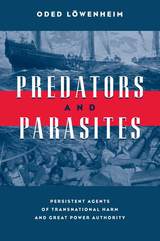 Predators and Parasites: Persistent Agents of Transnational Harm and Great Power Authority
Oded Löwenheim
University of Michigan Press, 2007 What explains variance in the policy of Great Powers toward drug traffickers, pirates, and terrorists? Does counterharm policy depend just on the degree of material harm caused to a powerful state by such nonstate actors, or do normative, moral, and emotional factors also play a role? Why did the U.S., for example, harshly punish al Qaeda after 9/11 but avoid taking similar forceful measures against foreign drug traffickers who enable the deaths of thousands of Americans each year by selling highly illegal and harmful narcotics? Oded Löwenheim argues that the answers to these questions lie in the social construction of agents of harm. "Predators and Parasites shows, with impressive scholarship, that world politics is characterized by a cartel-like structure that gives states monopolies of legitimate violence. Sovereignty and a global structure of authority are not mutually exclusive. In a sense, anarchy is in the eye of the beholder."
—Robert O. Keohane, Princeton University
"An invaluable contribution to the growing body of constructivist literature in international relations and should be read by anyone interested in the use of force in contemporary global politics . . . Goes a long way toward explaining America's War on Terror against al Qaeda and the Taliban and the widespread global support for this policy, as well as the highly negative global reaction to America's own intervention in Iraq and its norm-threatening doctrine of preemption."
—Richard W. Mansbach, Iowa State University
"Prepare to be boarded! Löwenheim delivers an essential constructivist tutorial on Great Power sovereignty and authority. An intellectual swashbuckler!"
—Rodney Bruce Hall, Oxford University
"Rejecting preventive war for moral consistency and just conduct, a fascinating discussion of pirates, terrorists, and revenge."
—Jon Mercer, University of Washington
Oded Löwenheim is Lecturer in the Department of International Relations at the Hebrew University of Jerusalem.
Predatory
Glenn Shaheen
University of Pittsburgh Press, 2011
WINNER OF THE 2010 AGNES LYNCH STARRETT POETRY PRIZE
“Glenn Shaheen is claiming new ground for American poetry. His poems are about the nightmares of information overload, collapsing infrastructure, ubiquitous violence, and other ills of late empire. The subjects are not happy, but Shaheen's clear vision and crisp—often witty—language offer the pleasures of surprise, discovery, and recognition.”
—Ed Ochester
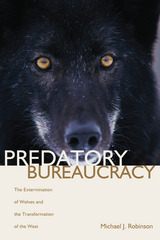 Predatory Bureaucracy: The Extermination of Wolves and the Transformation of the West
Michael Robinson
University Press of Colorado, 2005 Predatory Bureaucracy is the definitive history of America's wolves and our policies toward predators. Tracking wolves from the days of the conquistadors to the present, author Michael Robinson shows that their story merges with that of the U.S. Bureau of Biological Survey. This federal agency was chartered to research insects and birds but - because of various pressures - morphed into a political powerhouse dedicated to killing wolves and other wildlife. Robinson follows wolves' successful adaptation to the arrival of explorers, mountain men, and bounty hunters, through their disastrous century-long entanglement with the federal government. He shares the parallel story of the Biological Survey's rise, detailing the personal, social, geographic, and political forces that allowed it to thrive despite opposition from hunters, animal lovers, scientists, environmentalists, and presidents. Federal predator control nearly eliminated wolves throughout the United States and Mexico and radically changed American lands and wildlife populations. It undercut the livelihoods of countless homestead families in order to benefit an emerging western elite of livestock owners. The extermination of predators led to problems associated with prey overpopulation, but, as Robinson reveals, extermination and control programs still continue. Predatory Bureaucracy will fascinate readers interested in wildlife, ecosystems, agriculture, and environmental politics.
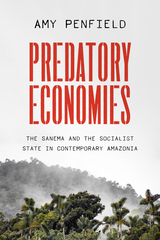 Predatory Economies: The Sanema and the Socialist State in Contemporary Amazonia
Amy Penfield
University of Texas Press, 2023 2024 Honorable Mention, Fernando Coronil Prize, Latin American Studies Association, Section on Venezuelan Studies A study of the modes of predation used by and against the Sanema people of Venezuela.
Predation is central to the cosmology and lifeways of the Sanema-speaking Indigenous people of Venezuelan Amazonia, but it also marks their experience of modernity under the socialist “Bolivarian” regime and its immense oil wealth. Yet predation is not simply violence and plunder. For Sanema people, it means a great deal more: enticement, seduction, persuasion. It suggests an imminent threat but also opportunity and even sanctuary. Amy Penfield spent two and a half years in the field, living with and learning from Sanema communities. She discovered that while predation is what we think it is—invading enemies, incursions by gold miners, and unscrupulous state interventions—Sanema are not merely prey. Predation, or appropriation without reciprocity, is essential to their own activities. They use predatory techniques of trickery in hunting and shamanism activities, while at the same time, they employ tactics of manipulation to obtain resources from neighbors and from the state. A richly detailed ethnography, Predatory Economies looks beyond well-worn tropes of activism and resistance to tell a new story of agency from an Indigenous perspective.
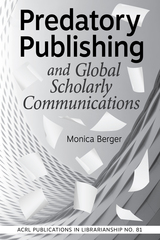 Predatory Publishing and Global Scholarly Communications
Monica Berger
Association of College & Research Libraries, 2024 Predatory publishing is a complex problem that harms a broad array of stakeholders and concerns across the scholarly communications system. It shines a light on the inadequacies of scholarly assessment and related rewards systems, contributes to the marginalization of scholarship from less developed countries, and negatively impacts the acceptance of open access. To fix what is broken in scholarly communications, academic librarians must act as both teachers and advocates and partner with other stakeholders who have the agency to change how scholarship is produced, assessed, and rewarded. Predatory Publishing and Global Scholarly Communications is a unique and comprehensive exploration of predatory publishing in four parts. - Background
- Characteristics and Research
- The Geopolitics of Scholarly Publishing
- Responses and Solutions
It examines the history of predatory publishing and basics of scholarly assessment; identifies types of research misconduct and unethical scholarly behaviors; provides critical context to predatory publishing and scholarly communications beyond the Global North; and offers structural and pedagogical solutions and teaching materials for librarians to use in their work with authors, students, faculty, and other stakeholders. Predatory Publishing and Global Scholarly Communications gives powerful insight into predatory publishing across the world, inside and outside of the library community, and provides tools for understanding and teaching its impact and contributing to its improvement.
 Predatory Welfare: Debt, Race, and Cash Transfers
Erin Torkelson
Duke University Press, 2026 In Predatory Welfare, Erin Torkelson explores how the direct cash transfer program instituted in South Africa revised and reworked post-apartheid racialized and gendered dispossession, despite its promise of ameliorating extreme poverty. Beginning in 2012, she focuses on how poor Black South African women assert their entitlements to social assistance and responsibilities to familial care against the pressures of expropriation built into the grant payment system. Because the grants did not cover monthly bills, recipients were pushed into predatory loans collateralized by welfare packages. Torkelson finds that the state-sponsored but privately-run program was fundamentally undermined by its reliance on digital financial technologies which encoded wider forces of colonial rule, nationalist politics, and global development. Even when the government assumed control of grant payment in 2018, the neoliberal bent of fiscal policy continued to drive recipients into debt in new ways. Drawing on seven years of ethnographic fieldwork and organization—in grant payment queues, loan offices, grocery stores, Parliament, and the Constitutional Court—Torkelson demonstrates how cash transfers can offer a means to making racial capitalism more acceptable and how recipients can push back to demand reparation.
Predecessors, Et Cetera: Essays
Amy Clampitt
University of Michigan Press, 1991 Predecessors, Et Cetera collects Amy Clampitt’s reflections on her predecessors (the poets Donne, Wordsworth, Dickinson, Frost, Eliot, and Marianne Moore as well as the novelists Henry James and Edith Wharton) and her contemporaries (including James Merrill, Anthony Hecht, Howard Moss, Thomas McGrath, John Berryman, Stevie Smith, and Seamus Heaney) and reveals the intricate connections inherent in their art. Other essays include “Purloined Sincerity,” which examines the fate of the personal letter in these days of electronic communication, and “The Long, Long Wait,” which looks at the epistles of St. Paul to the Thessalonians. Along the way she offers ruminations on the poet’s craft, the vagaries of reputation, and the perennial question of what makes a poet – or any writer – tick.
Pre-Deployment Stress, Mental Health, and Help-Seeking Behaviors Among Marines
Carrie M. Farmer
RAND Corporation, 2014 As part of an evaluation of the Marine Corps Operational Stress Control and Readiness (OSCAR) program, this report describes the methods and findings of a large survey of marines who were preparing for a deployment to Iraq or Afghanistan in 2010 or 2011. The results are among the first to shed light on the pre-deployment mental health status of marines, as well as the social resources they draw on when coping with stress and their attitudes about seeking help for stress-related problems.
The Predestination of Humans: Augustinus, Tome III, Book IX
Cornelius Jansen
Catholic University of America Press, 2022 No other theological text polarized the early modern Catholic world as much as Cornelius Jansen's Augustinus. In it the erudite bishop not only reconstructed St. Augustine's teaching on grace and free will, but also boldly claimed that his views were in line with the Council of Trent and the Society of Jesus. For Jansen the latter had marginalized the Church Father's doctrine on divine predestination by overemphasizing human free will. Published after his death in 1640, Jansen's work drew a large crowd of followers and inspired an Augustinian reform movement. Its papal condemnation unintentionally spread this theology, but stifled an impassionate, academic engagement with the Augustinus. This first-ever translation of some of its central chapters enables historians, philosophers and theologians to finally engage with the founding text of Jansenism.
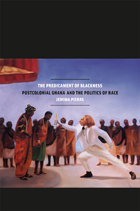 The Predicament of Blackness: Postcolonial Ghana and the Politics of Race
Jemima Pierre
University of Chicago Press, 2012 What is the meaning of blackness in Africa? While much has been written on Africa’s complex ethnic and tribal relationships, Jemima Pierre’s groundbreaking The Predicament of Blackness is the first book to tackle the question of race in West Africa through its postcolonial manifestations. Challenging the view of the African continent as a nonracialized space—as a fixed historic source for the African diaspora—she envisions Africa, and in particular the nation of Ghana, as a place whose local relationships are deeply informed by global structures of race, economics, and politics. Against the backdrop of Ghana’s history as a major port in the transatlantic slave trade and the subsequent and disruptive forces of colonialism and postcolonialism, Pierre examines key facets of contemporary Ghanaian society, from the pervasive significance of “whiteness” to the practice of chemical skin-bleaching to the government’s active promotion of Pan-African “heritage tourism.” Drawing these and other examples together, she shows that race and racism have not only persisted in Ghana after colonialism, but also that the beliefs and practices of this modern society all occur within a global racial hierarchy. In doing so, she provides a powerful articulation of race on the continent and a new way of understanding contemporary Africa—and the modern African diaspora.
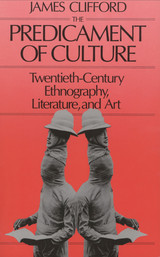 The Predicament of Culture: Twentieth-Century Ethnography, Literature, and Art
James Clifford
Harvard University Press, 1988 The Predicament of Culture is a critical ethnography of the West in its changing relations with other societies. Analyzing cultural practices such as anthropology, travel writing, collecting, and museum displays of tribal art, James Clifford shows authoritative accounts of other ways of life to be contingent fictions, now actively contested in post-colonial contexts. His critique raises questions of global significance: Who has the authority to speak for any group’s identity and authenticity? What are the essential elements and boundaries of a culture? How do self and “the other” clash in the encounters of ethnography, travel, and modern interethnic relations?
In chapters devoted to the history of anthropology, Clifford discusses the work of Malinowski, Mead, Griaule, Lévi-Strauss, Turner, Geertz, and other influential scholars. He also explores the affinity of ethnography with avant-garde art and writing, recovering a subversive, self-reflexive cultural criticism. The surrealists’ encounters with Paris or New York, the work of Georges Bataille and Michel Leiris in the Collège de Sociologie, and the hybrid constructions of recent tribal artists offer provocative ethnographic examples that challenge familiar notions of difference and identity. In an emerging global modernity, the exotic is unexpectedly nearby, the familiar strangely distanced.
The Predicaments of Publicness: An Inquiry into the Conceptual Ambiguity of Public Administration
Udo Pesch
Eburon Academic Publishers, 2006 As governmental goods and resources continue to undergo privatization, many wonder just what is “public” about public administration. The Predicaments of Publicness traces the development of this dilemma in modern political and social thought and then applies those theoretical findings to some of the most relevant practical issues in current public administration. Some organizations, Pesch asserts, remain outside of the public/private schism, and The Predicaments of Publicness will provide readers—both citizens and civil servants—with essential guideposts for negotiating these new arenas.
Predicative Constructions: From the Fregean to a Montagovian Treatment
Frank Van Eynde
CSLI, 2015 There are multitudes of ways in which predicative constructions can be analyzed. In this book, Frank Van Eynde differentiates between the Fregean and Montagovian treatments of these constructions in order to better understand predicative constructions as a grammatical model. Although he focuses his arguments on English and Dutch, Van Eynde also includes analyses of other Indo-European and non-Indo-European languages in order to better explore phenomena that do not occur in the two primary languages of his study.
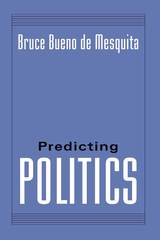 PREDICTING POLITICS
Bruce Bueno de Mesquita
Ohio State University Press, 2002 To predict likely policy developments around the world over the next thirty years, Bruce Bueno de Mesquita uses game theoretic models as described in Predicting Politics. The tools used in this book have found wide application in business and in the development of significant American foreign policy initiatives over the years. The author uses data from 1948 to show the ability of models to predict the end of the Cold War. He then turns to data from 1980 for about one hundred countries and simulates future states of the world, especially with regard to further democratization. In the process he shows strong evidence that the burst of democratization that occurred at the end of the 1980s and the beginning of the 1990s was predictable based on replicable data known in 1980. While delving into rather gloomy predictions about likely developments in Russia and China’s domestic affairs, he offers a novel explanation for the failure of Russia to attract more investment and to achieve the higher growth rates commonly associated with democratic government. Although Russia is certainly more democratic in an absolute sense today than it was in 1980, it has fallen farther behind the rest of the world in terms of democratization and so lacks the comparative advantages of property rights, rule of law, and transparent governance that are essential for attracting investment. Bueno de Mesquita shows how policy situations and game theoretical analyses can explain the past, illuminate the present and forecast future events. At the same time he provides the tools necessary for others to create their own rigorous estimates of future foreign policies.
Predicting Politics: Essays in Empirical Public Choice
W. Mark Crain and Robert D. Tollison, Editors
University of Michigan Press, 1990 Predicting Politics: Essays in Empirical Public Choice explores politics in an empirical spirit. The topics covered are novel and important, including the impact of campaign finance on the size of government, the economics of gerrymandering, constitutional change, and budgetary politics. The approach is to formulate and to test interesting hypotheses about political behavior. The essential idea is to illustrate the power of public choice theory in explaining actual politics.The volume brings together the work of Crain and Tollison and other scholars who have worked in this public choice tradition, and shows the power of empirical approaches in explaining the origin and inner working of political institutions and processes.
 Predicting Species Occurrences: Issues of Accuracy and Scale
Edited by J. Michael Scott, Patricia J. Heglund, and Michael L. Morrison; Foreword by Peter H. Raven
Island Press, 2002 Predictions about where different species are, where they are not, and how they move across a landscape or respond to human activities -- if timber is harvested, for instance, or stream flow altered -- are important aspects of the work of wildlife biologists, land managers, and the agencies and policymakers that govern natural resources. Despite the increased use and importance of model predictions, these predictions are seldom tested and have unknown levels of accuracy.Predicting Species Occurrences addresses those concerns, highlighting for managers and researchers the strengths and weaknesses of current approaches, as well as the magnitude of the research required to improve or test predictions of currently used models. The book is an outgrowth of an international symposium held in October 1999 that brought together scientists and researchers at the forefront of efforts to process information about species at different spatial and temporal scales. It is a comprehensive reference that offers an exhaustive treatment of the subject, with 65 chapters by leading experts from around the world that: review the history of the theory and practice of modeling and present a standard terminology examine temporal and spatial scales in terms of their influence on patterns and processes of species distribution offer detailed discussions of state-of-the-art modeling tools and descriptions of methods for assessing model accuracy discuss how to predict species presence and abundance present examples of how spatially explicit data on demographics can provide important information for managers An introductory chapter by Michael A. Huston examines the ecological context in which predictions of species occurrences are made, and a concluding chapter by John A. Wiens offers an insightful review and synthesis of the topics examined along with guidance for future directions and cautions regarding misuse of models. Other contributors include Michael P. Austin, Barry R. Noon, Alan H. Fielding, Michael Goodchild, Brian A. Maurer, John T. Rotenberry, Paul Angermeier, Pierre R. Vernier, and more than a hundred others.Predicting Species Occurrences offers important new information about many of the topics raised in the seminal volume Wildlife 2000 (University of Wisconsin Press, 1986) and will be the standard reference on this subject for years to come. Its state-of-the-art assessment will play a key role in guiding the continued development and application of tools for making accurate predictions and is an indispensable volume for anyone engaged in species management or conservation.
Predicting the Past in the Ancient Near East: Mantic Historiography in Ancient Mesopotamia, Judah, and the Mediterranean World
Matthew Neujahr
SBL Press, 2012 This work provides an in-depth investigation of after-the-fact predictions in ancient Near Eastern texts from roughly 1200 B.C.E.–70 C.E. It argues that the Akkadian, Aramaic, Hebrew, and Greek works discussed are all part of a developing scribal discourse of “mantic historiography” by which scribes blend their local traditions of history writing and predictive texts to produce a new mode of historiographic expression. This in turn calls into question the use and usefulness of traditional literary categories such as “apocalypse” to analyze such works.
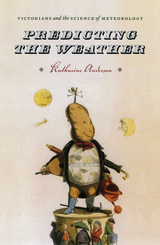 Predicting the Weather: Victorians and the Science of Meteorology
Katharine Anderson
University of Chicago Press, 2005 Victorian Britain, with its maritime economy and strong links between government and scientific enterprises, founded an office to collect meteorological statistics in 1854 in an effort to foster a modern science of the weather. But as the office turned to prediction rather than data collection, the fragile science became a public spectacle, with its forecasts open to daily scrutiny in the newspapers. And meteorology came to assume a pivotal role in debates about the responsibility of scientists and the authority of science.
Studying meteorology as a means to examine the historical identity of prediction, Katharine Anderson offers here an engrossing account of forecasting that analyzes scientific practice and ideas about evidence, the organization of science in public life, and the articulation of scientific values in Victorian culture. In Predicting the Weather, Anderson grapples with fundamental questions about the function, intelligibility, and boundaries of scientific work while exposing the public expectations that shaped the practice of science during this period.
A cogent analysis of the remarkable history of weather forecasting in Victorian Britain, Predicting the Weather will be essential reading for scholars interested in the public dimensions of science.
 Prediction and Regulation by Linear Least-Square Methods
Peter Whittle
University of Minnesota Press, 1963 Prediction and Regulation by Linear Least-Square Methods was first published in 1963. This revised second edition was issued in 1983. Minnesota Archive Editions uses digital technology to make long-unavailable books once again accessible, and are published unaltered from the original University of Minnesota Press editions.During the past two decades, statistical theories of prediction and control have assumed an increasing importance in all fields of scientific research. To understand a phenomenon is to be able to predict it and to influence it in predictable ways. First published in 1963 and long out of print, Prediction and Regulation by Linear Least-Square Methods offers important tools for constructing models of dynamic phenomena. This elegantly written book has been a basic reference for researchers in many applied sciences who seek practical information about the representation and manipulation of stationary stochastic processes. Peter Whittle’s text has a devoted group of readers and users, especially among economists. This edition contains the unchanged text of the original and adds new works by the author and a foreword by economist Thomas J. Sargent.
 Prediction: Science, Decision Making, and the Future of Nature
Edited by Daniel Sarewitz, Roger A. Pielke Jr., and Radford Byerly Jr.
Island Press, 2000 The idea that predictive science can simplify the decision-making process by creating a clearer picture of the future is deeply appealing in principle, but deeply problematic in practice.
Prediction offers a fascinating and wide-ranging look at the interdependent scientific, political, and social factors involved in using science-based predictions to guide policy making. Through ten detailed case studies, it explores society's efforts to generate reliable scientific information about complex natural systems and to use that information in making sound policy decisions. The book: - provides an overview of predictive science from historical, scientific, political, and behavioral perspectives offers case studies of the use and misuse of scientific predictions on subjects ranging from asteroids to nuclear waste disposal
- proposes a practical analytical framework for the use of predictive science in setting policy
- recommends actions and policies that can increase the likelihood of effective decisions
Contributors include Clark Chapman, Charles Herrick, William H. Hooke, Orrin Pilkey, Steve Rayner, Naomi Oreskes, Daniel Metlay, Stanley Changnon, Donald Gautier, Robert Moran, Joanne Nigg, and Thomas Stewart. Prediction is the first book to look at the numerous and varied scientific, social, and political factors involved in making and using predictions relevant to a wide range of current environmental controversies and challenges. It provides much-needed context for understanding predictions and scientific pronouncements, and is an important work for anyone concerned with interactions between science and policy making.
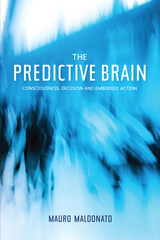 The Predictive Brain: Consciousness, Decision and Embodied Action
Mauro Maldonato
Sussex Academic Press, 2022 During the lengthy and complex process of human evolution our ancestors had to adapt to testing situations in which survival depended on making rapid choices that subjected muscles and body to extreme tension. In order to seize a prey travelling at 36 km per hour Homo sapiens had just thousandths of a second in which to prepare the appropriate gesture. While we are no longer faced with such an environment, our brain continues to use the adaptive mechanisms, enabling us to avoid danger and sense interlocutor intentions. This book sets out to show that our brain is not only a reactive mechanism, reacting to external stimuli, but is pro-active -- allowing us to make hypotheses, anticipate consequences, and formulate expectations: in short, to wrong foot an adversary. The body and its movements are at the origin of all abstract modes of behaviour, starting from language. The evolution of motor modes of behaviour (e.g the ability to construct and manipulate instruments) has given rise to an "embodied logic" underpinning not only action and prediction but also gestures and syllable sequences that are the basis of human communication. Some motor experiences have progressively moulded the nervous infrastructures and led to the development of symbols/metaphors used in language, coming to serve as classes of perceptions, behavioural patterns and universal linguistic conventions. Whether shaking some- one's hand or writing a letter, each executive function -- controlled by nervous structures and mental procedures that process the information -- requires behaviours that are oriented to a specific end. The executive functions imply planning/selecting an action; the process is linked to an embodied cognition supported by consciousness. If consciousness is caused by specific neuronal processes and, therefore, conscious states are causally reducible to neurobiological processes, it is also true that conscious states exist at a higher level than neuron activity. For this reason it is necessary to go beyond a hierarchical idea of levels of consciousness, and to refute the idea according to which the 'mental' sphere is qualitative, subjective, and in the 'first person', while the 'physical' sphere is quantitative, objective and in the 'third person'.
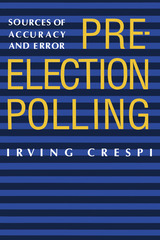 Pre-Election Polling: Sources of Accuracy and Error
Irving Crespi
Russell Sage Foundation, 1988 Since 1948, when pollsters unanimously forecast a Dewey victory over Truman, media-sponsored polls have proliferated, accompanied by a growing unease about their accuracy. Pre-Election Polling probes the results of over 430 recent polls and taps the professional "lore" of experienced pollsters to offer a major new assessment of polling practices in the 1980s. In a study of unusual scope and depth, Crespi examines the accuracy of polls conducted before a range of elections, from presidential to local. He incorporates the previously unpublished observations and reflections of pollsters representing national organizations (including Gallup, Roper, and the CBS/New York Times Poll) as well as pollsters from state, academic, and private organizations. Crespi finds potential sources of polling error in such areas as sampling, question wording, anticipating turnout, and accounting for last-minute changes in preference. To these methodological correlates of accuracy he adds important political considerations—is it a primary or general election; what office is being contested; how well known are the candidates; how crystallized are voter attitudes? Polls have become a vital feature of our political process; by exploring their strengths and weaknesses, Pre-Election Polling enhances our ability to predict and understand the complexities of voting behavior. "Combines intelligent empirical analysis with an informed insider's interpretation of the dynamics of the survey research process....Should be studied not only by all practitioners and students of opinion research but by anyone who makes use of polls." —Leo Bogart, Newspaper Advertising Bureau, Inc.
A Preface to Democratic Theory
Robert A. Dahl
University of Chicago Press, 1963 A Preface to Democratic Theory explores some problems left unsolved by traditional democratic theory, Professor Dahl examines two influential "model" theories—the Madisonian, representing the prevailing American doctrine, and its recurring challenger, the populistic theory—and argues that they no longer explain how modern democracies operate. He then constructs a model more consistent with modern political science, and, in doing so, develops some unique views of popular sovereignty and the American constitutional system.
"A Preface to Democratic Theory is well worth the devoted attention of anyone who cares about democracy. For it will have an important influence on both theory about democracy and on actual practice in democracies round the world."—Bernard Barber, Political Science Quarterly
"The book is a must for democratic theorists."—J. Roland Pennock, Journal of Politics
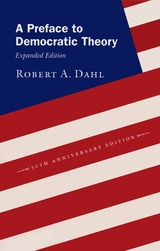 A Preface to Democratic Theory, Expanded Edition
Robert A. Dahl
University of Chicago Press, 2006 Robert Dahl’s Preface helped launch democratic theory fifty years ago as a new area of study in political science, and it remains the standard introduction to the field. Exploring problems that had been left unsolved by traditional thought on democracy, Dahl here examines two influential models—the Madisonian, which represents prevailing American doctrine, and its recurring challenger, populist theory—arguing that they do not accurately portray how modern democracies operate. He then constructs a model more consistent with how contemporary democracies actually function, and, in doing so, develops some original views of popular sovereignty and the American constitutional system.
For this fiftieth-anniversary edition, Dahl has written an extensive new afterword that reevaluates Madisonian theory in light of recent research. And in a new foreword, he reflects back on his influential volume and the ways his views have evolved since he wrote it. For any student or scholar of political science, this new material is an essential update on a gold standard in the evolving field of democratic theory.
“A Preface to Democratic Theory is well worth the devoted attention of anyone who cares about democracy.”—Political Science Quarterly
Preface to Modernism
Art Berman
University of Illinois Press, 1994 Traces the conceptual lineage of modernism, examining its evolution in Western art and
literature through empiricism, idealism, and romanticism. Berman demonstrates how
modern social, political, and scientific developments -- including capitalism, socialism,
humanism, psychoanalysis, fascism, and modernism itself -- have altered attitudes toward
time, space, self, creativity, the natural world, and community. "Deserves careful study."
-- Choice
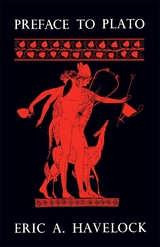 Preface to Plato
Eric Havelock
Harvard University Press, 1963 Plato’s frontal attack on poetry has always been a problem for sympathetic students, who have often minimized or avoided it. Beginning with the premise that the attack must be taken seriously, Eric Havelock shows that Plato’s hostility is explained by the continued domination of the poetic tradition in contemporary Greek thought.
The reason for the dominance of this tradition was technological. In a nonliterate culture, stored experience necessary to cultural stability had to be preserved as poetry in order to be memorized. Plato attacks poets, particularly Homer, as the sole source of Greek moral and technical instruction—Mr. Havelock shows how the Iliad acted as an oral encyclopedia. Under the label of mimesis, Plato condemns the poetic process of emotional identification and the necessity of presenting content as a series of specific images in a continued narrative.
The second part of the book discusses the Platonic Forms as an aspect of an increasingly rational culture. Literate Greece demanded, instead of poetic discourse, a vocabulary and a sentence structure both abstract and explicit in which experience could be described normatively and analytically: in short a language of ethics and science.
Preface to the Presidency: Selected Speeches of Bill Clinton 1974-1992
Stephen Smith
University of Arkansas Press, 1996 Bill Clinton has long been touted as a master of public speaking form and political discourse. Taken from his speeches as a twenty-seven-year-old candidate for Congress though his 1992 victory speech, Preface to the Presidency reveals the power and range of his contribution to our nation's political dialogue.
|
|

